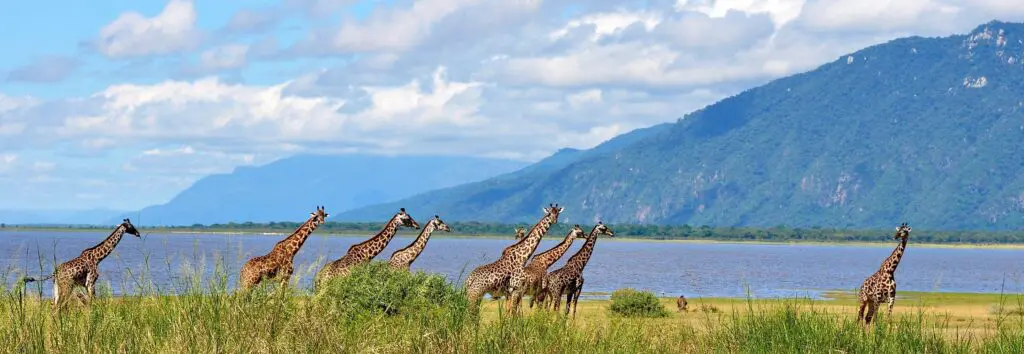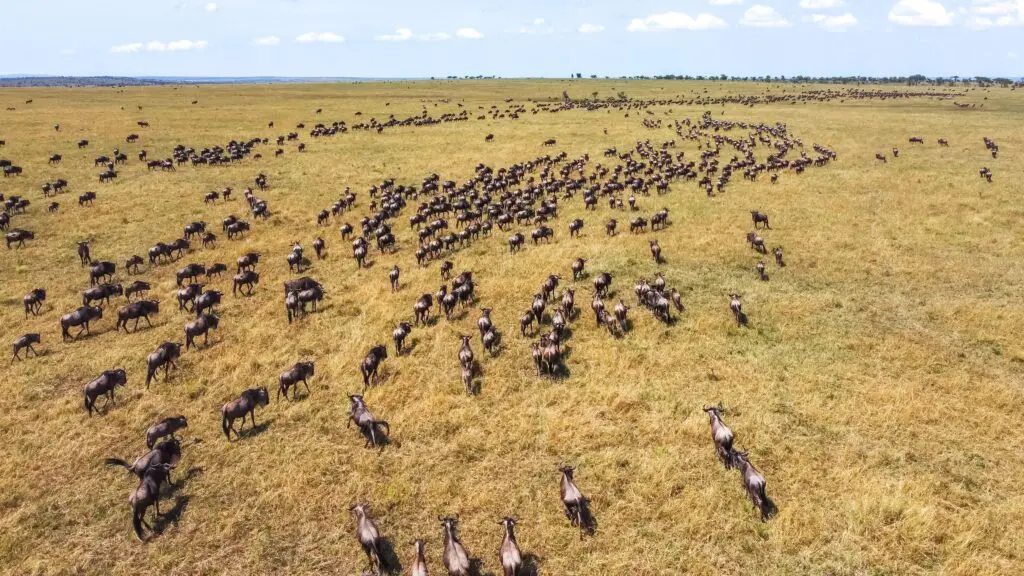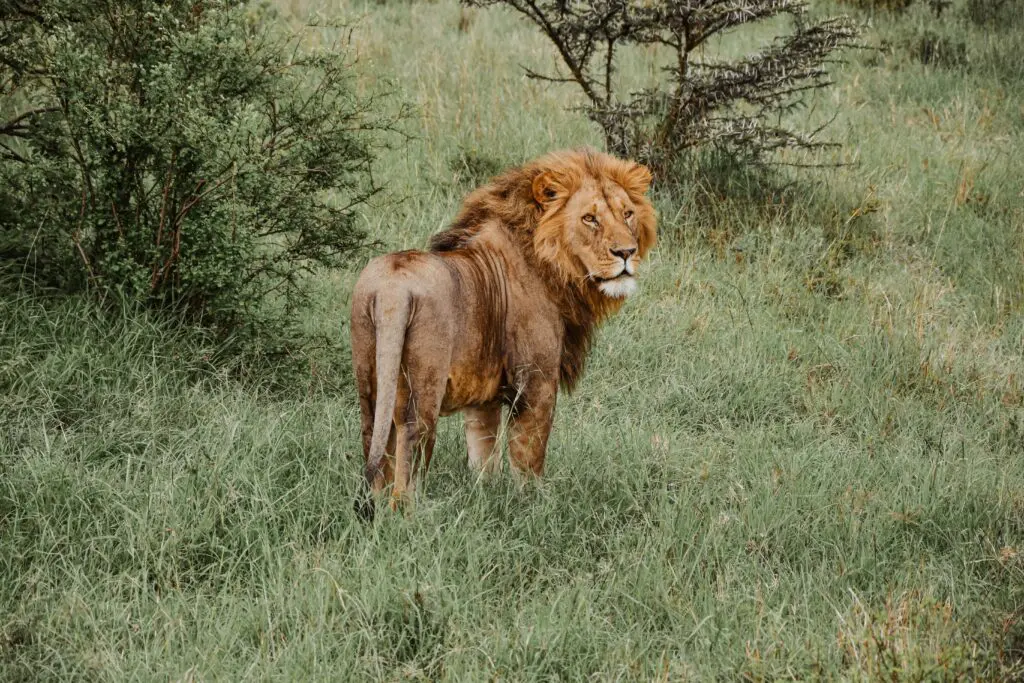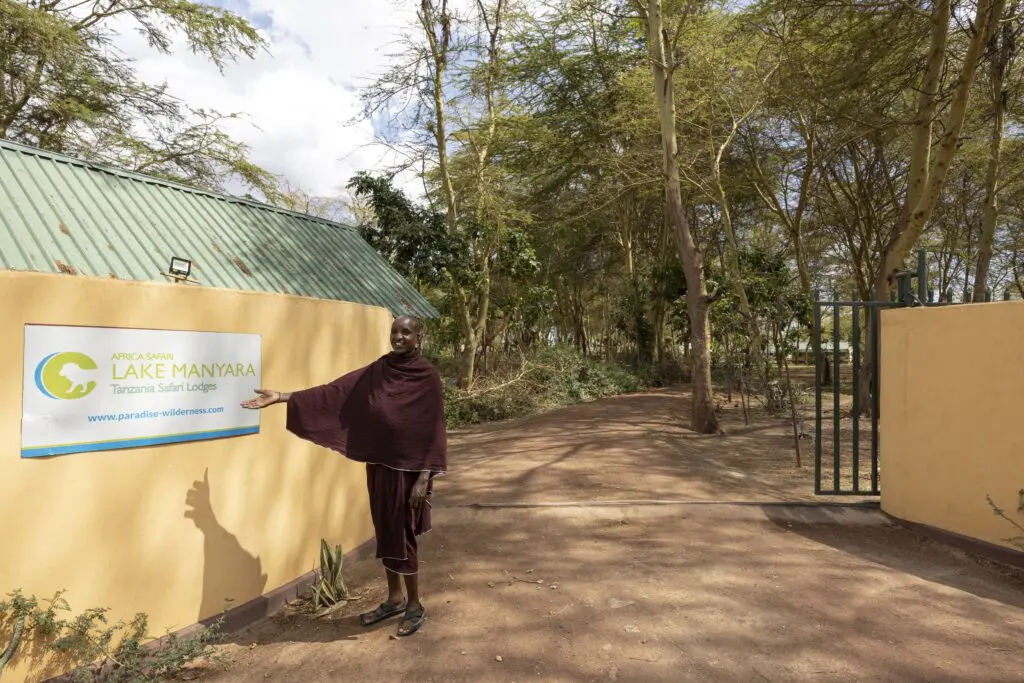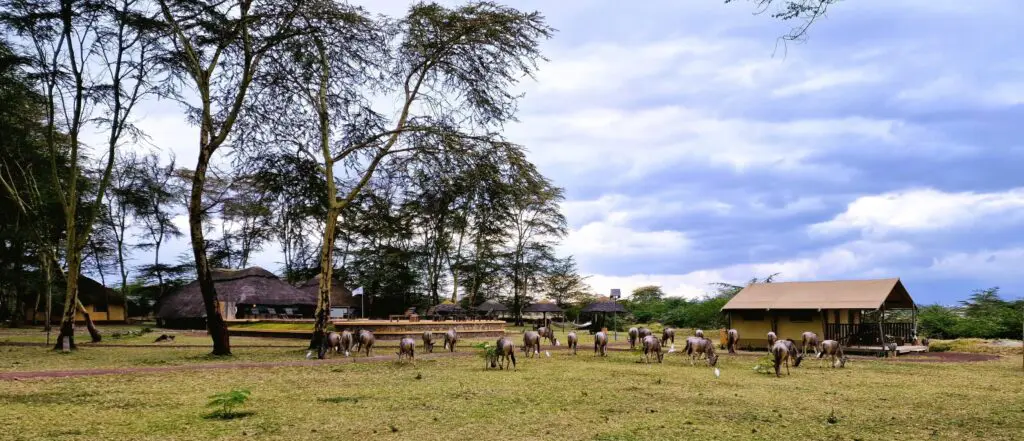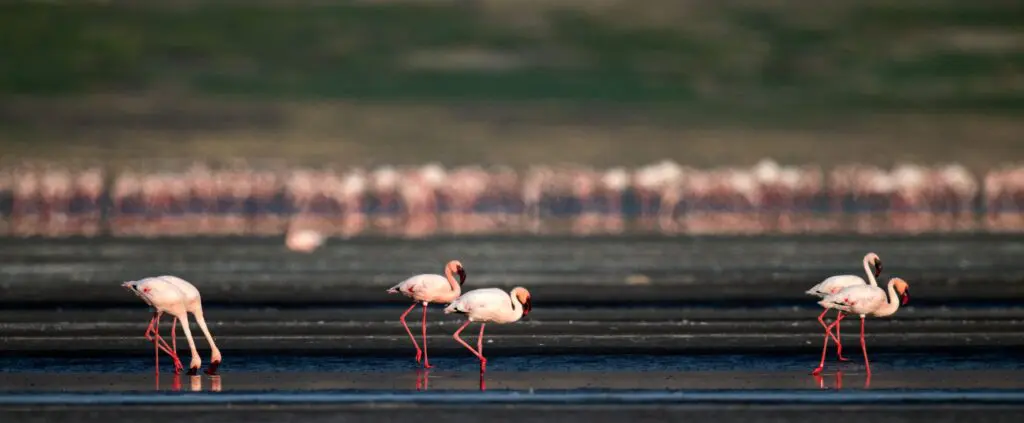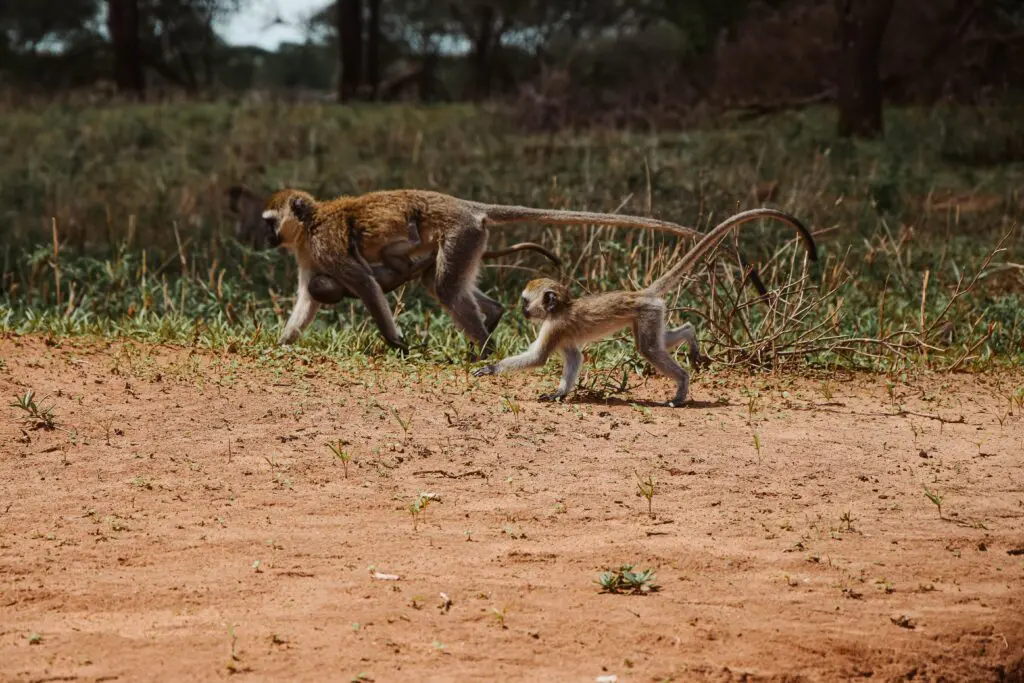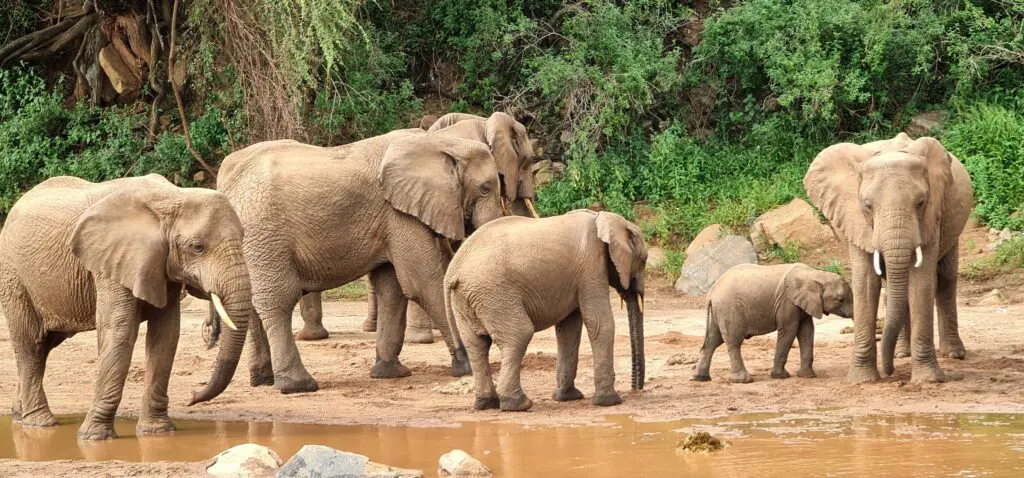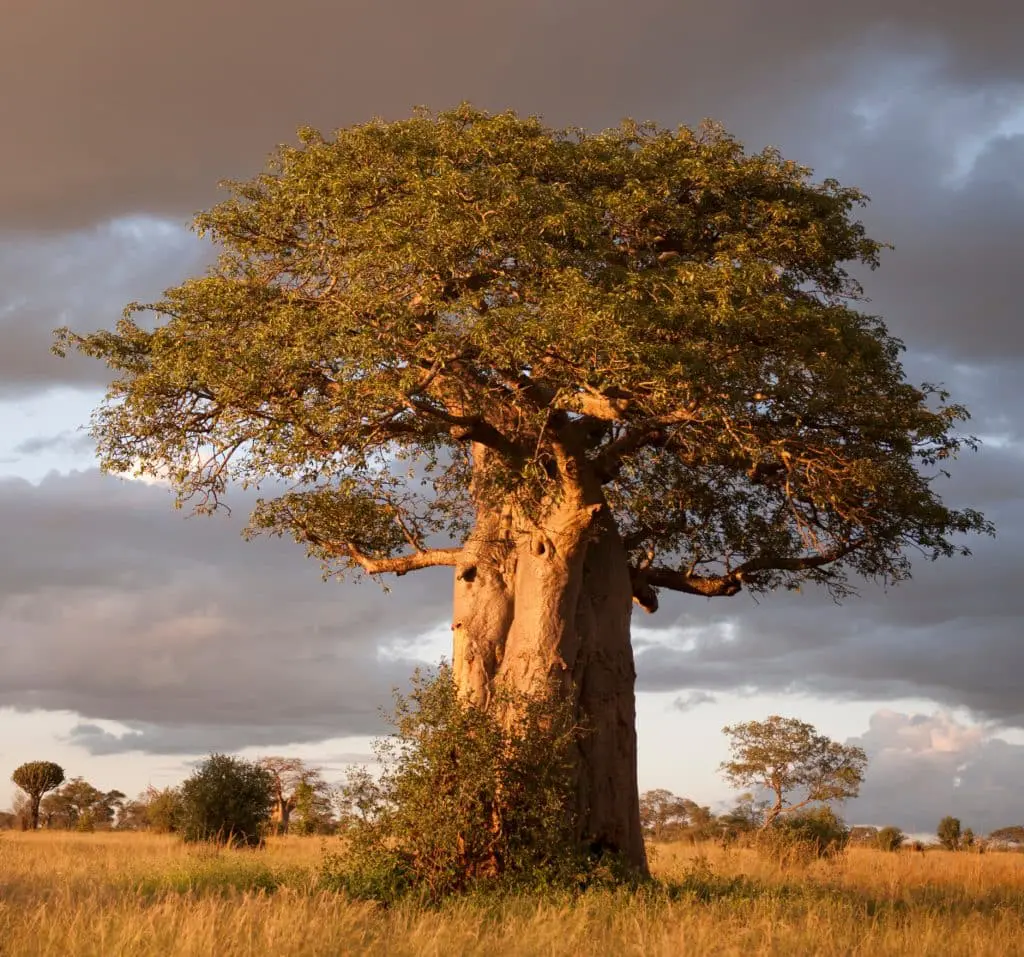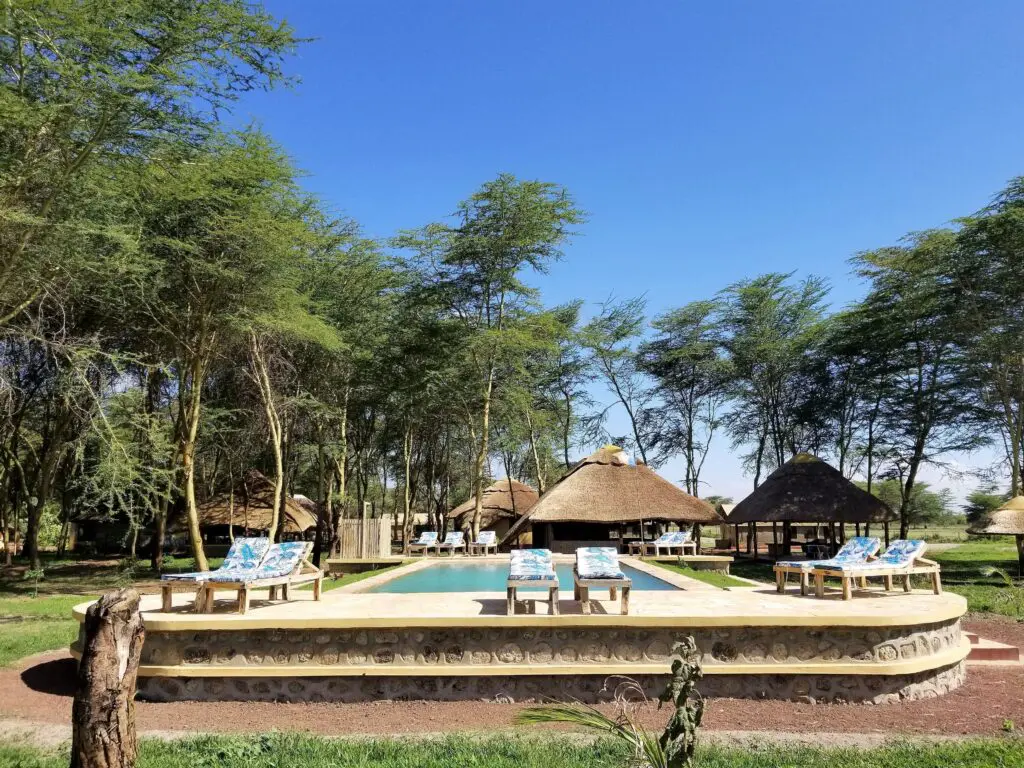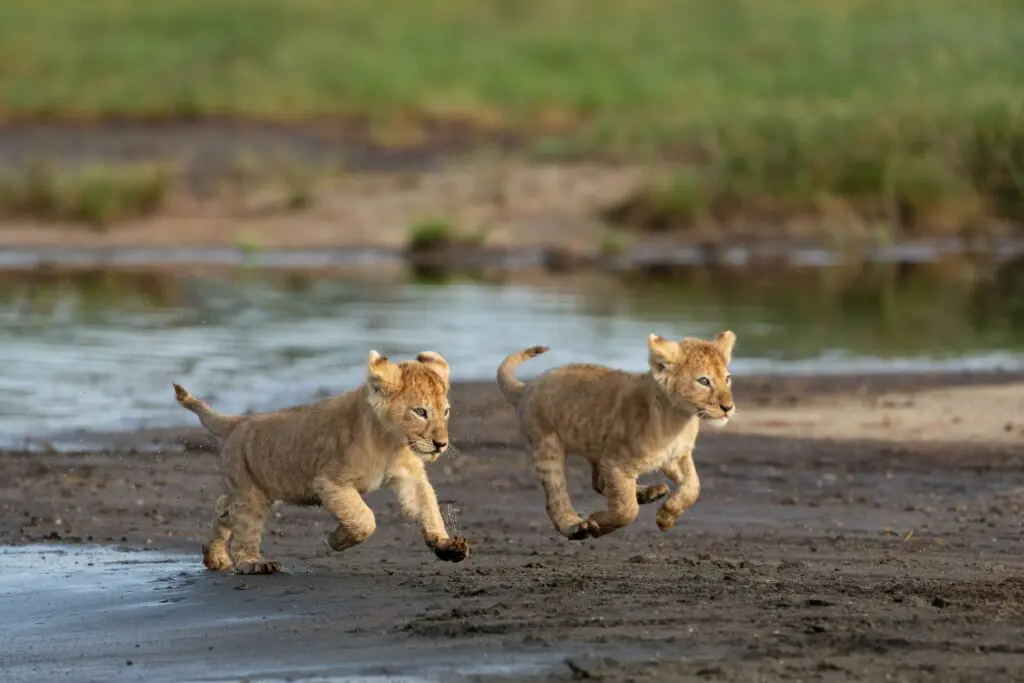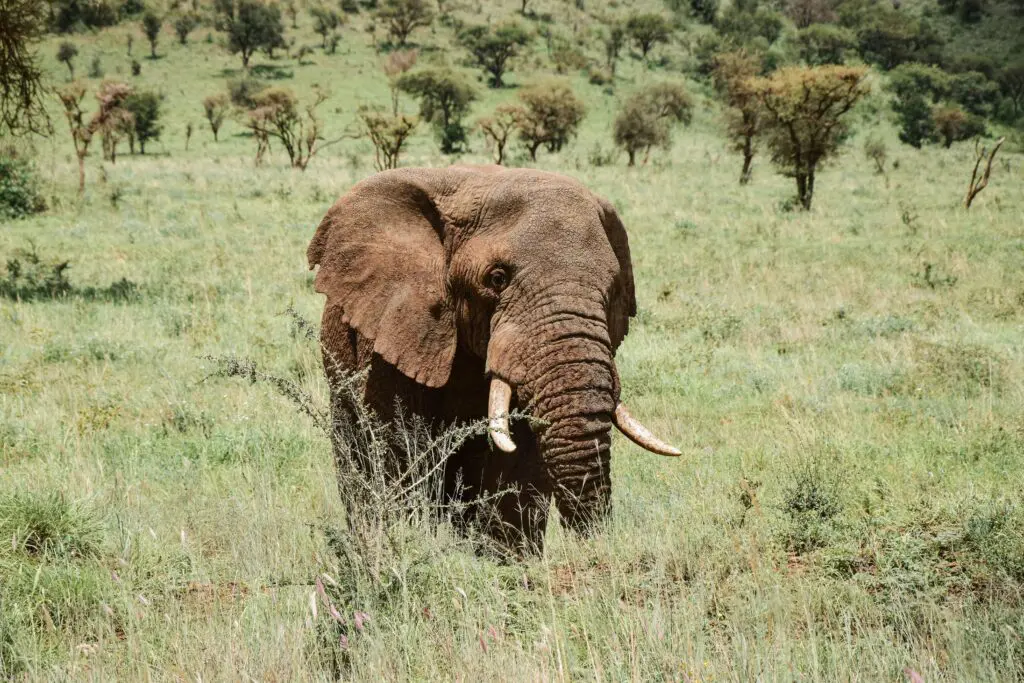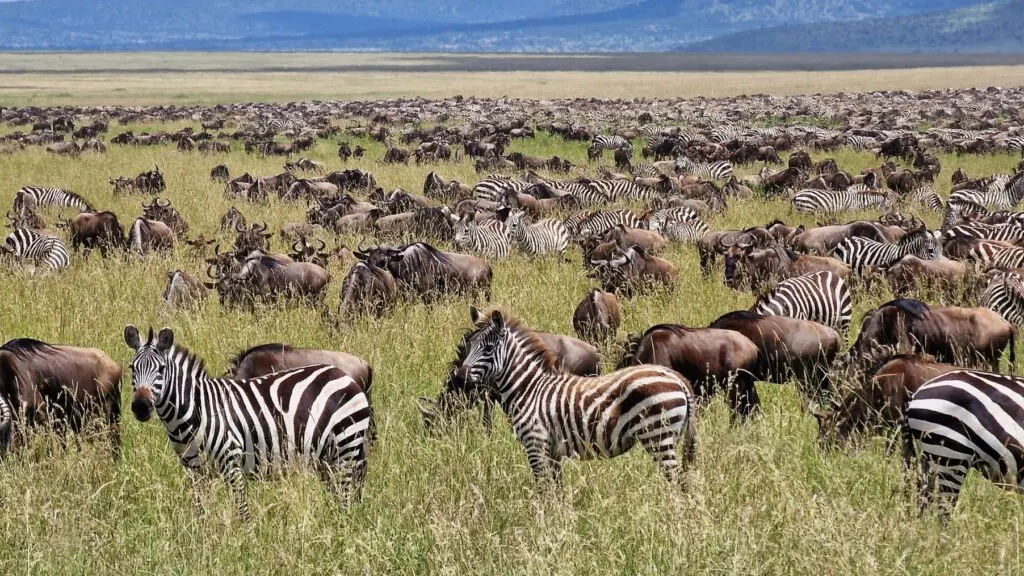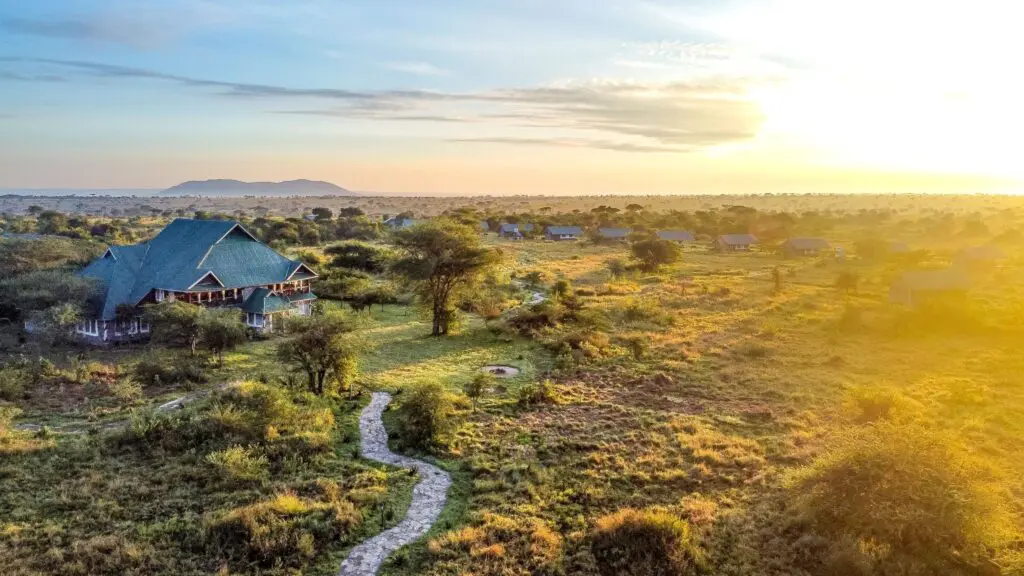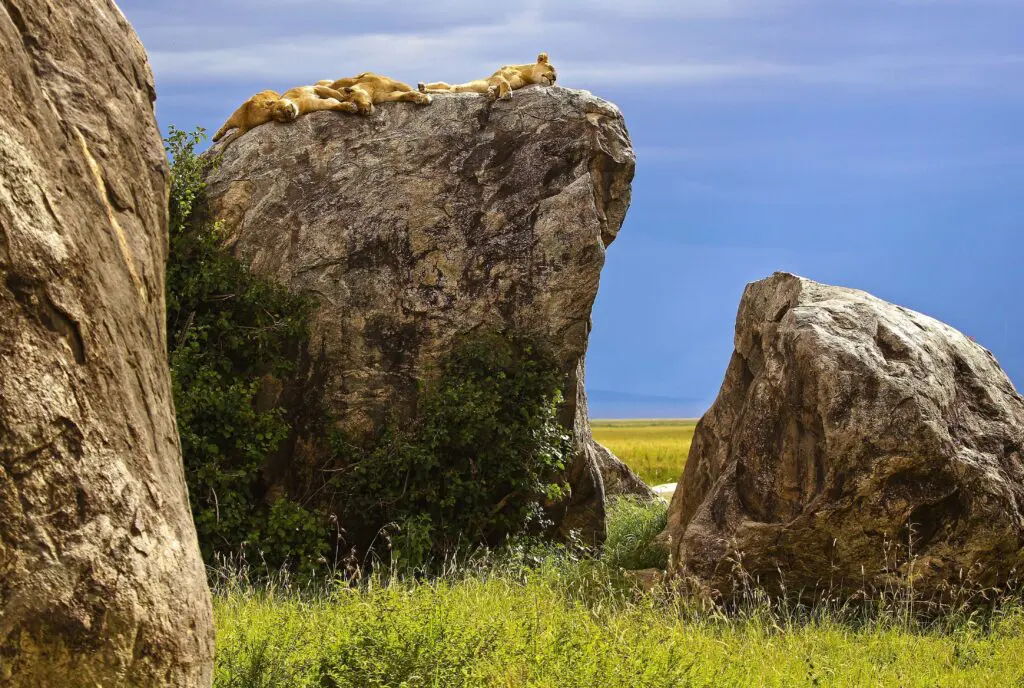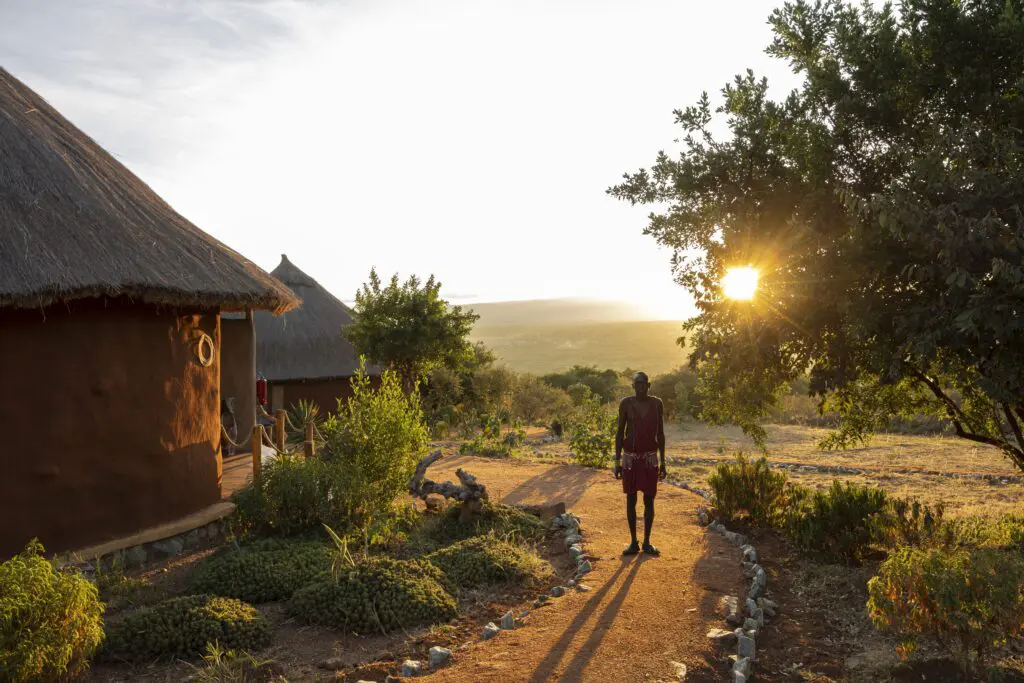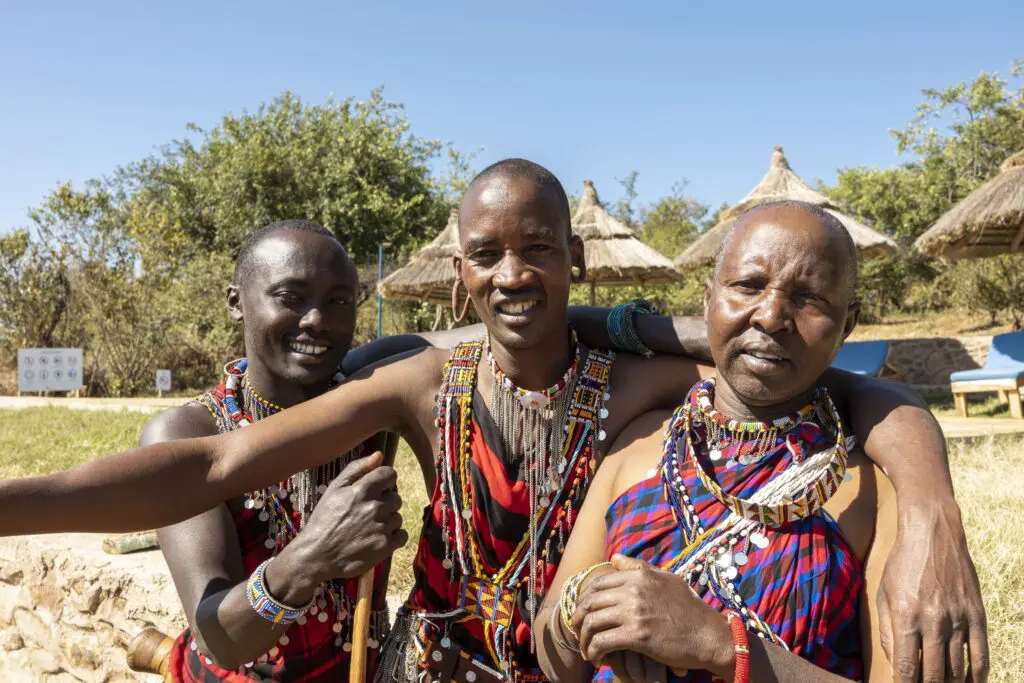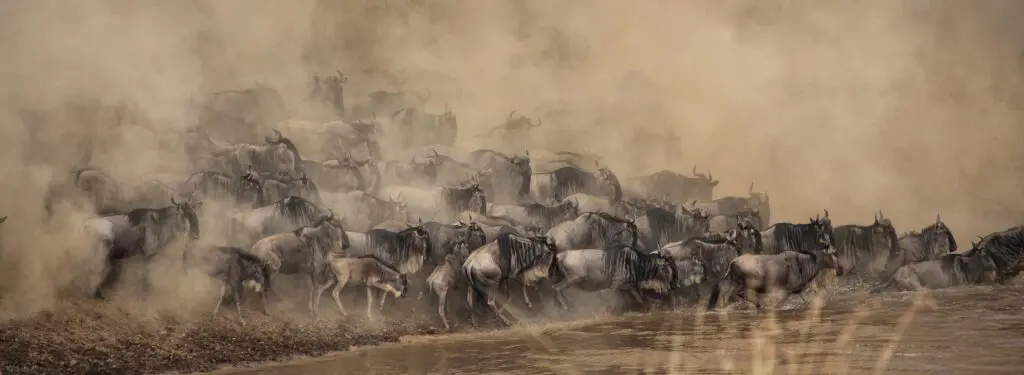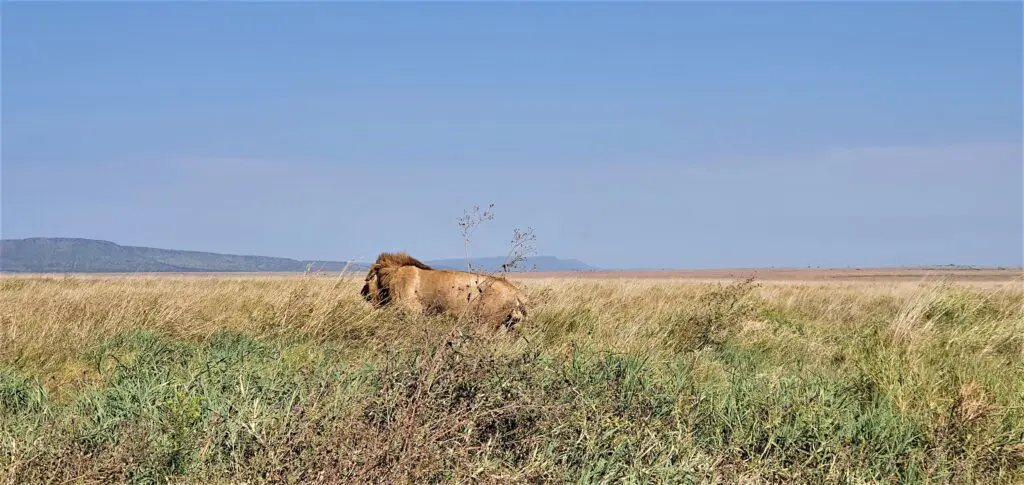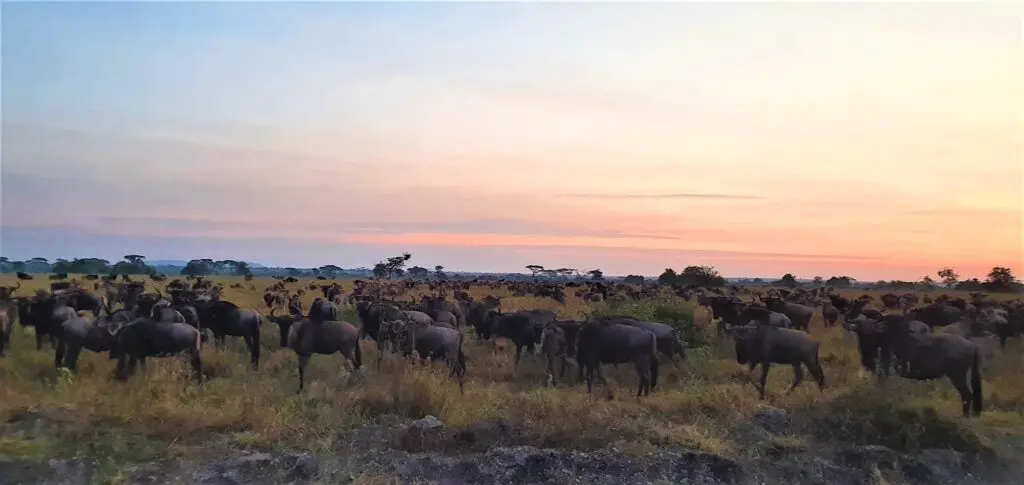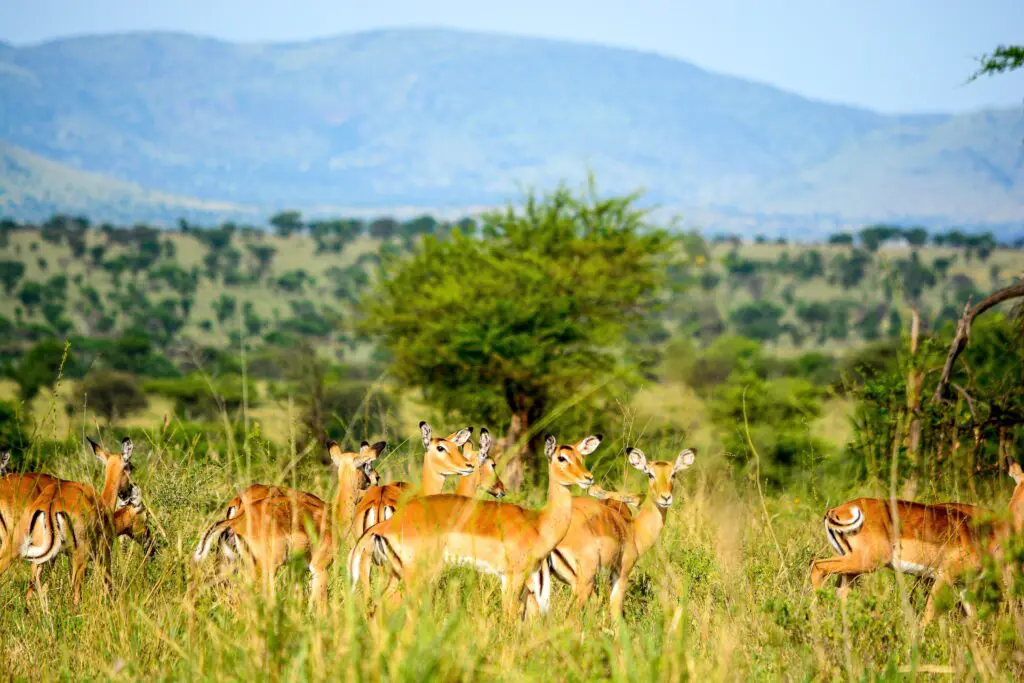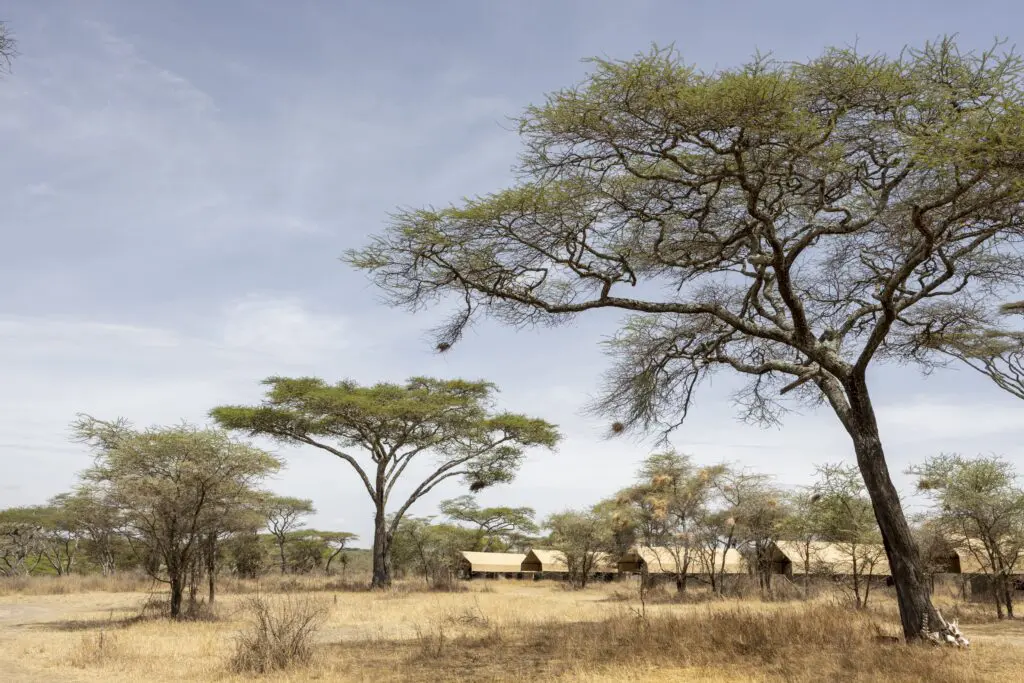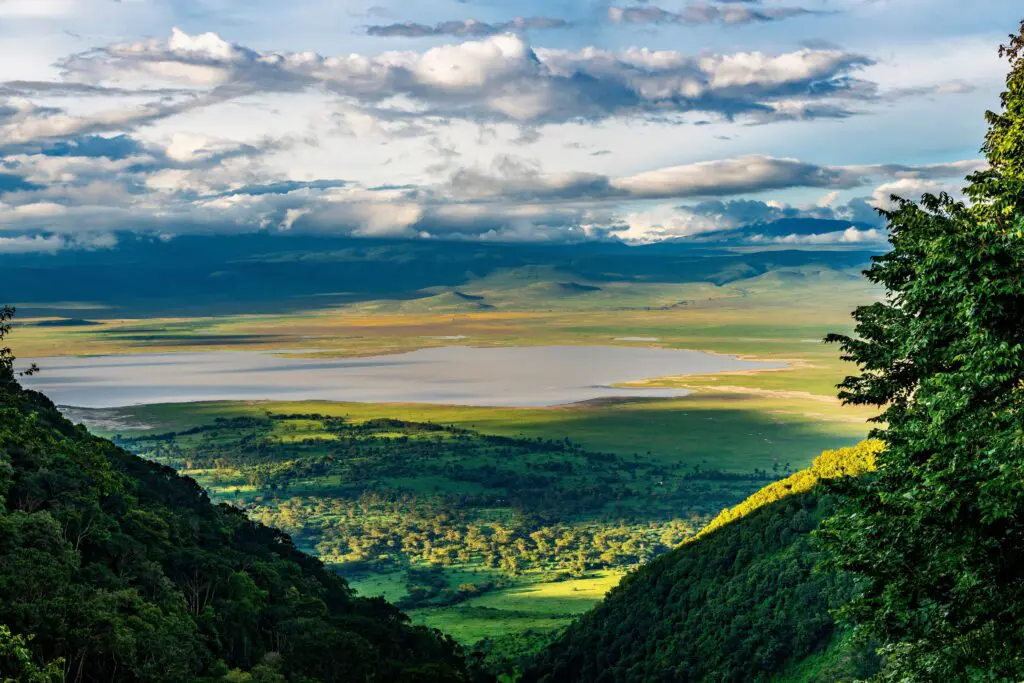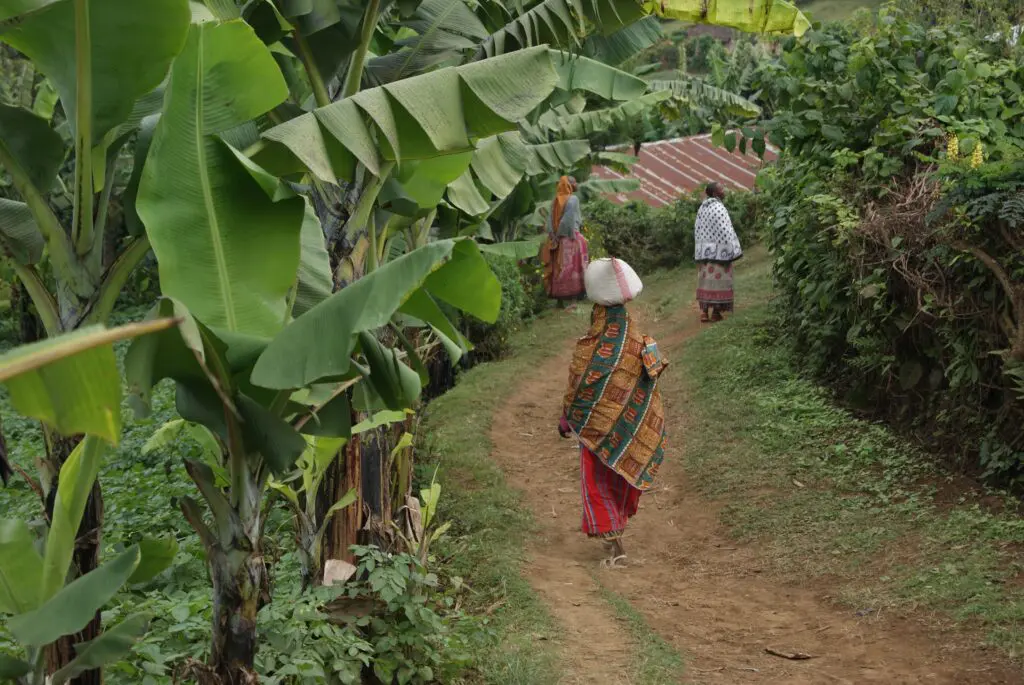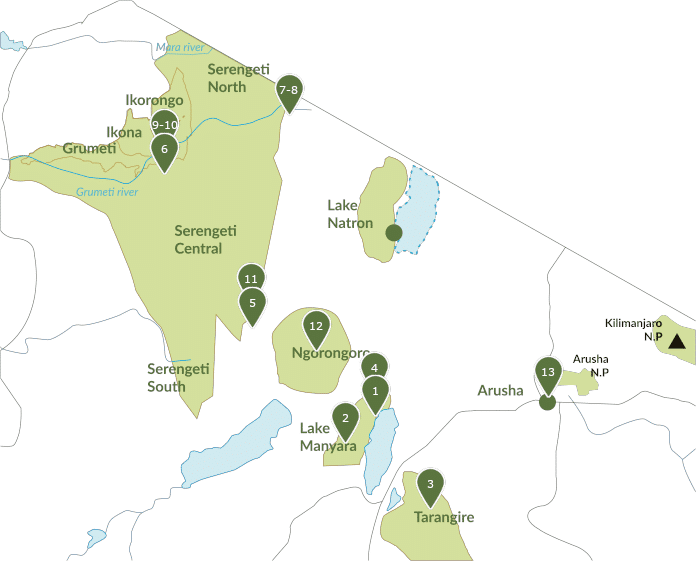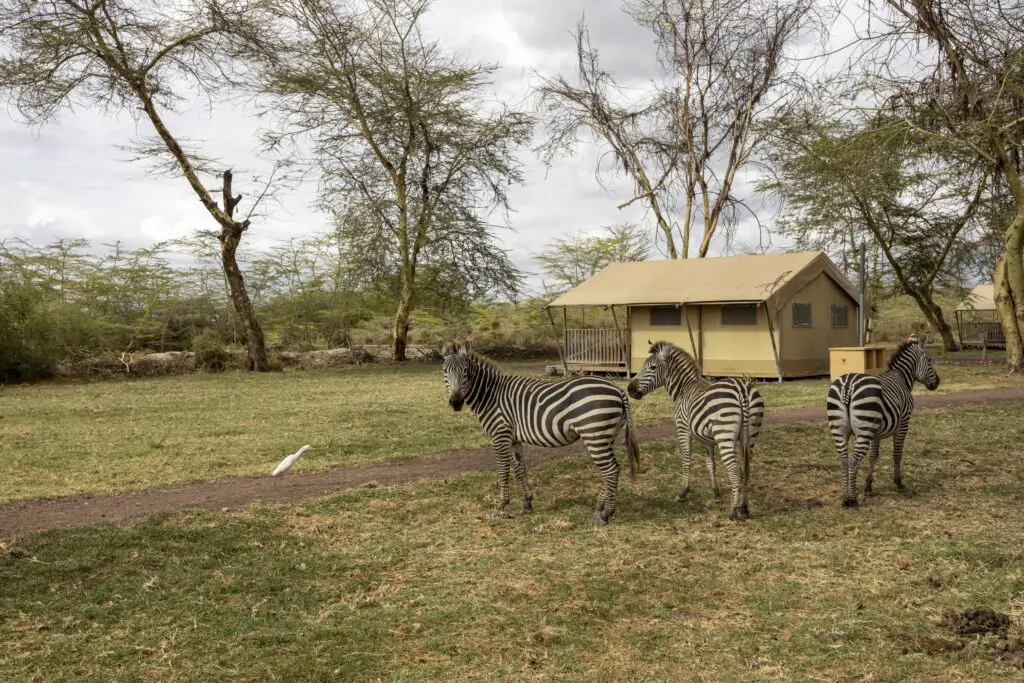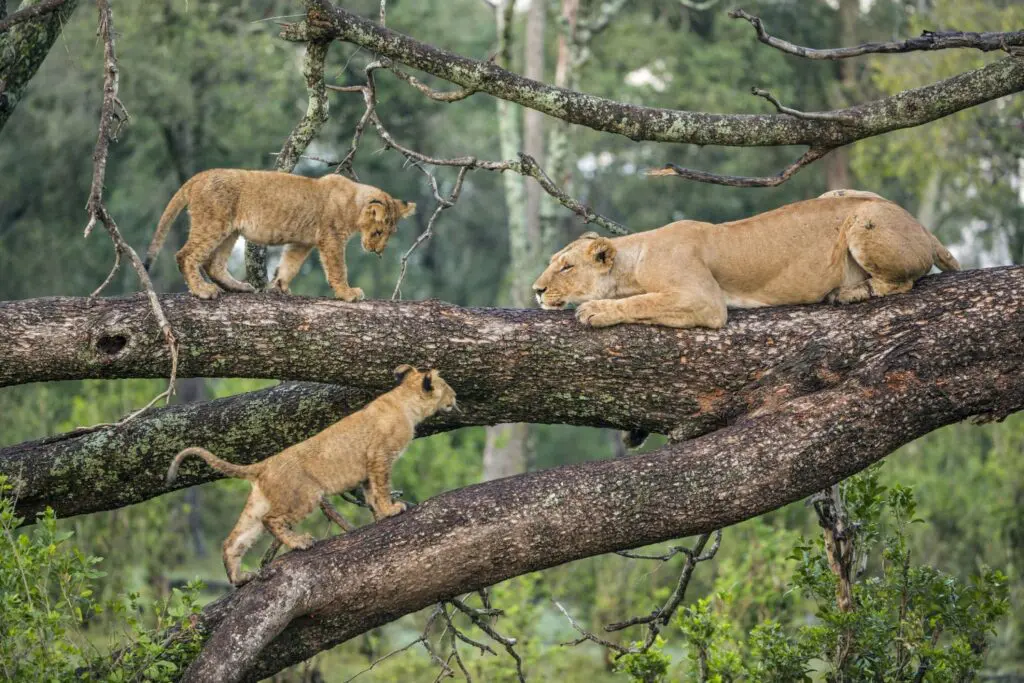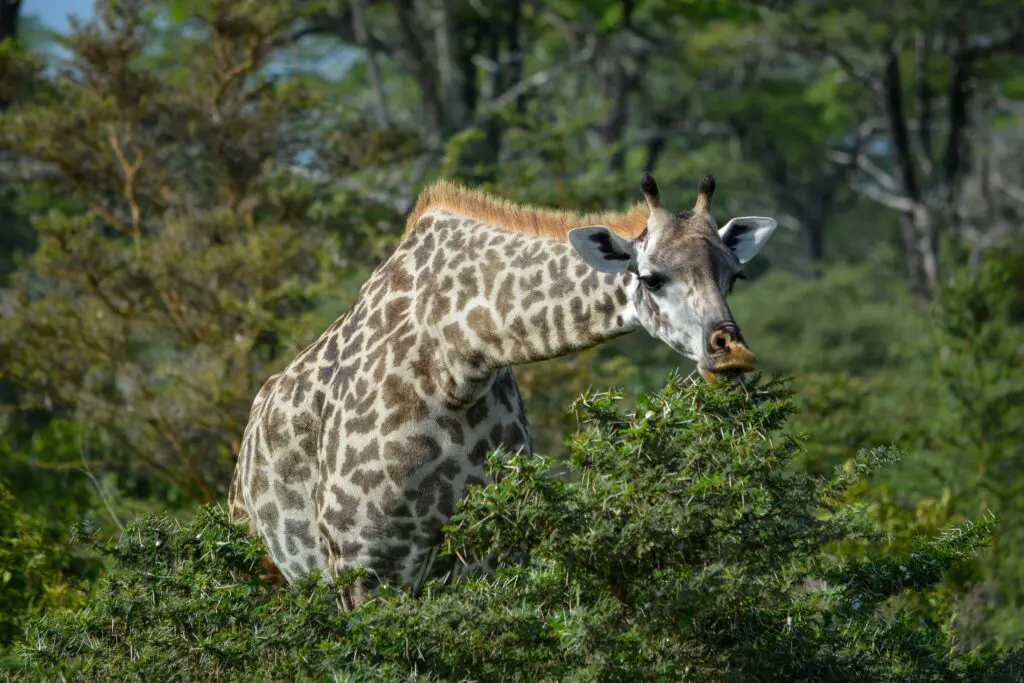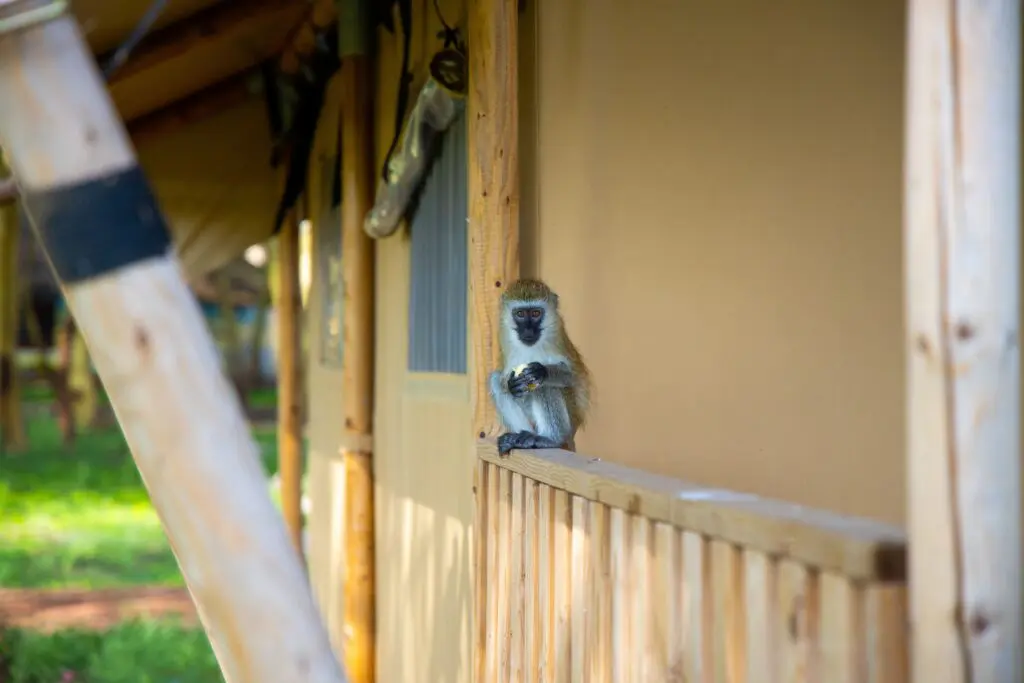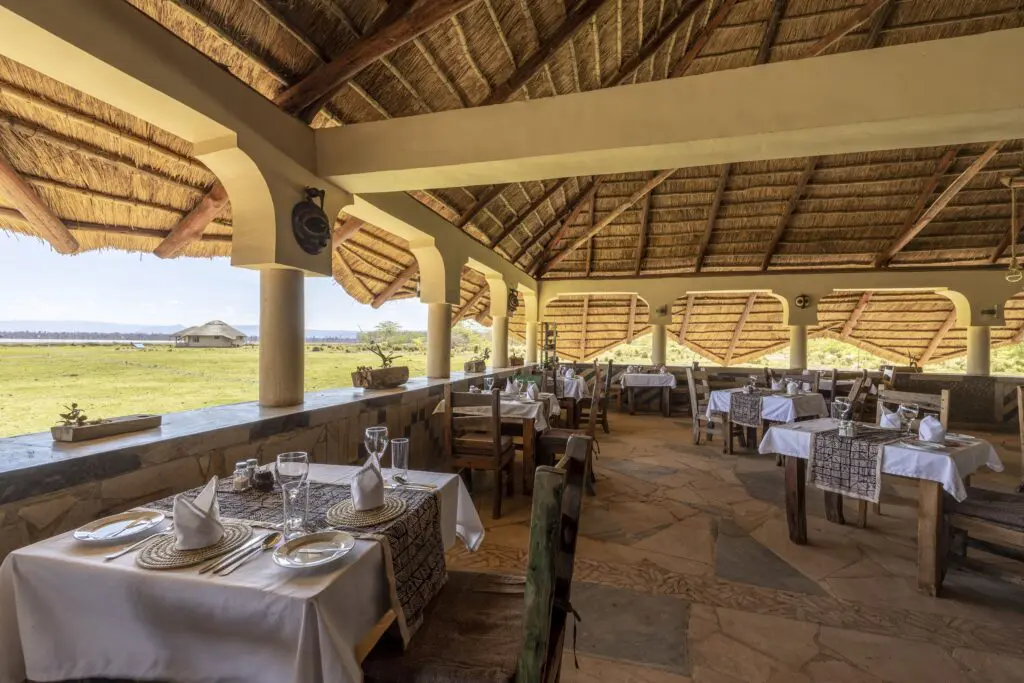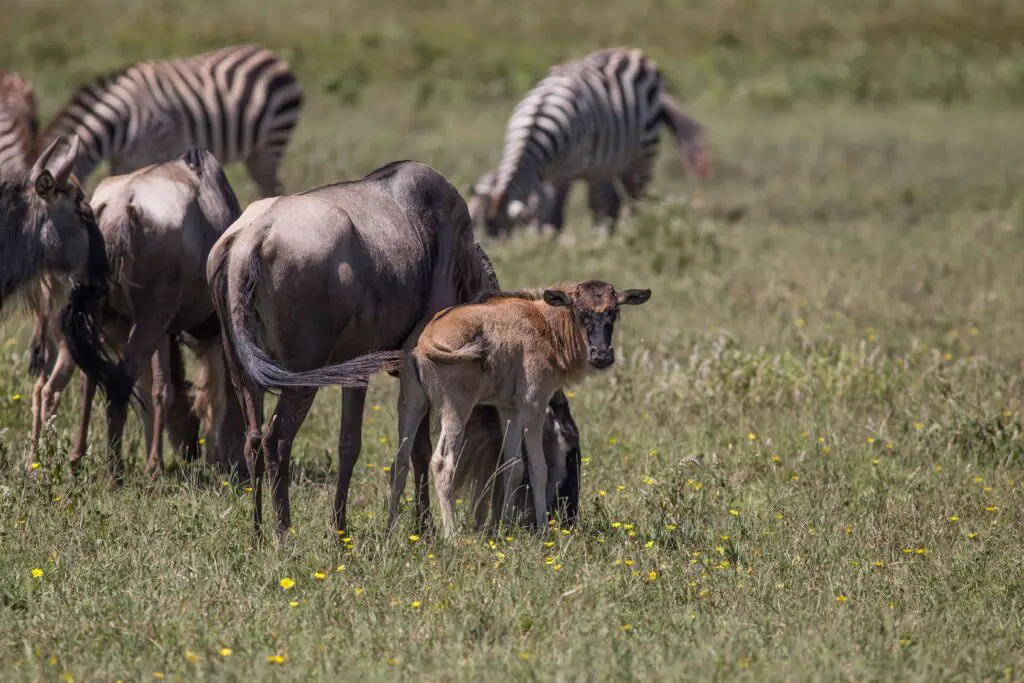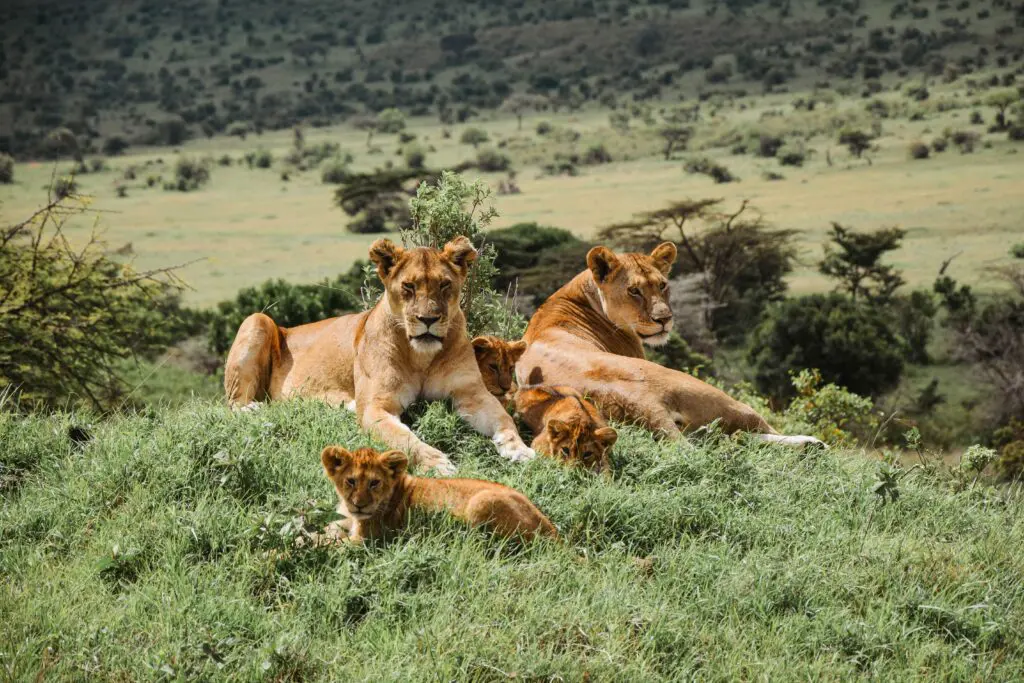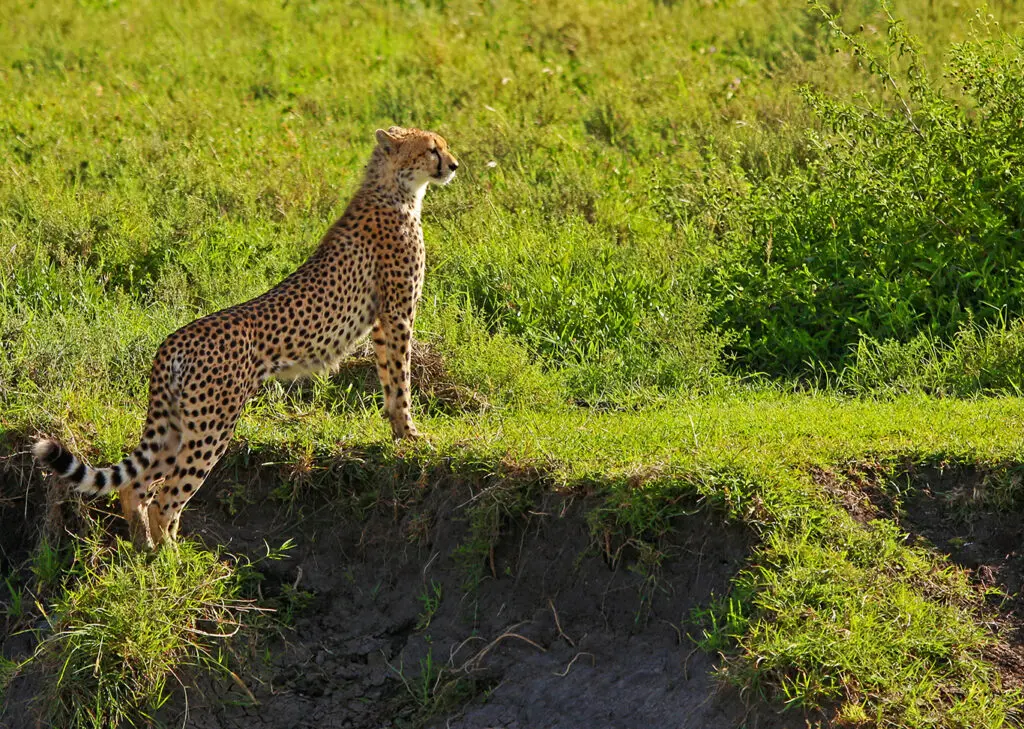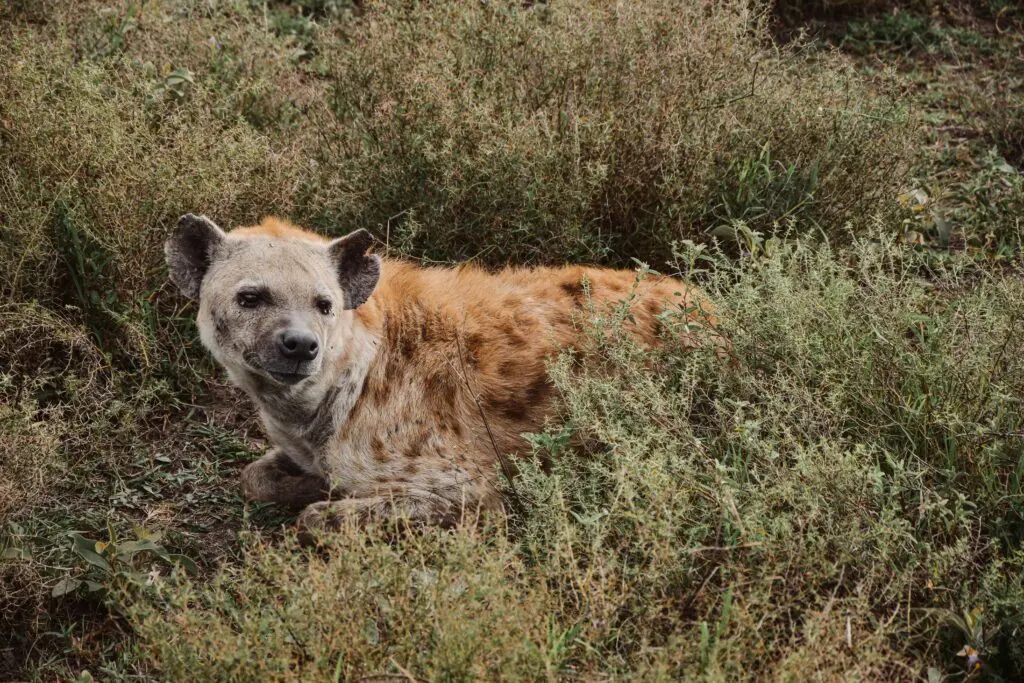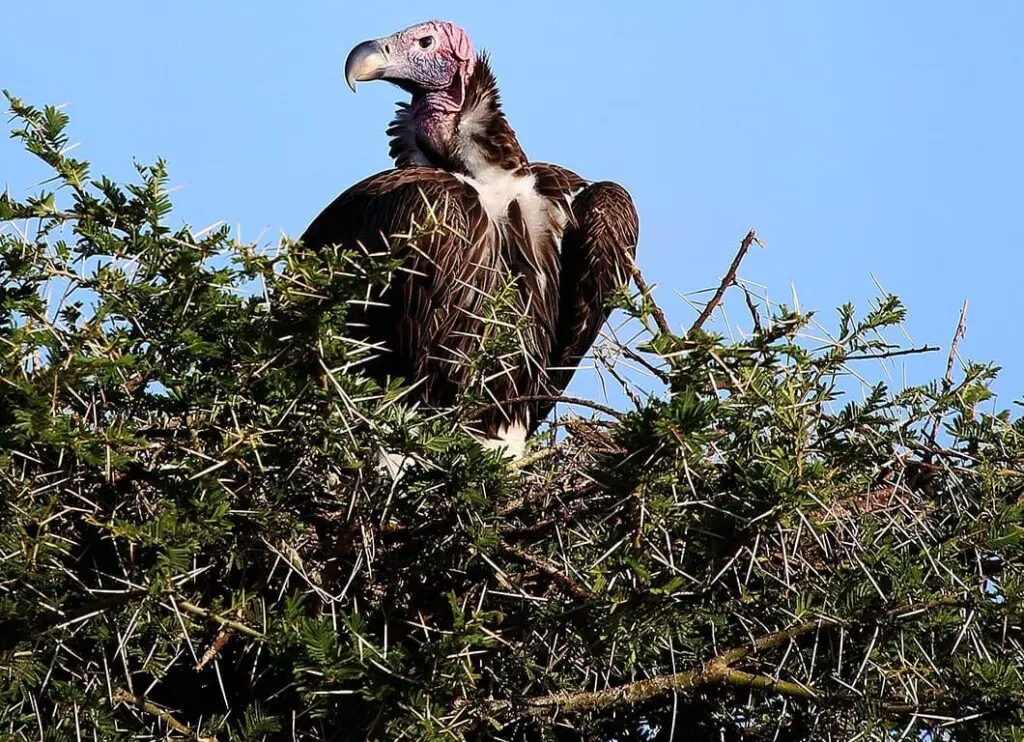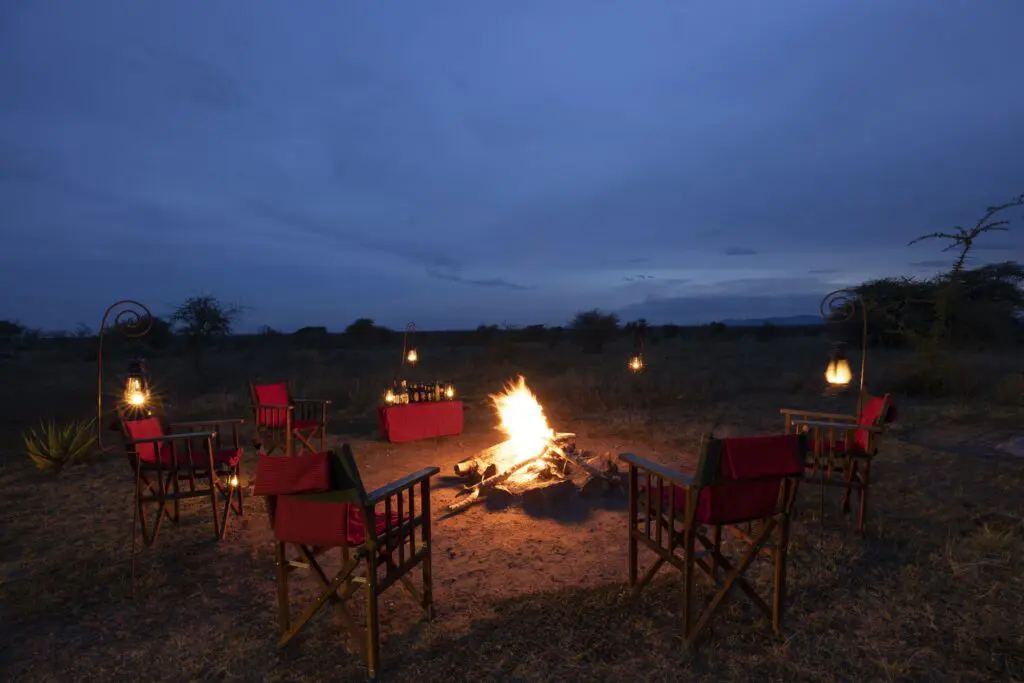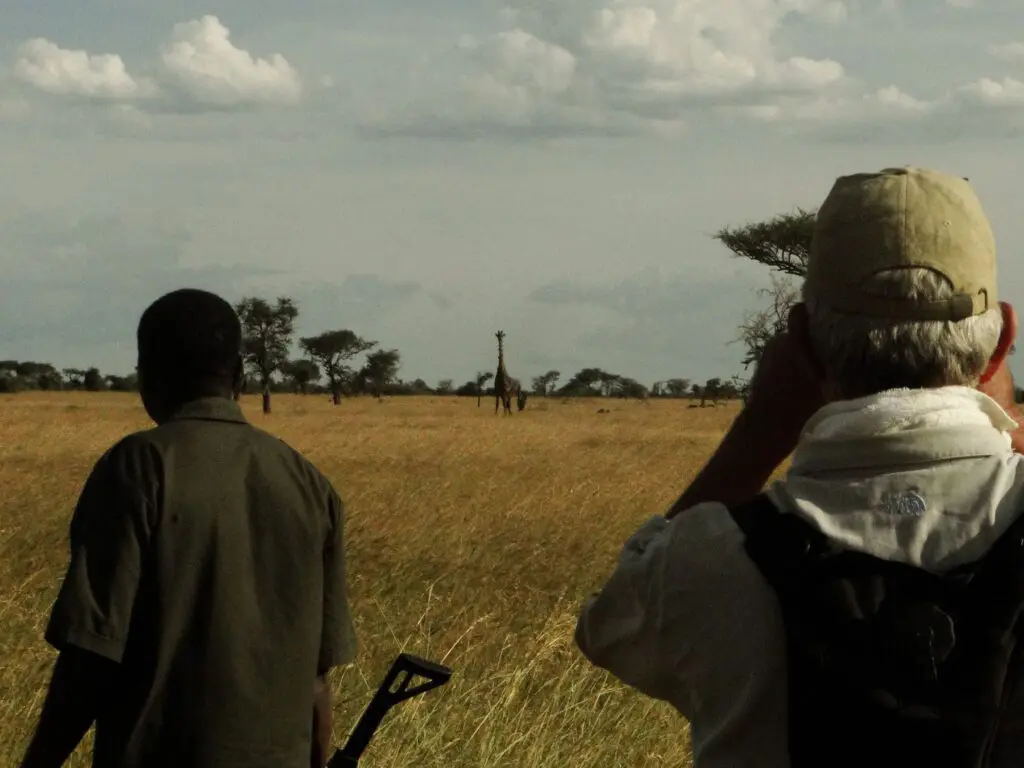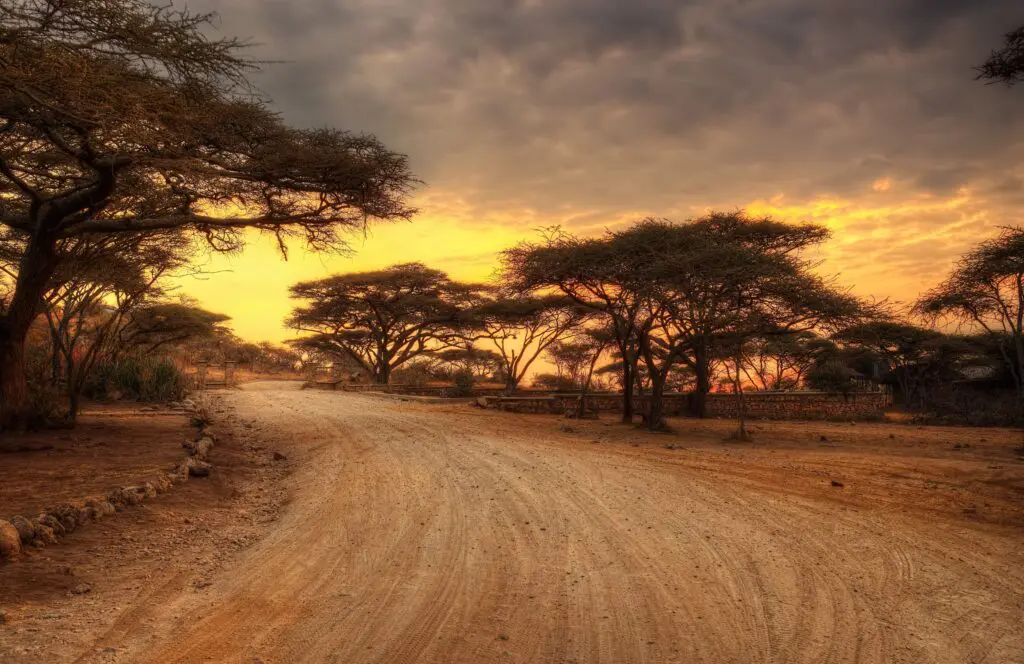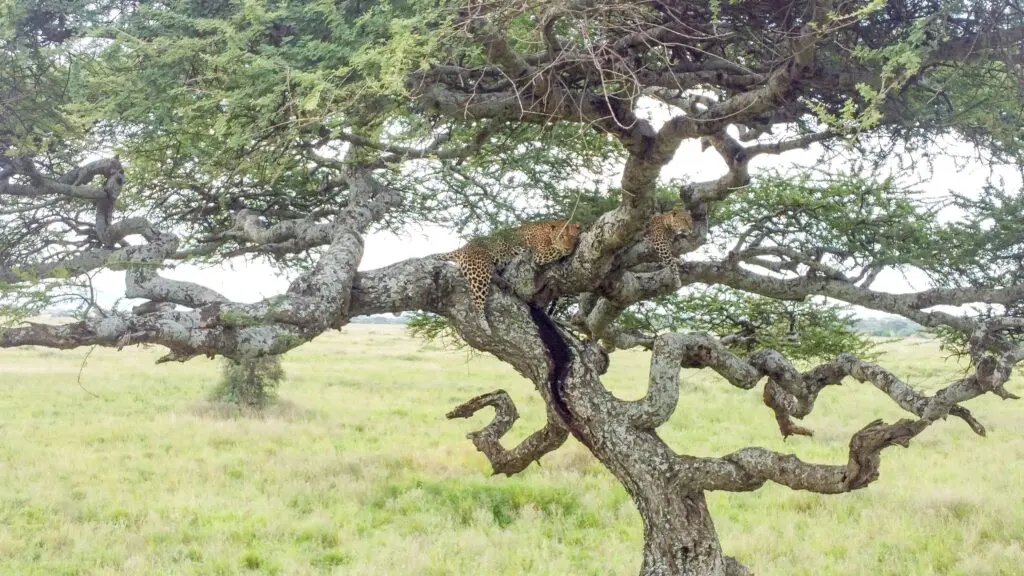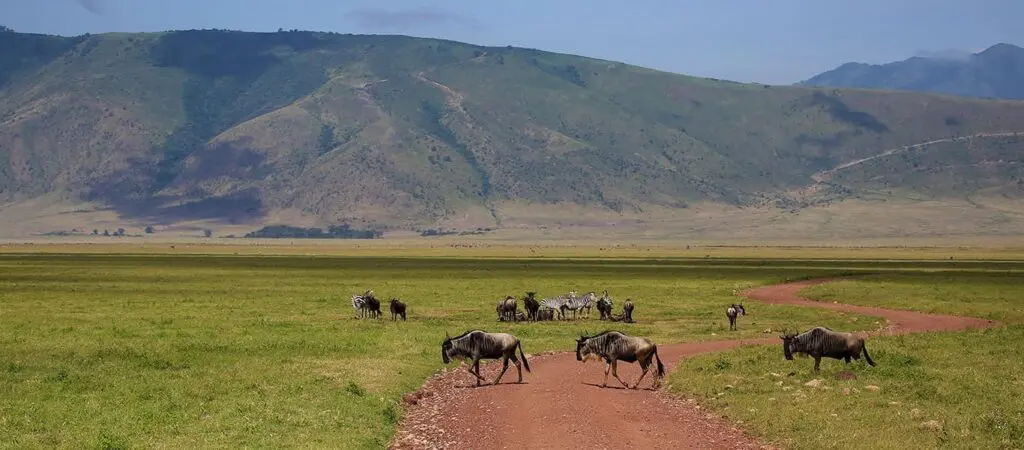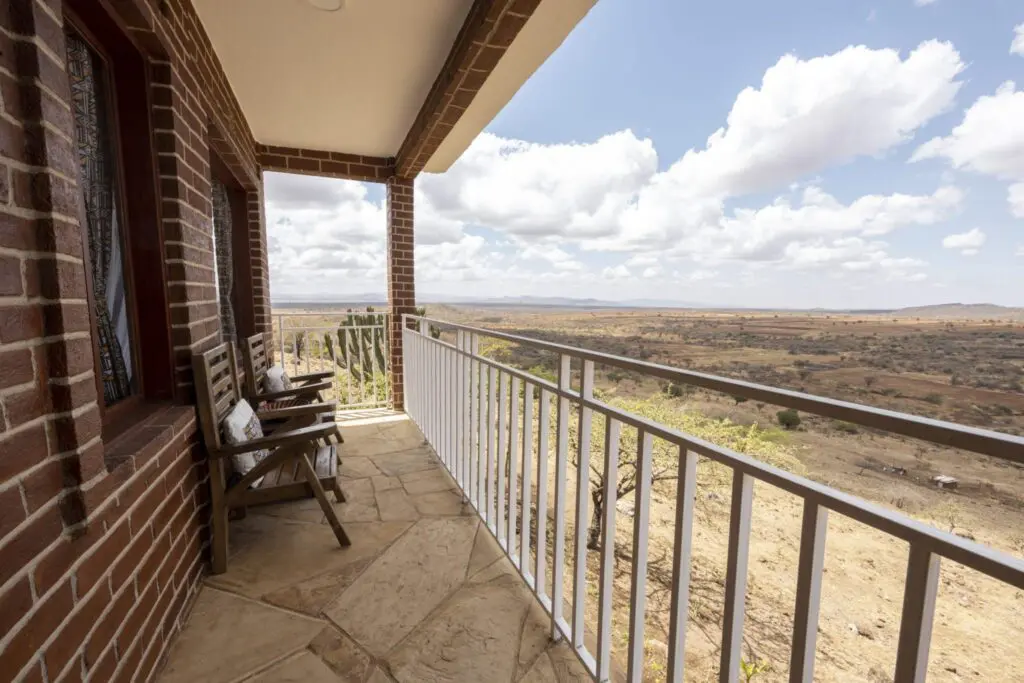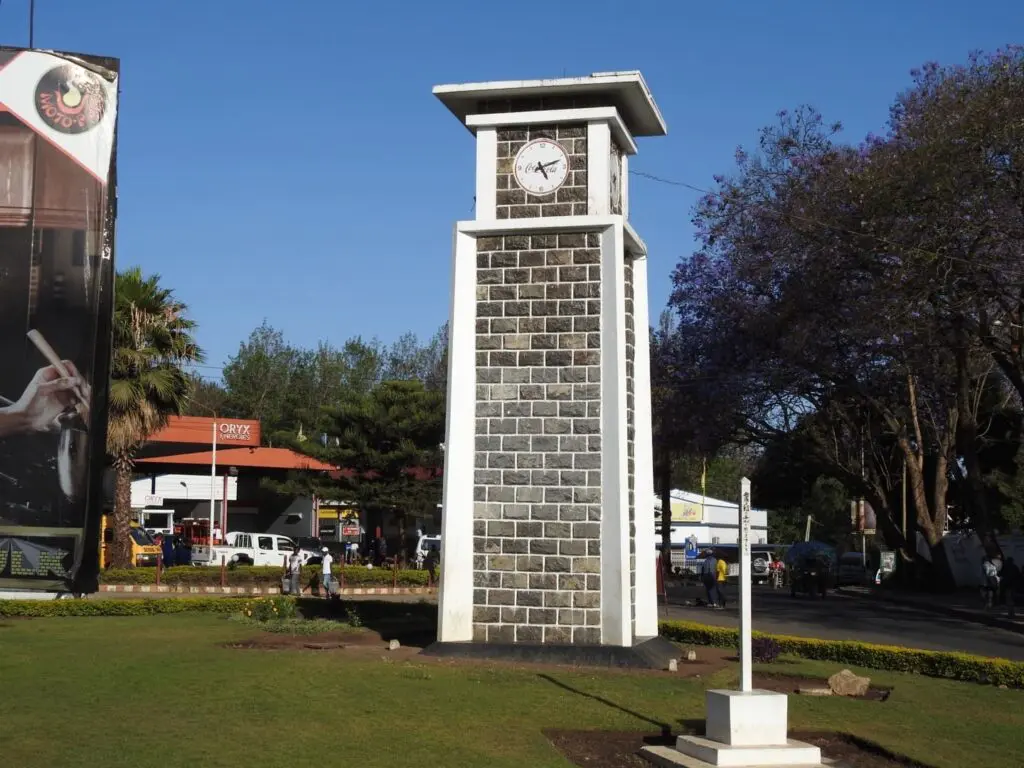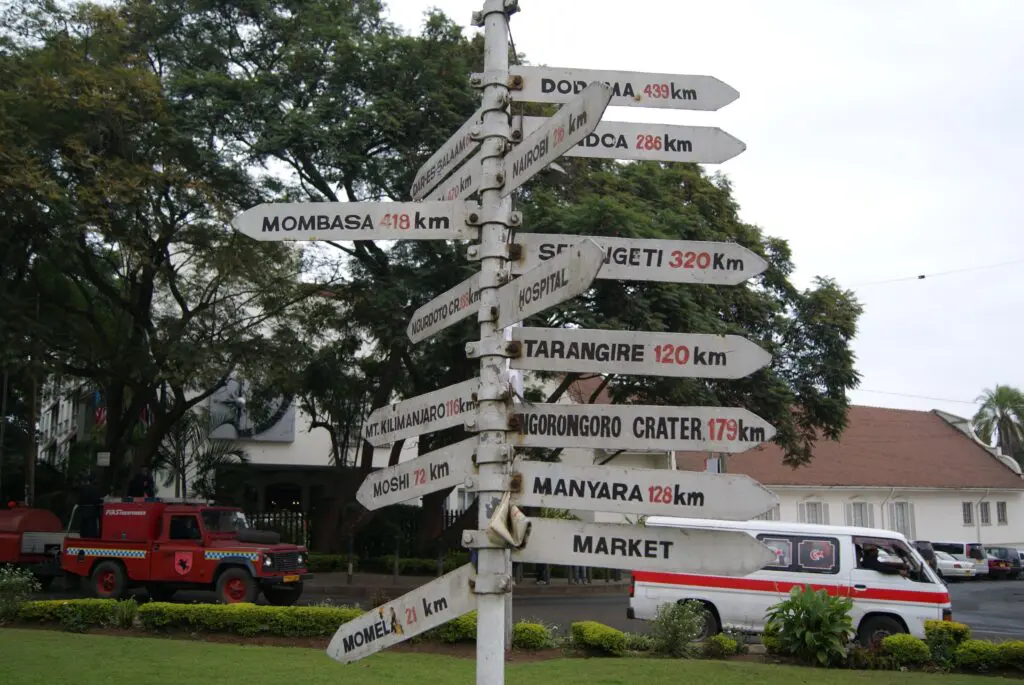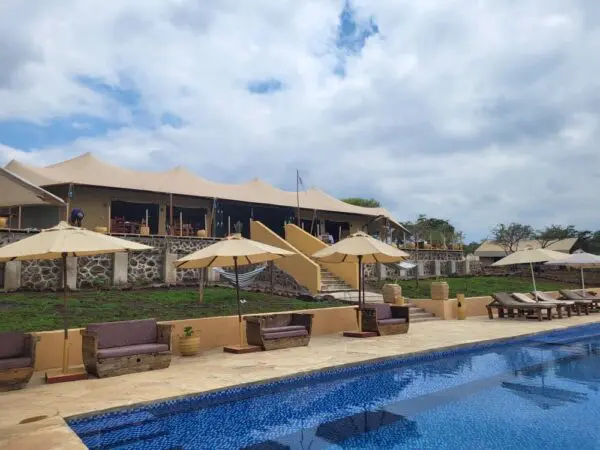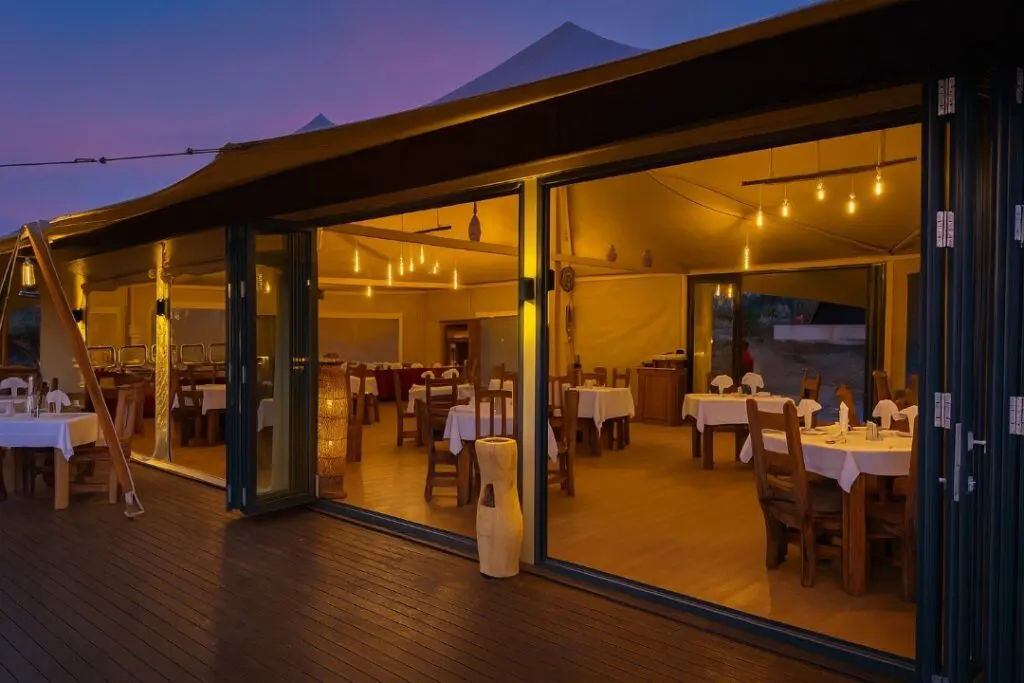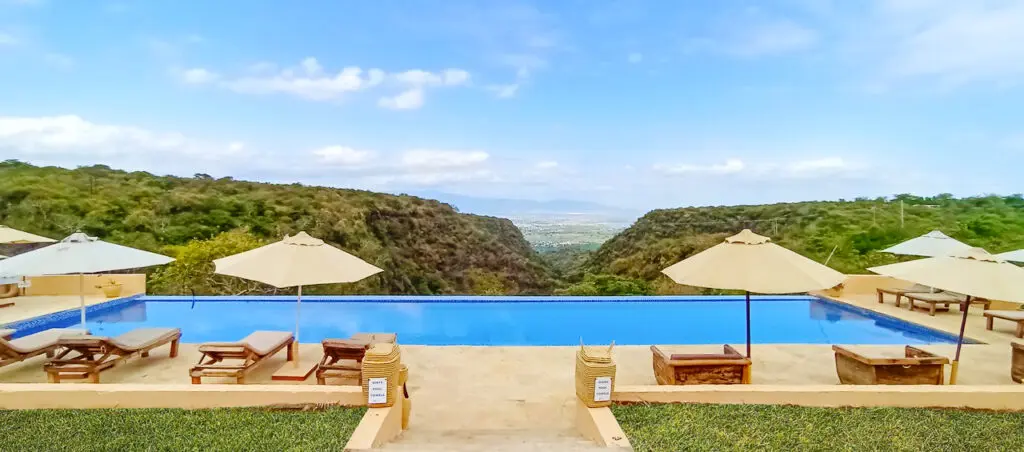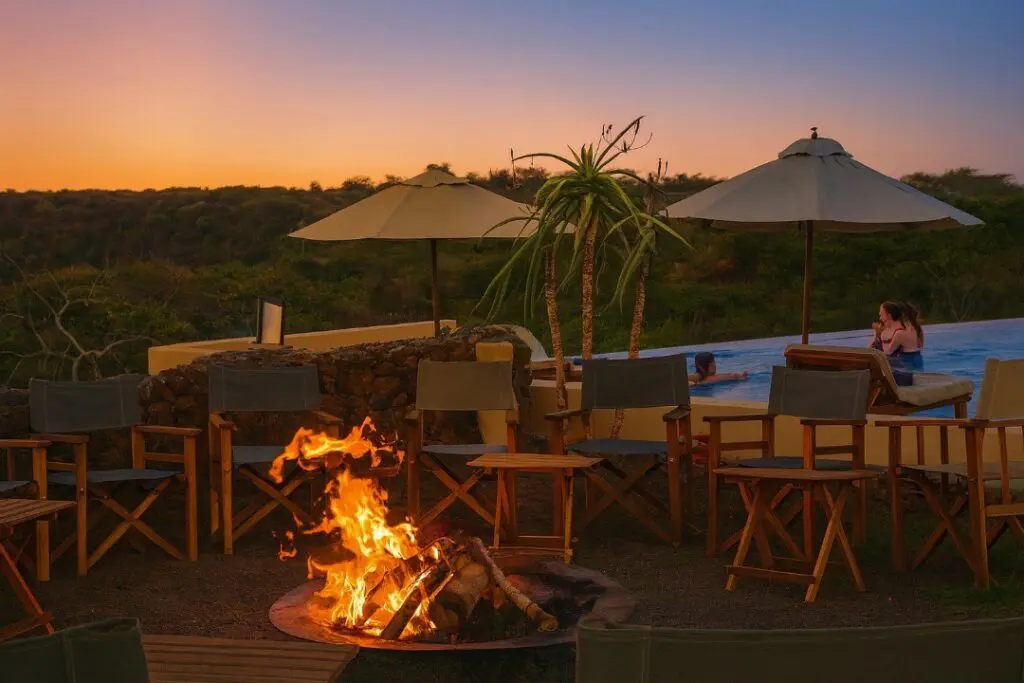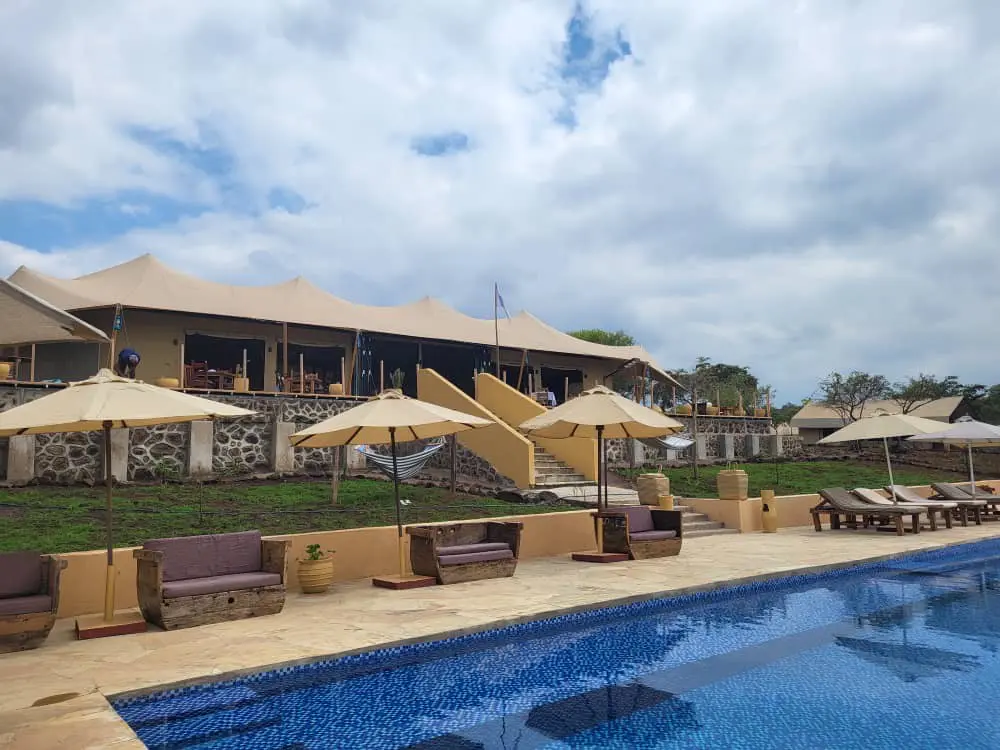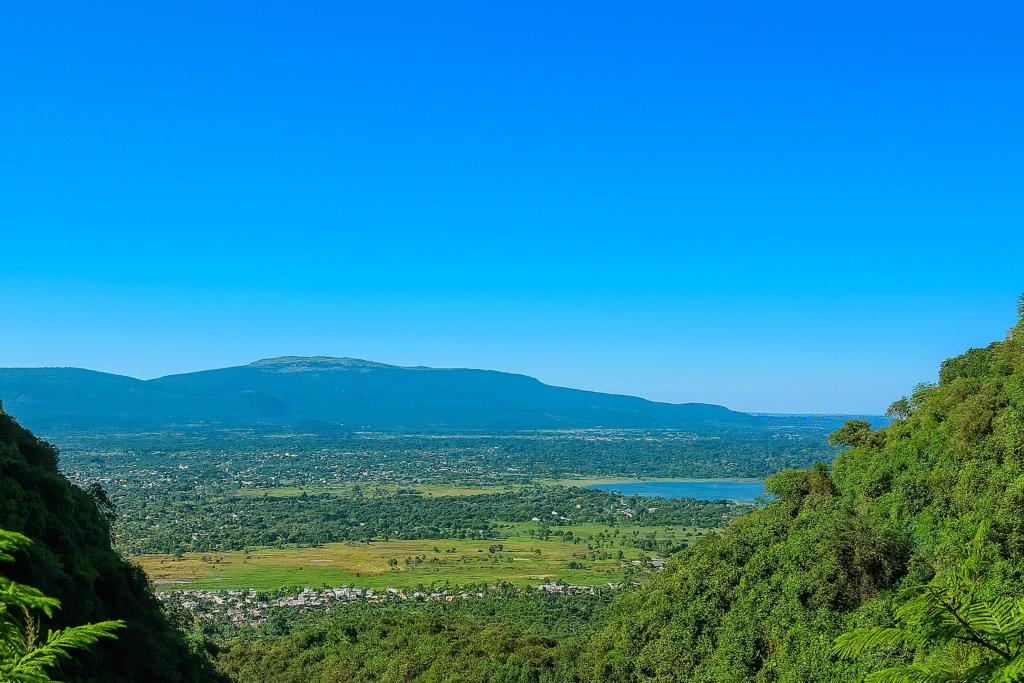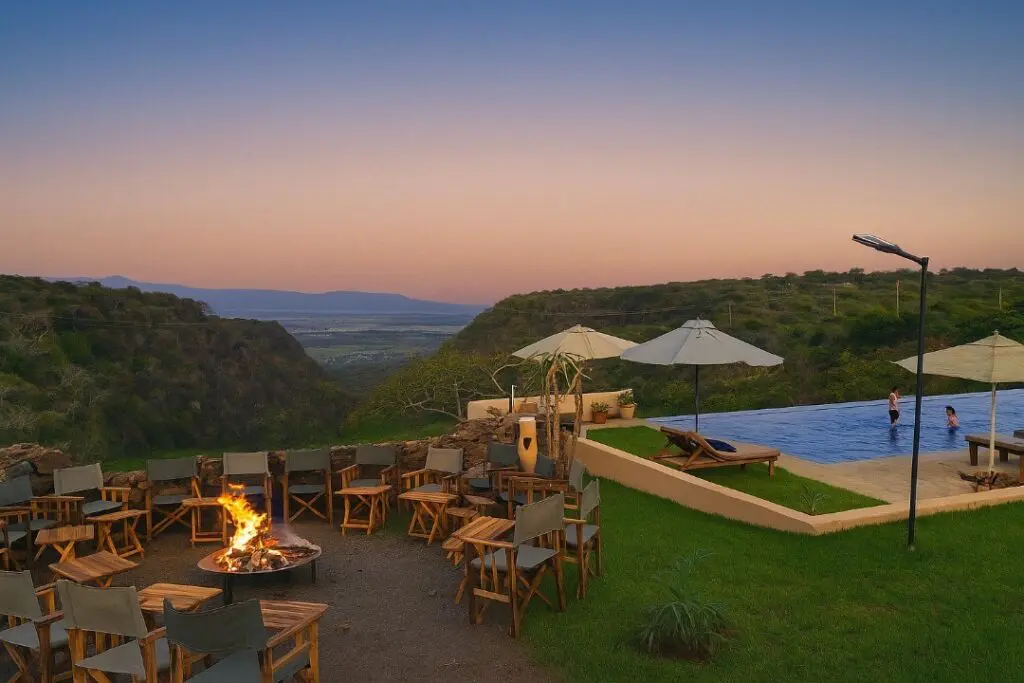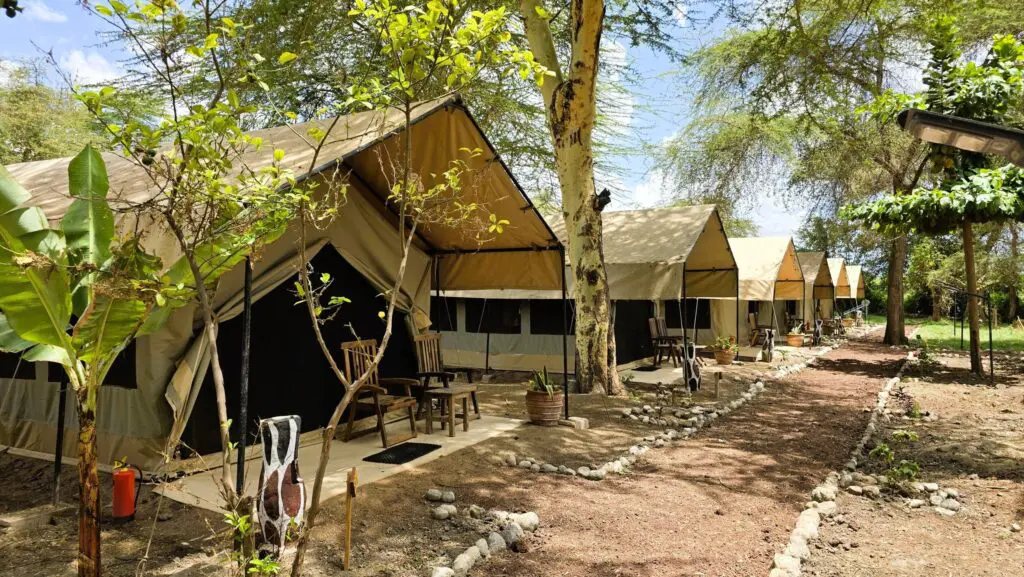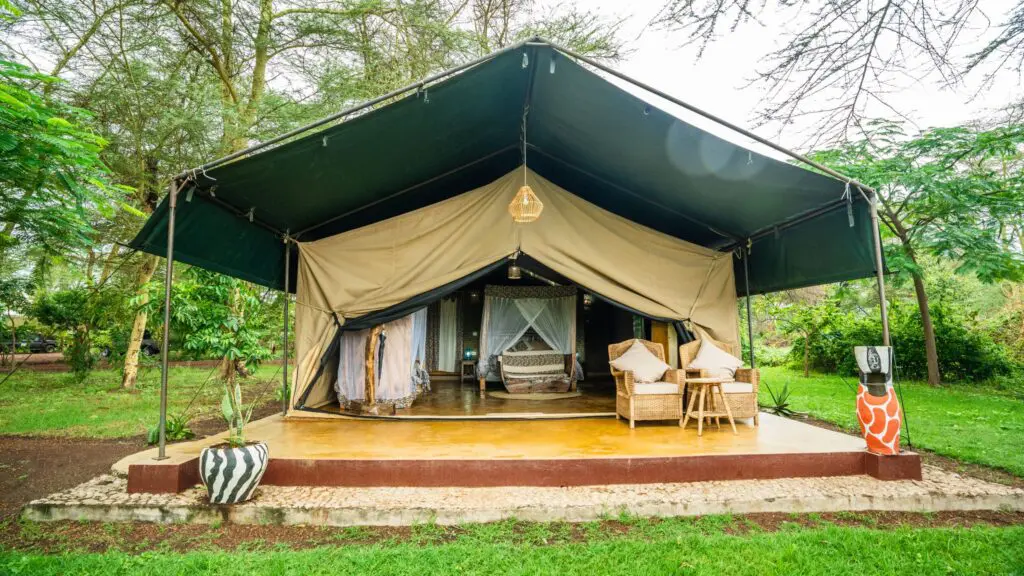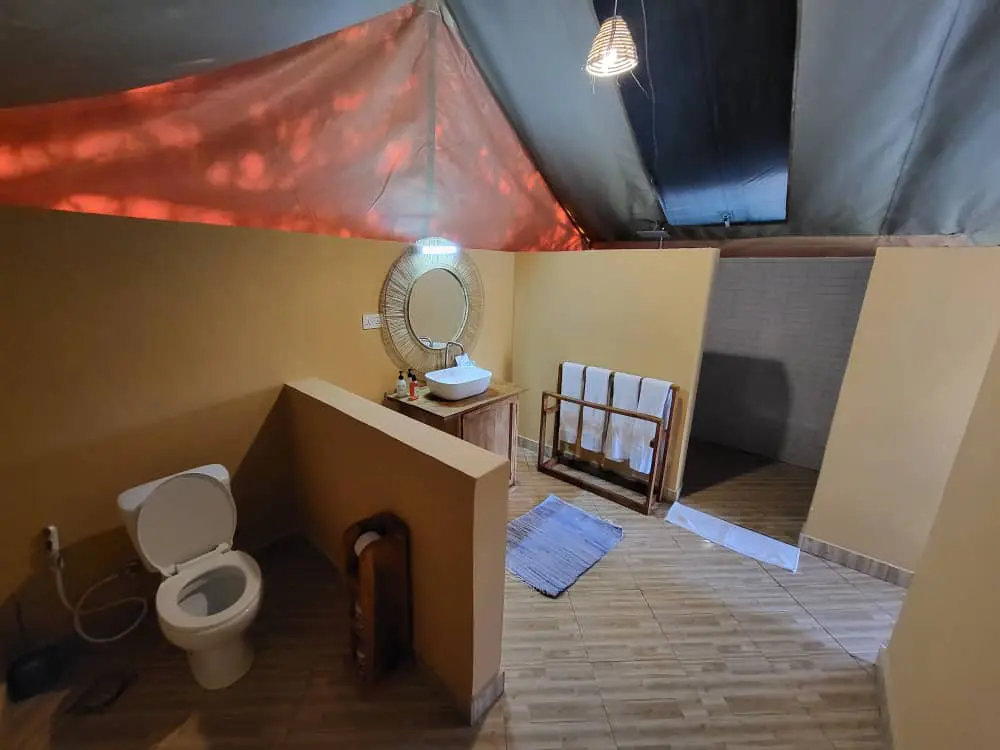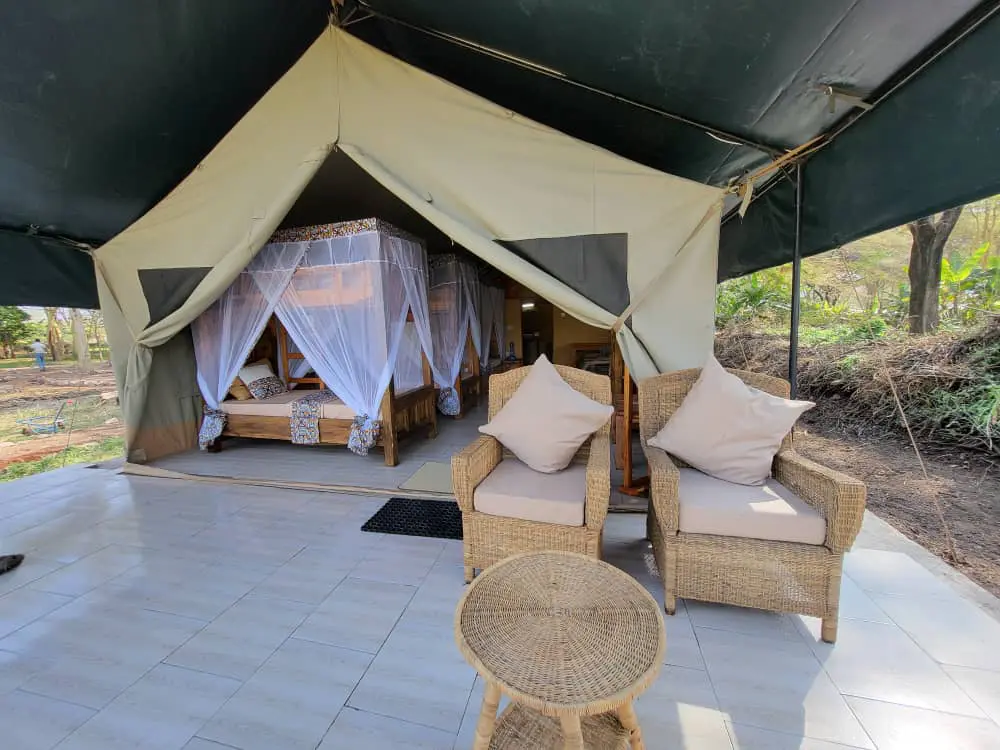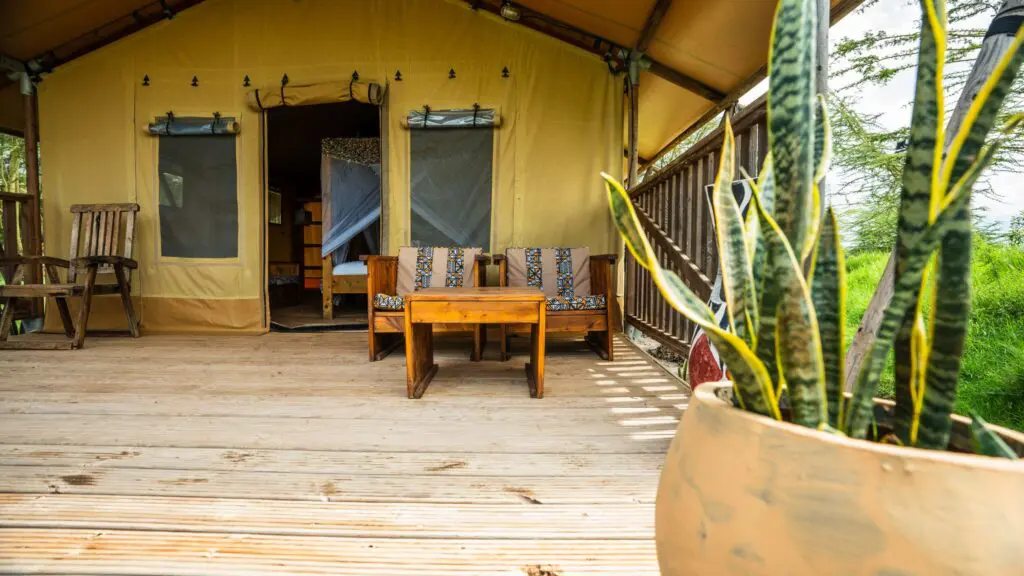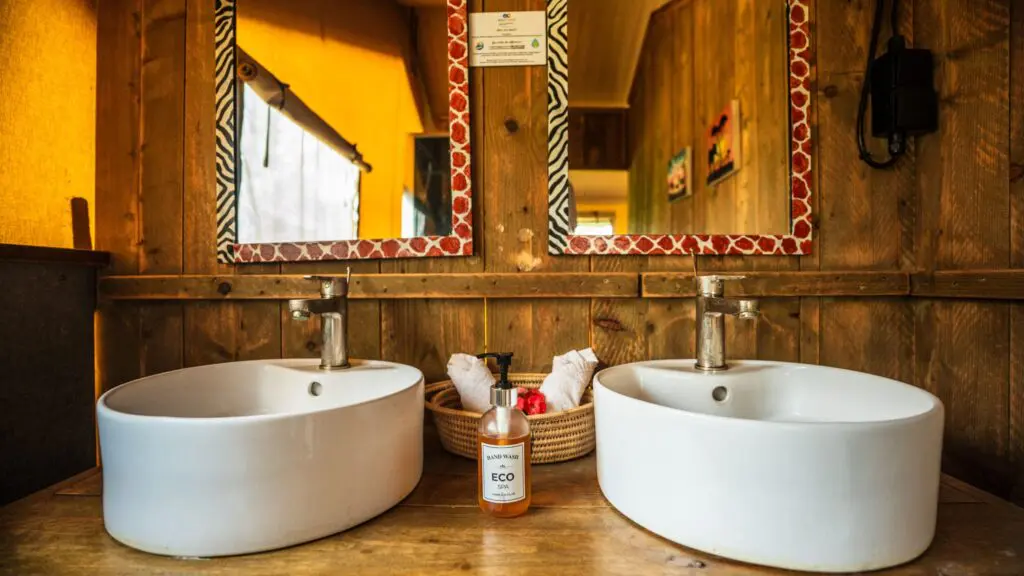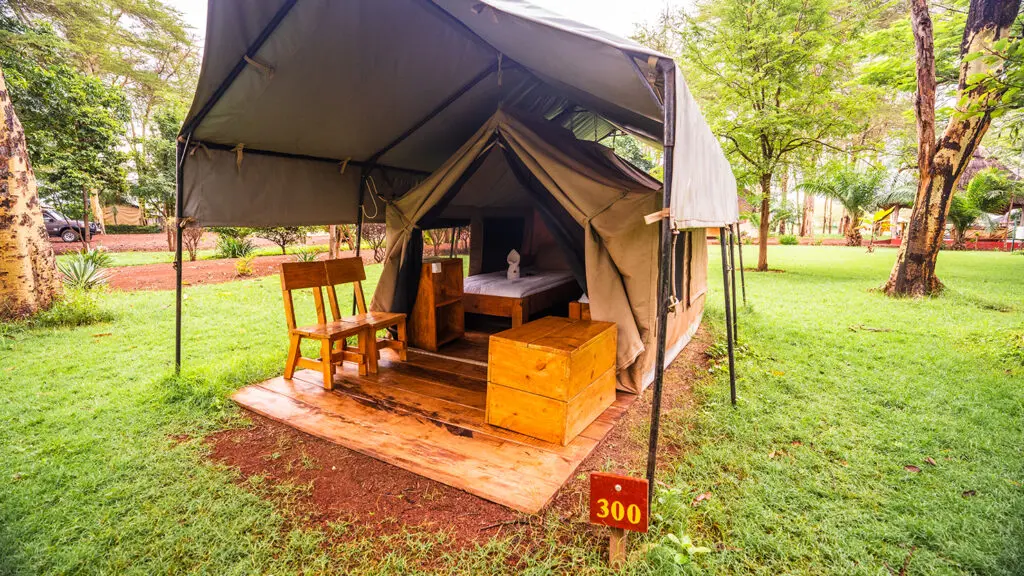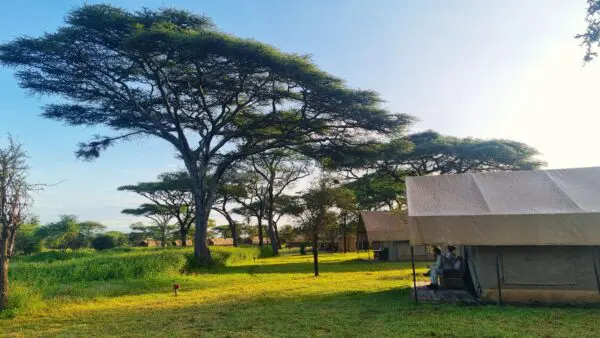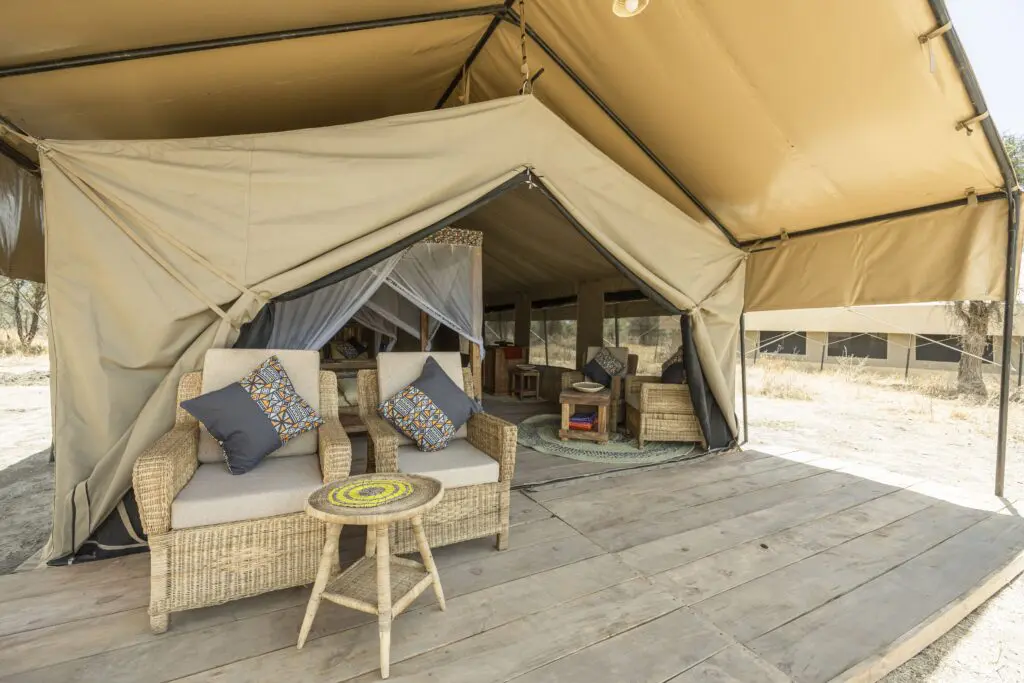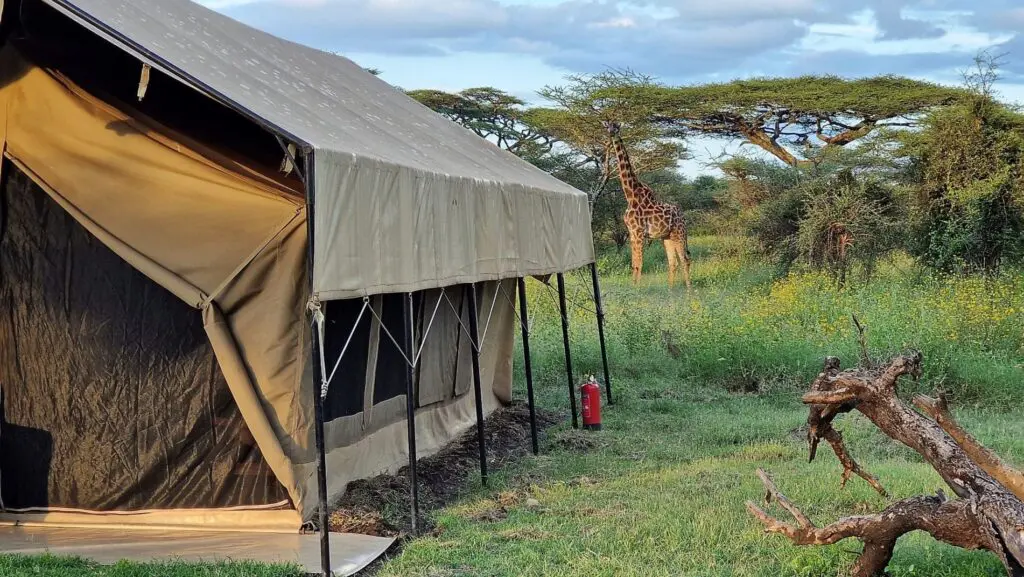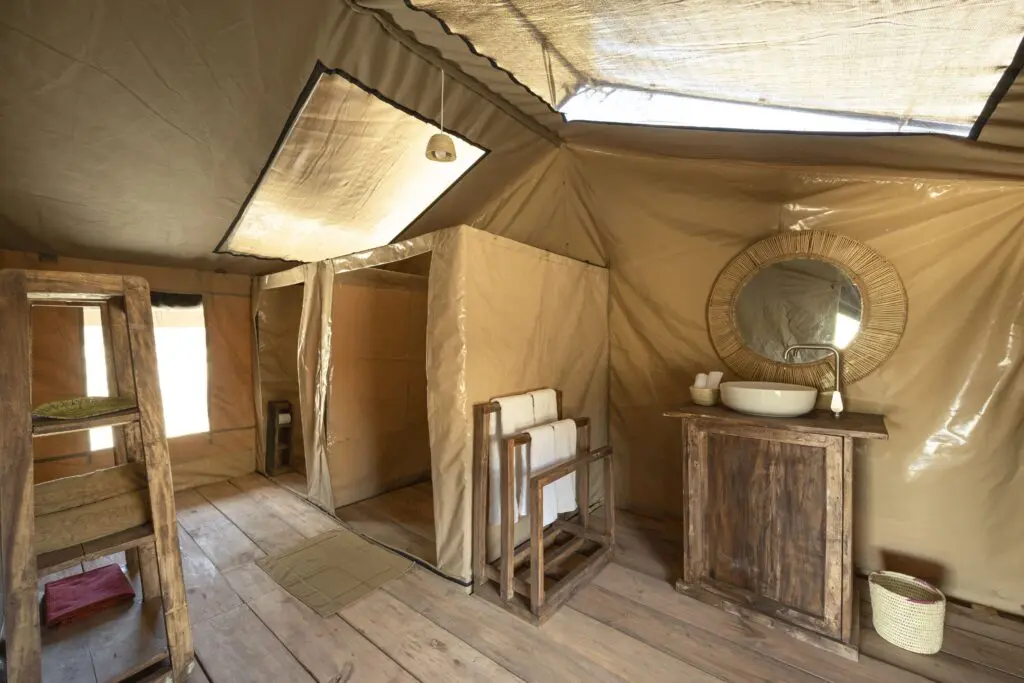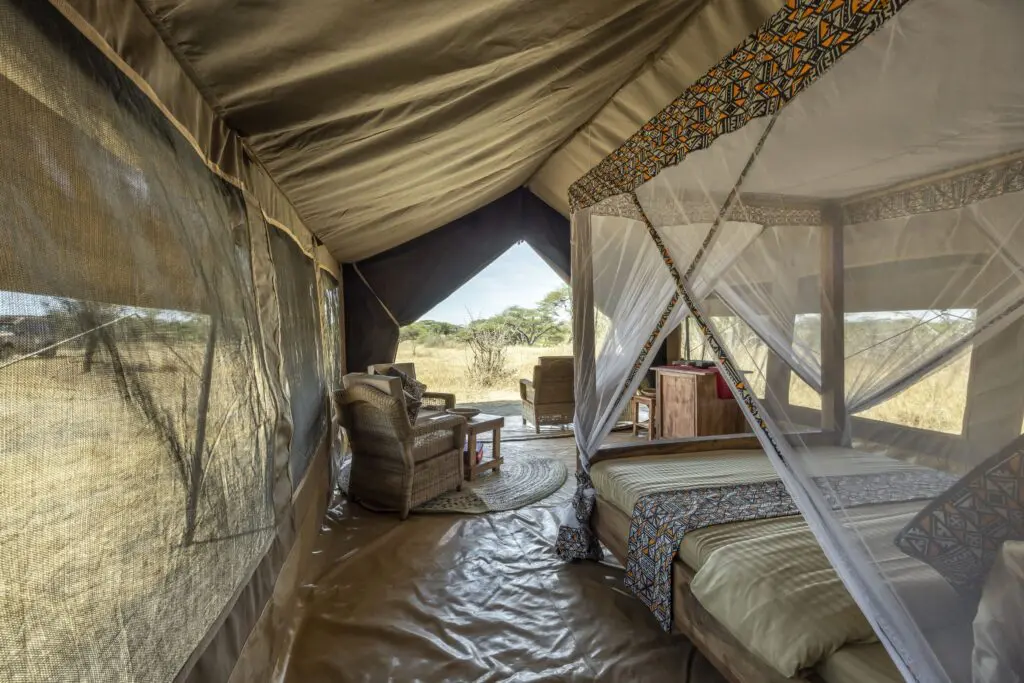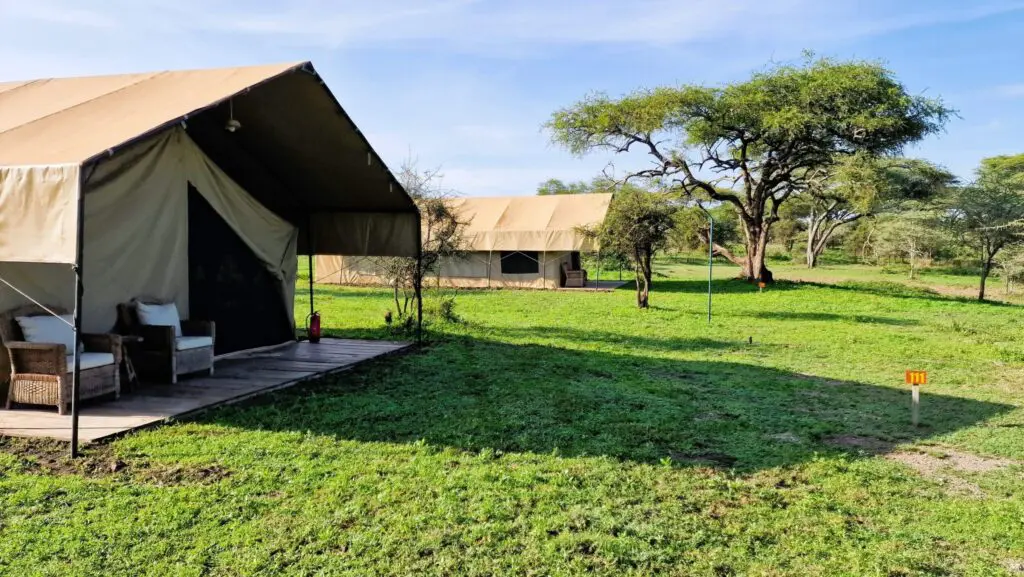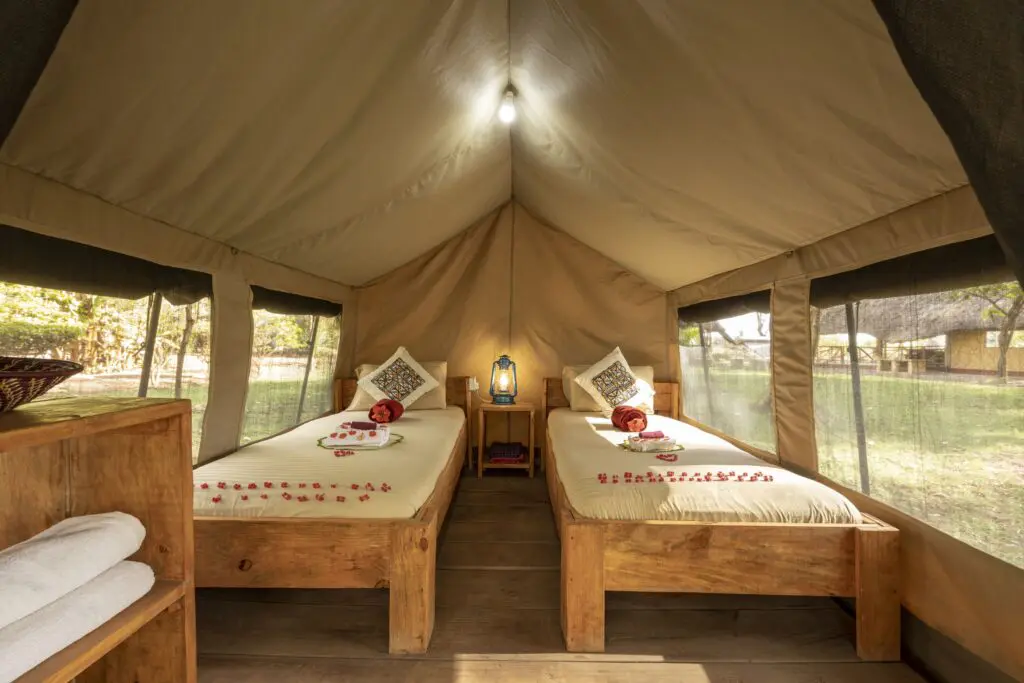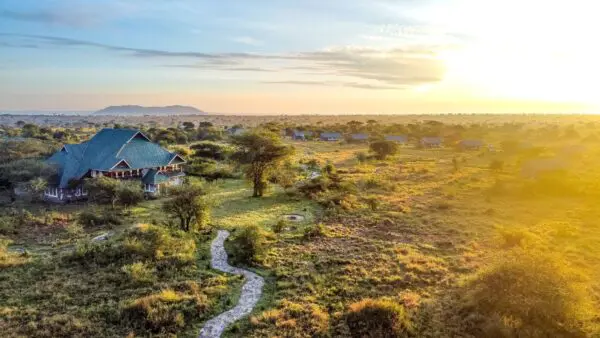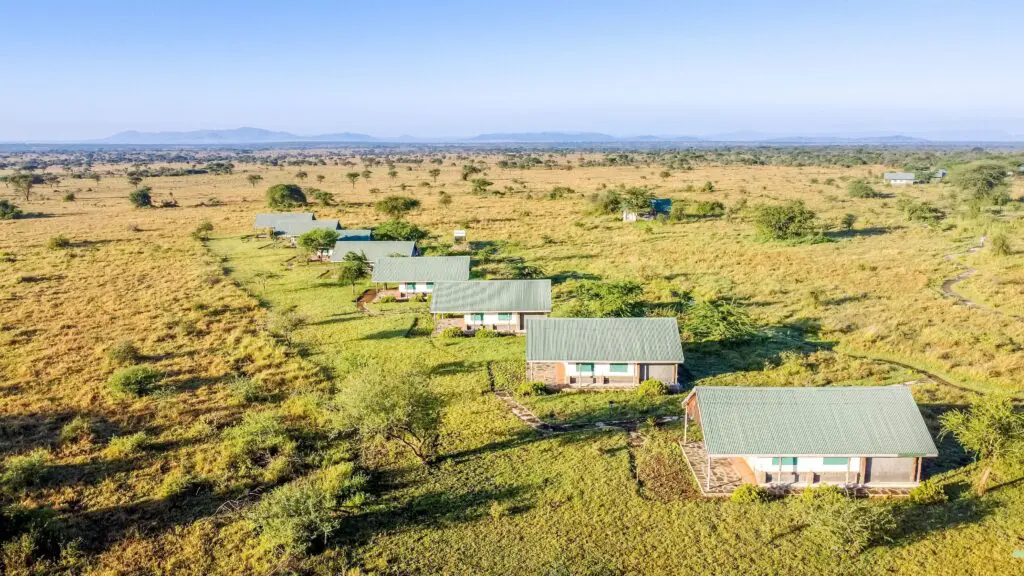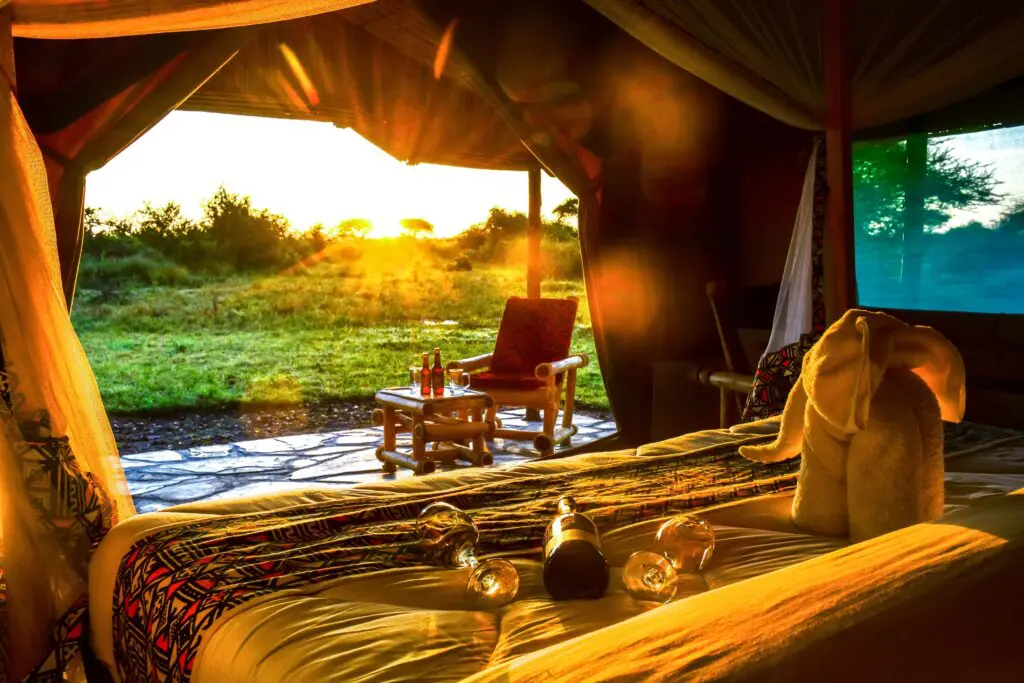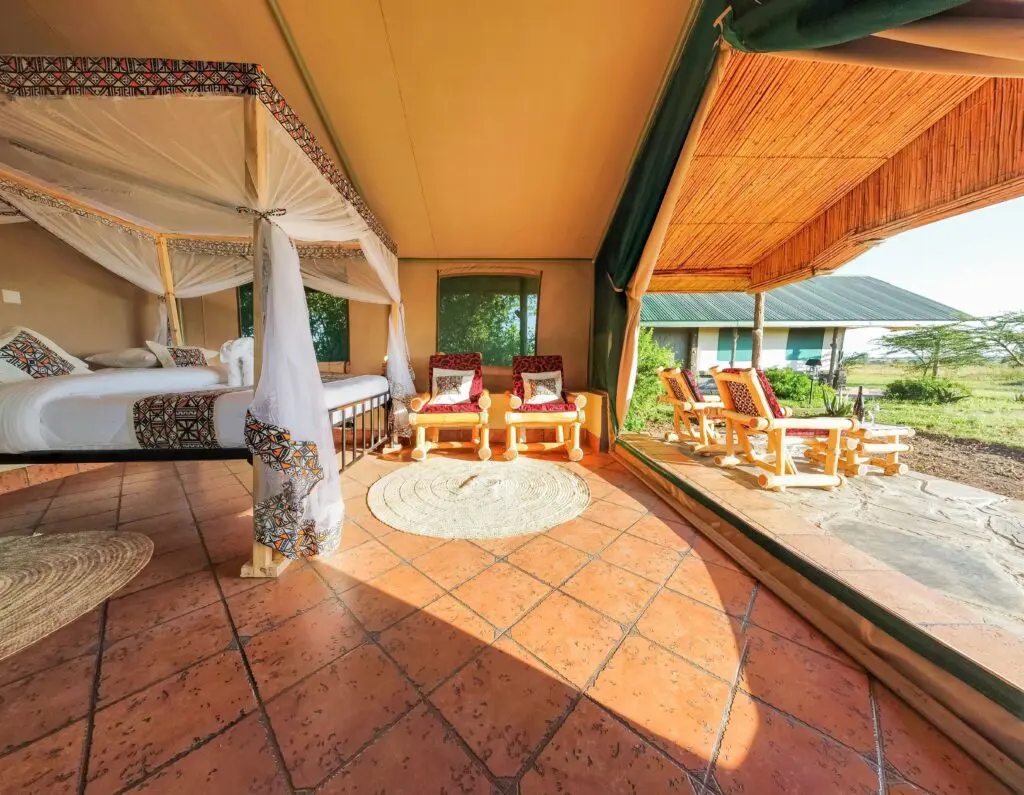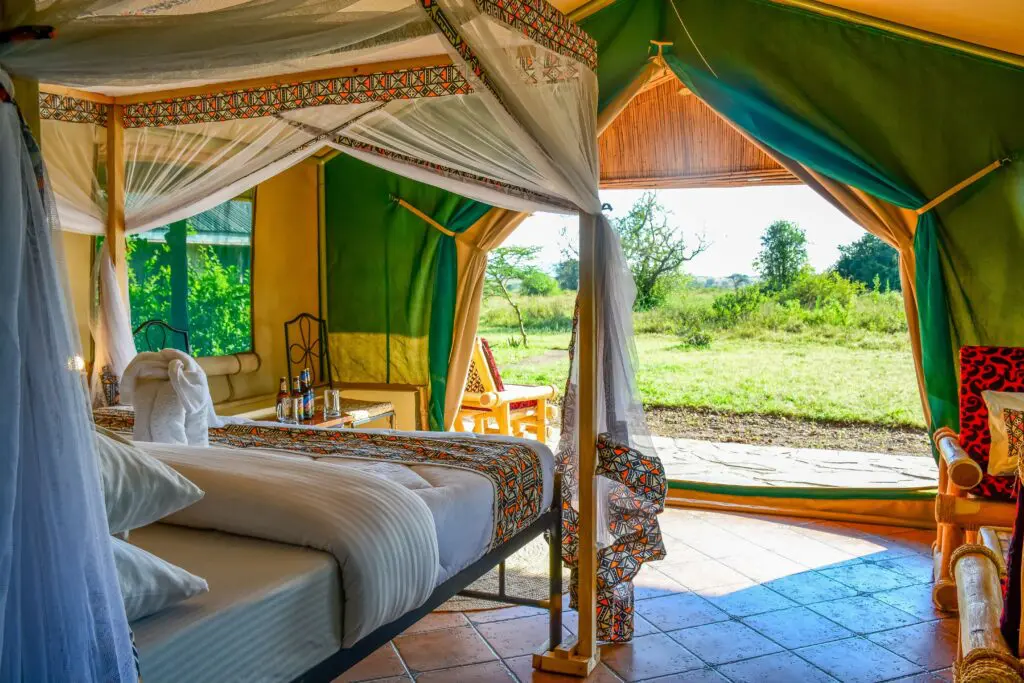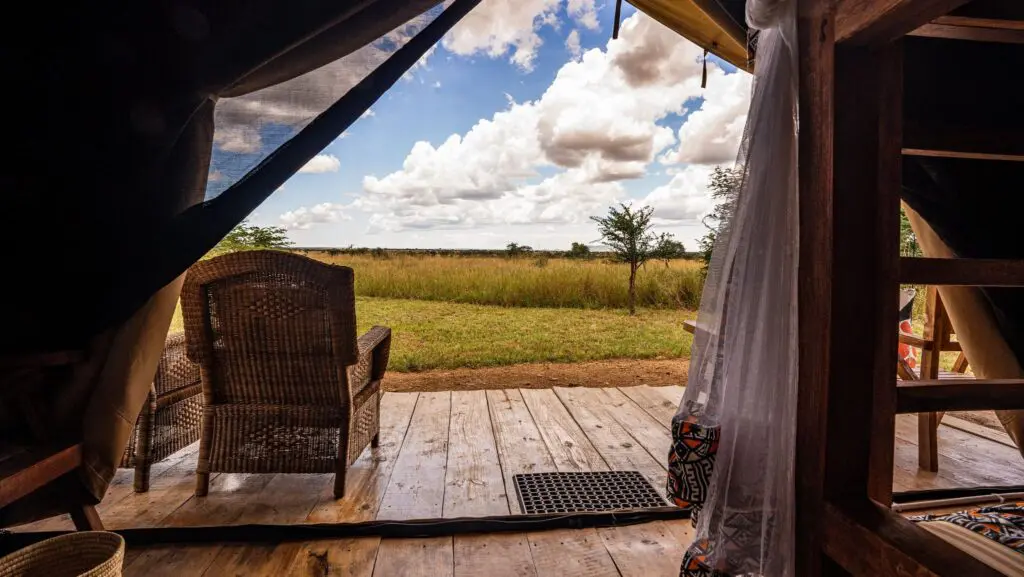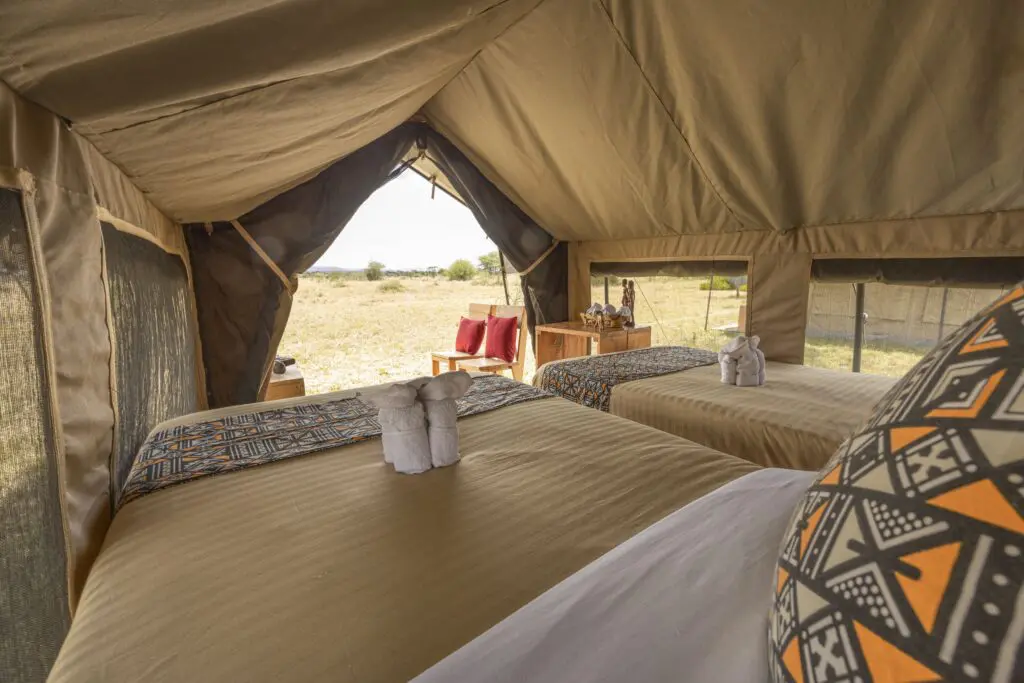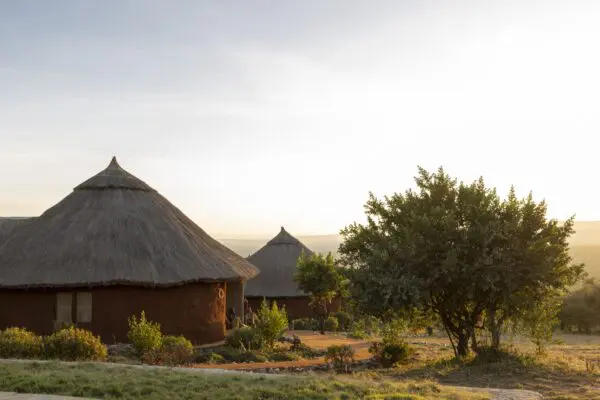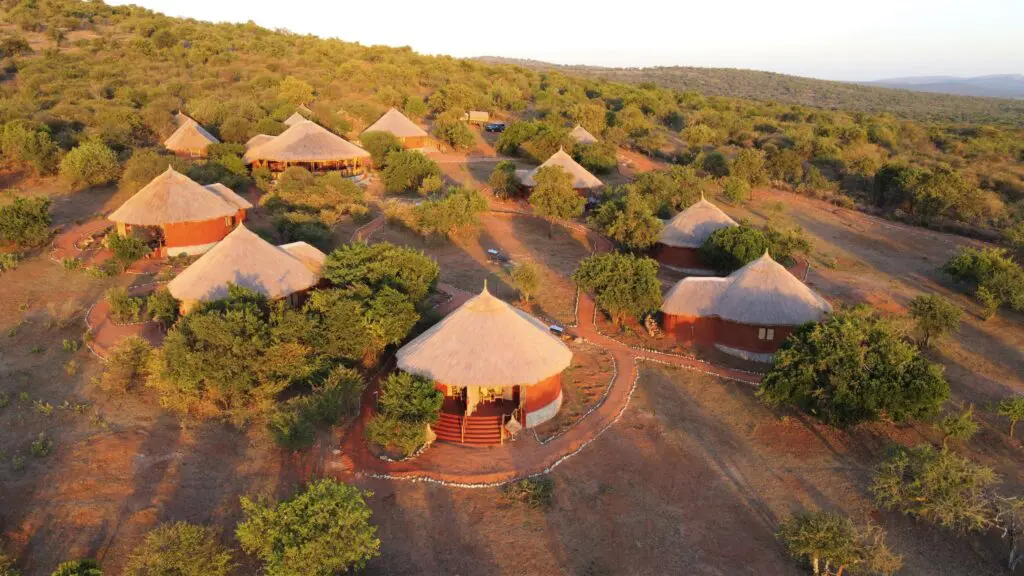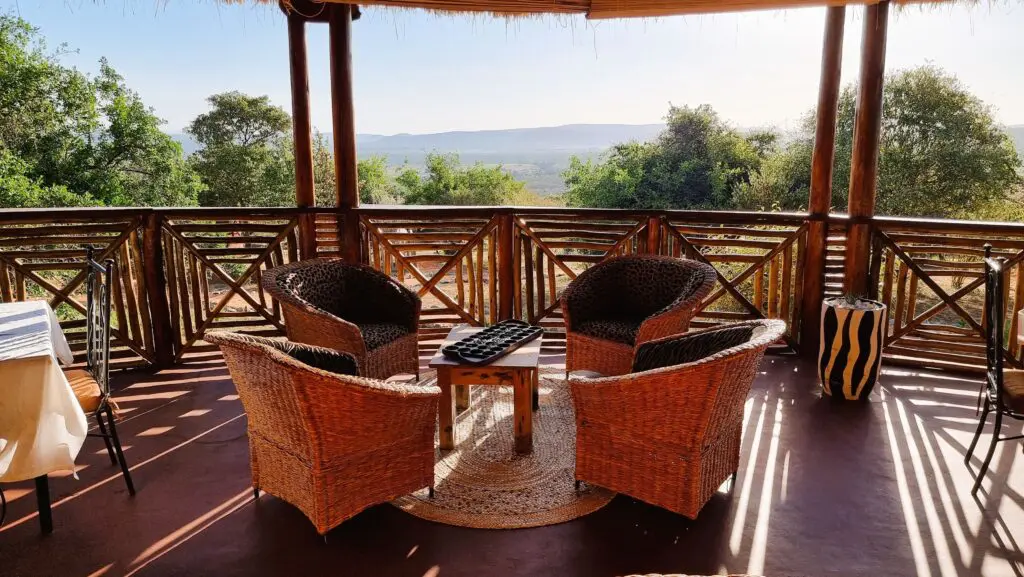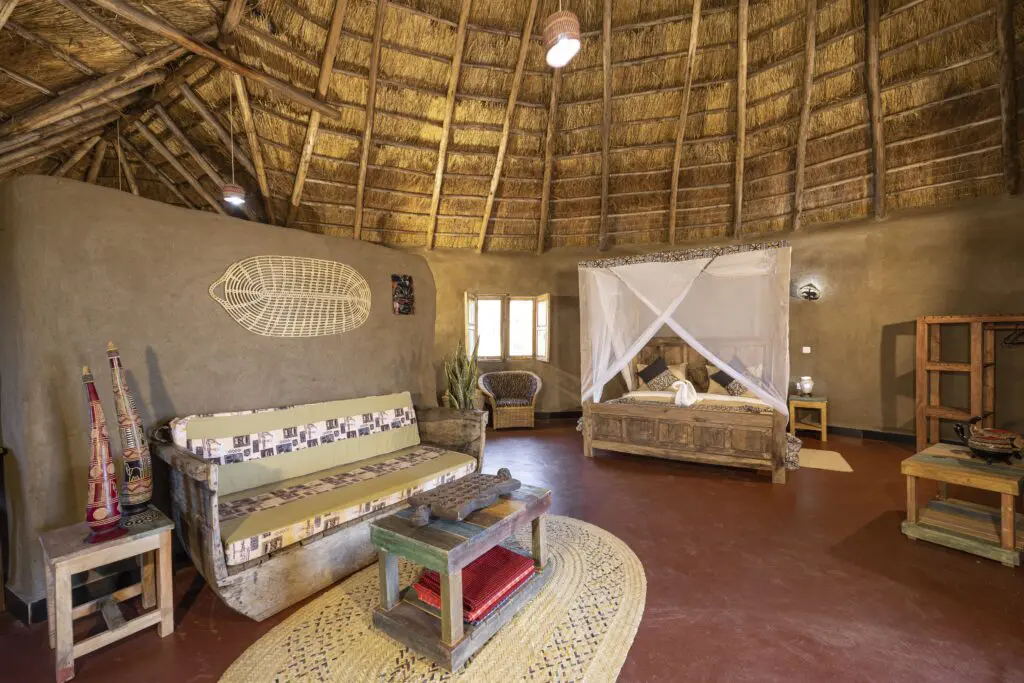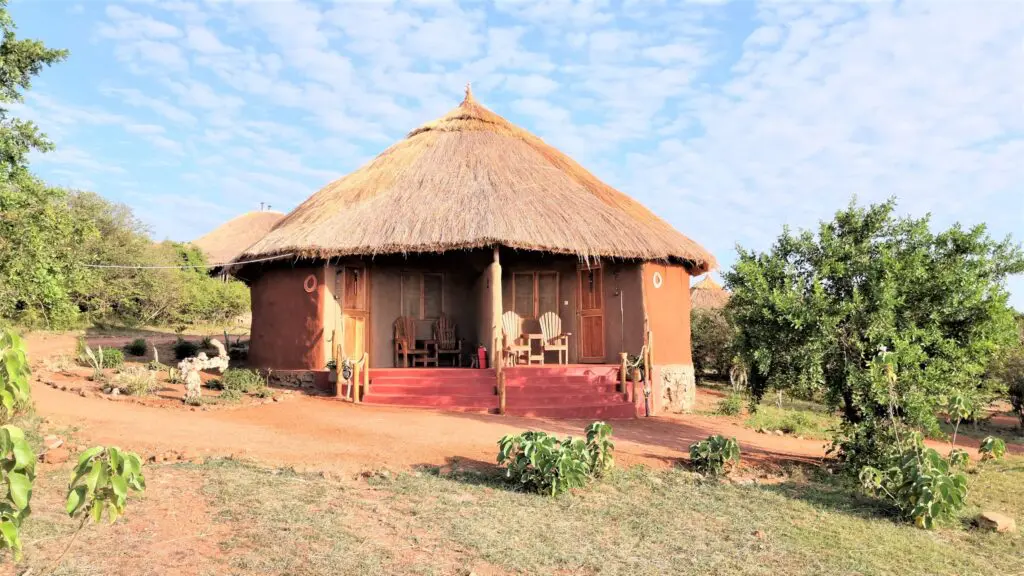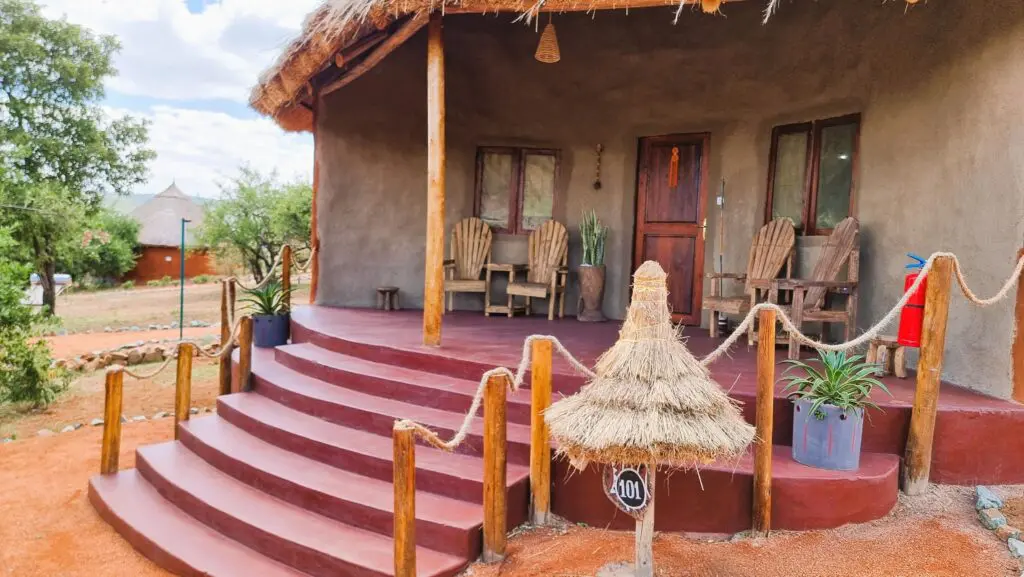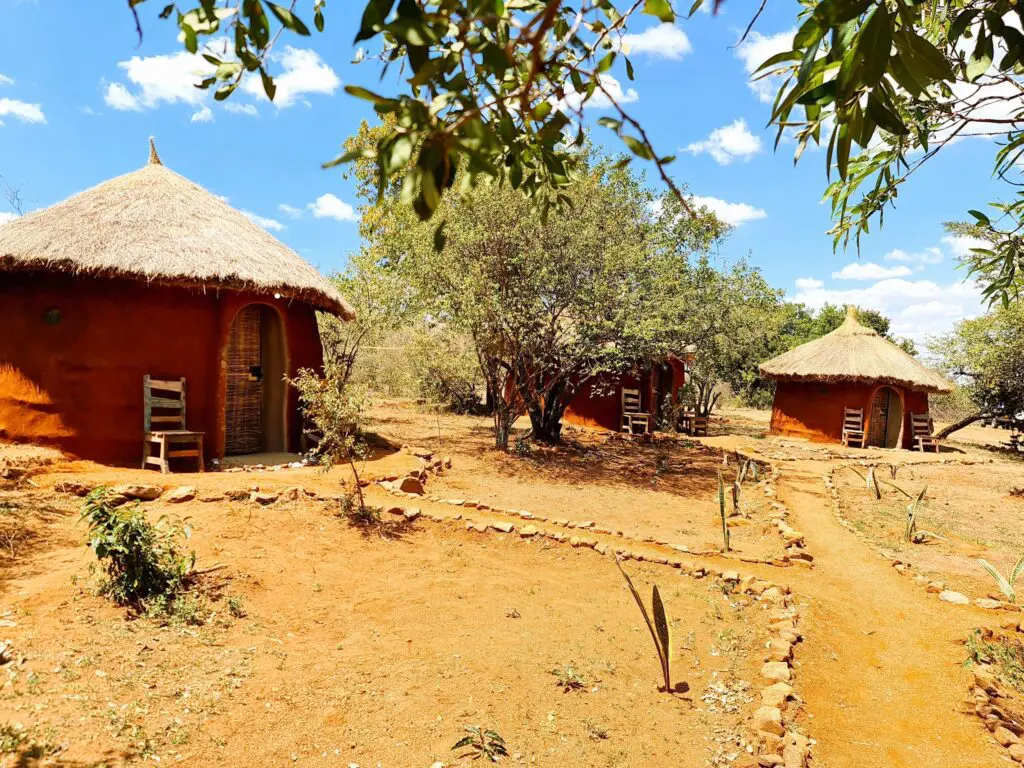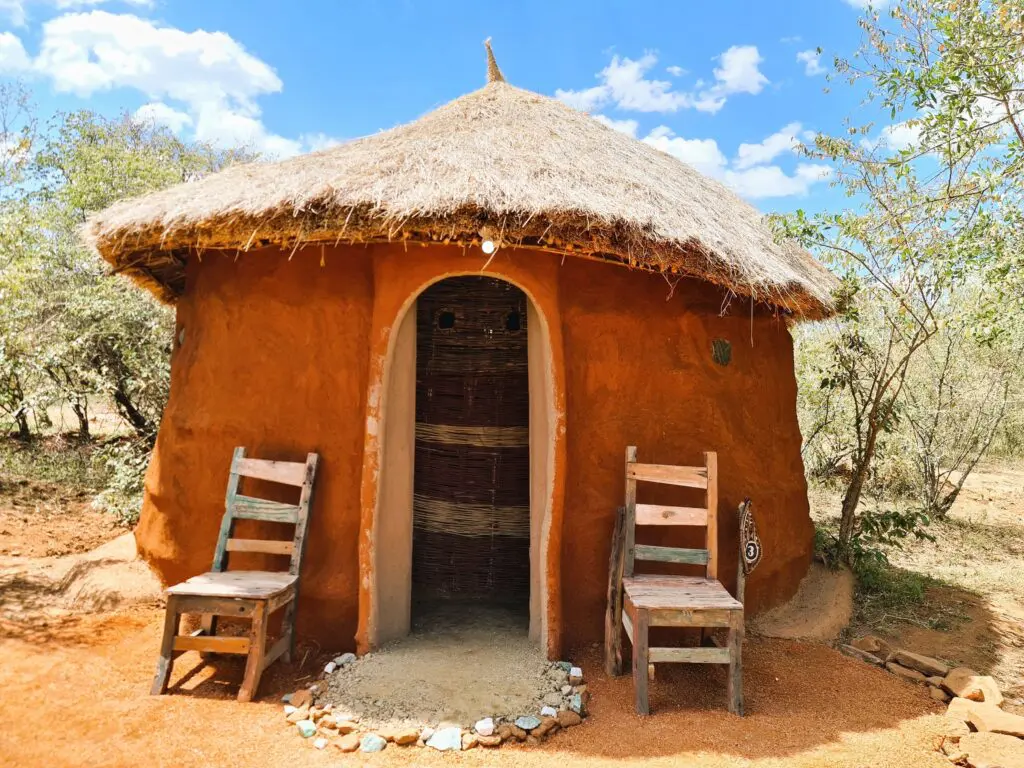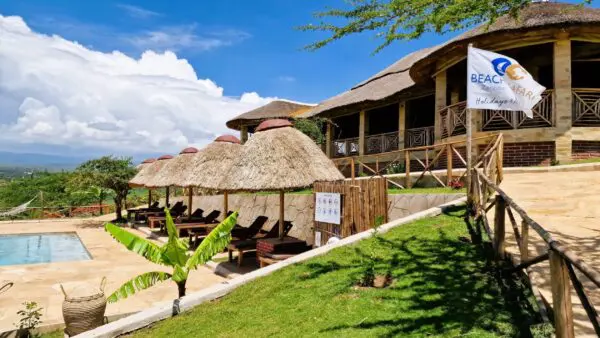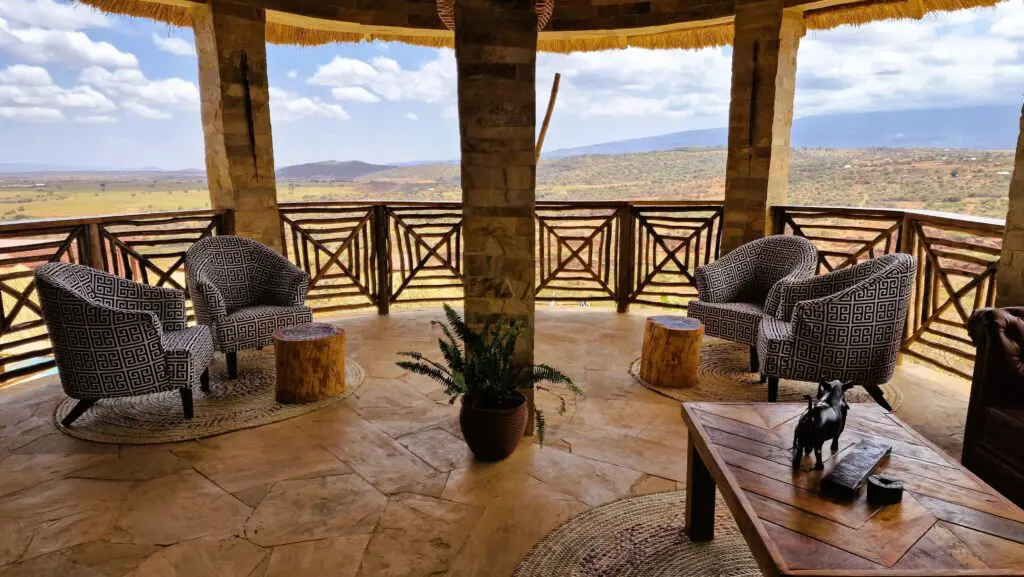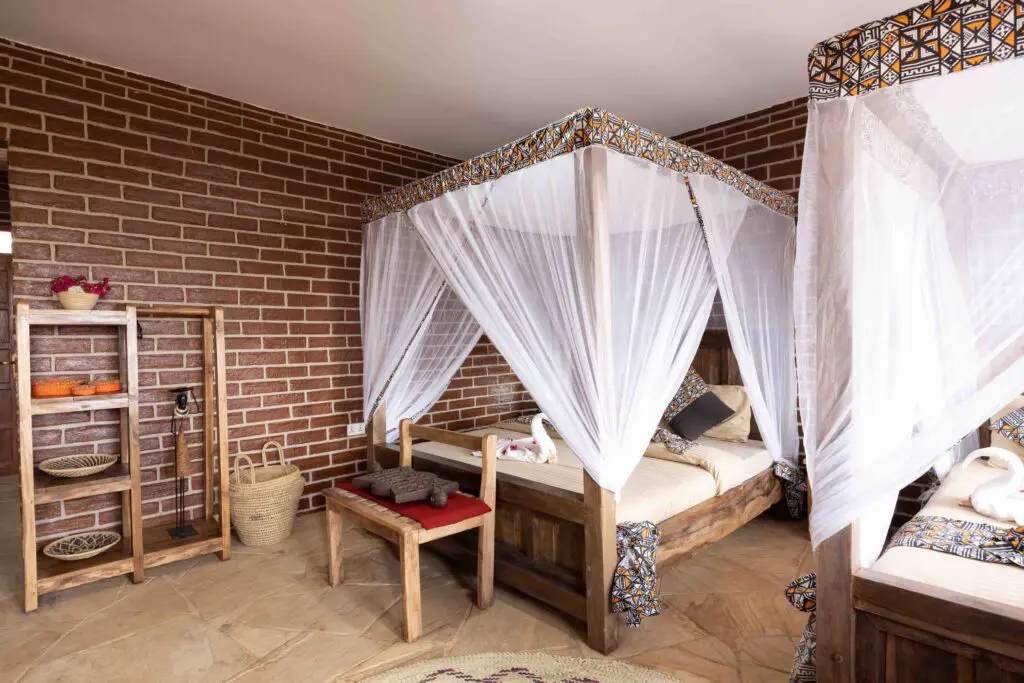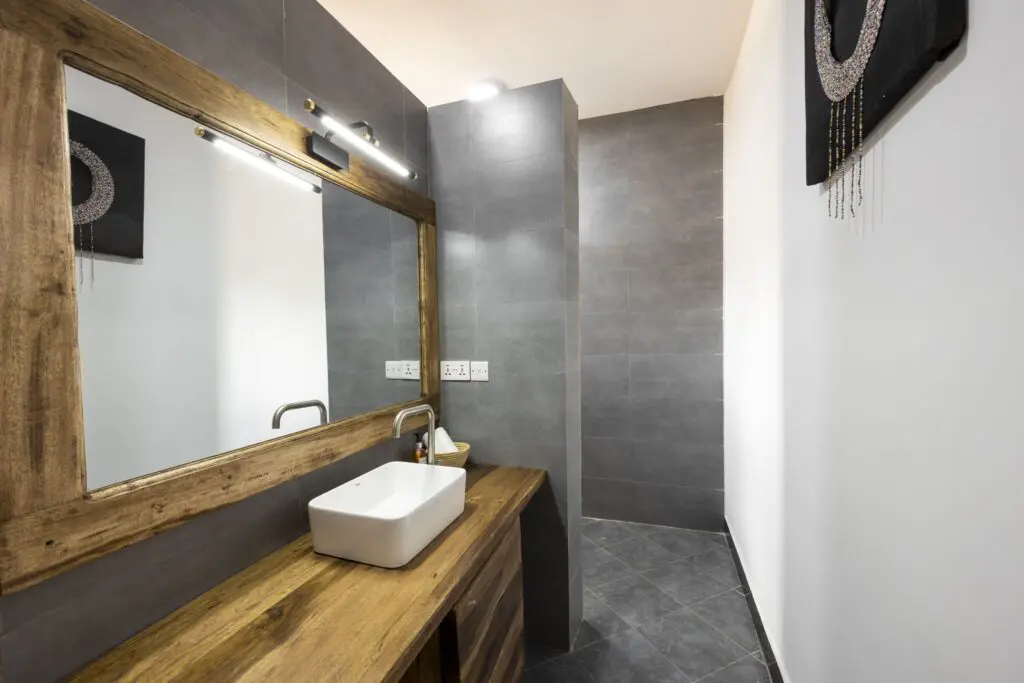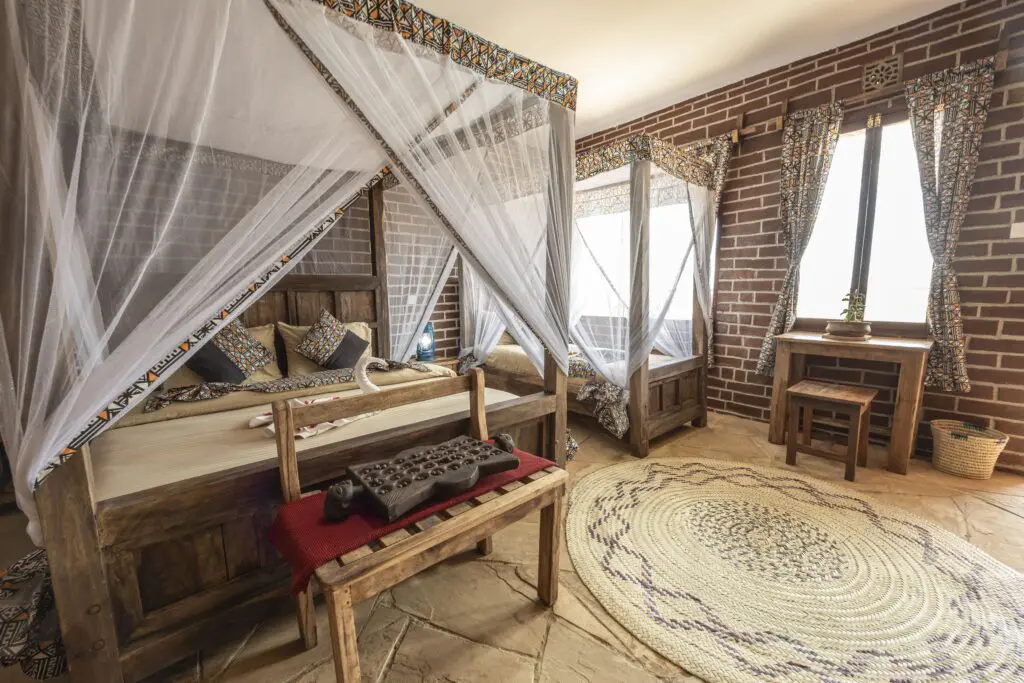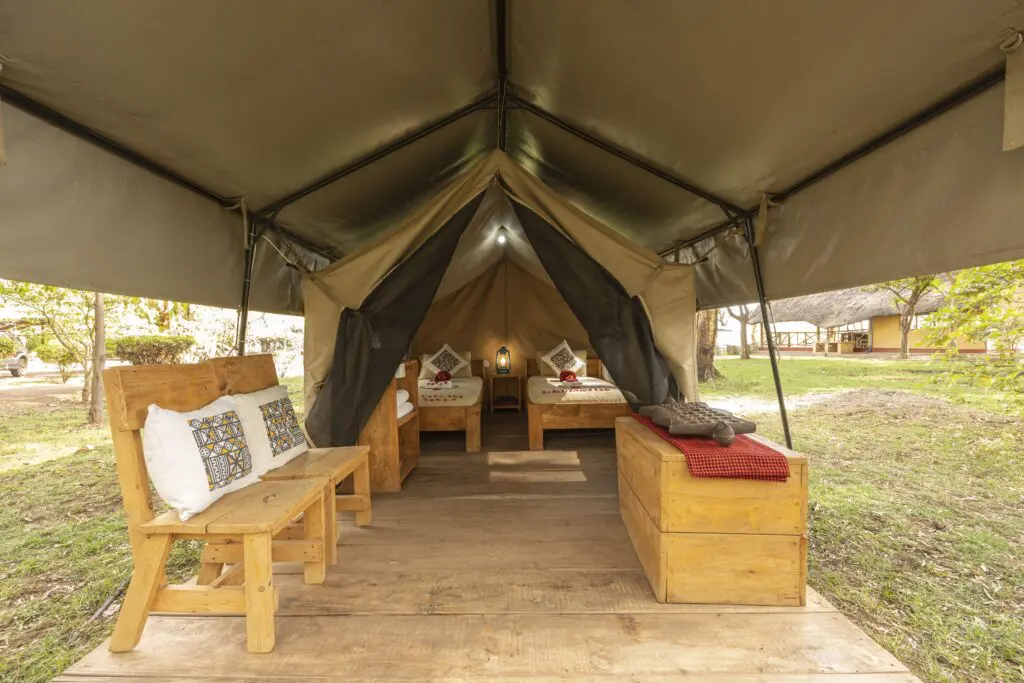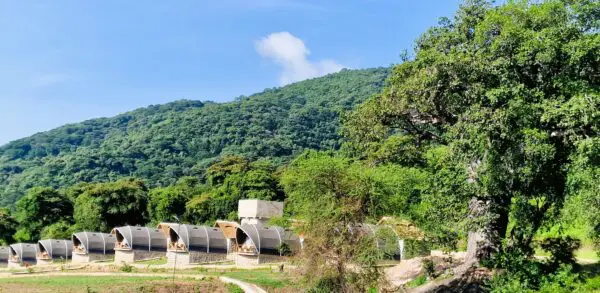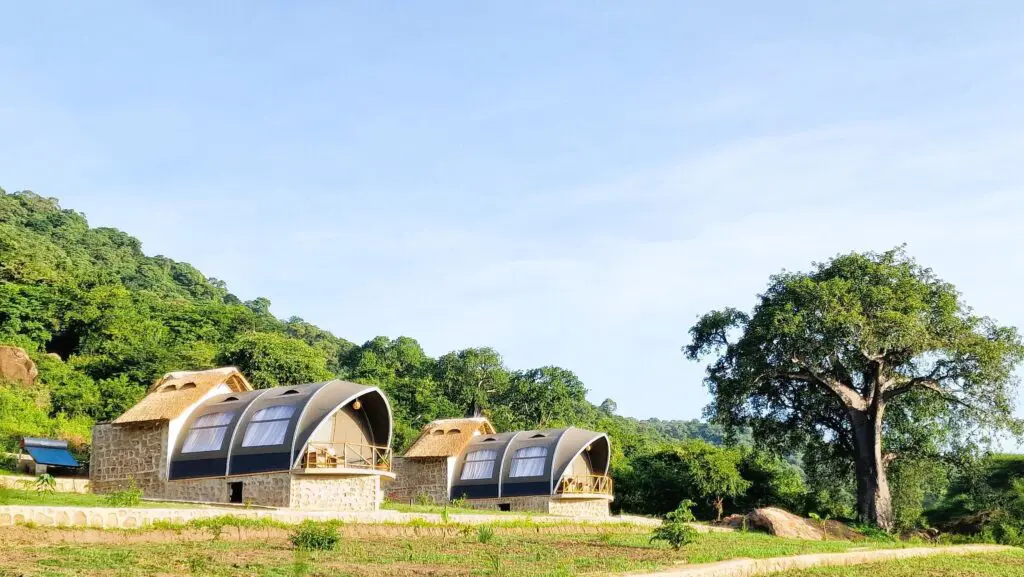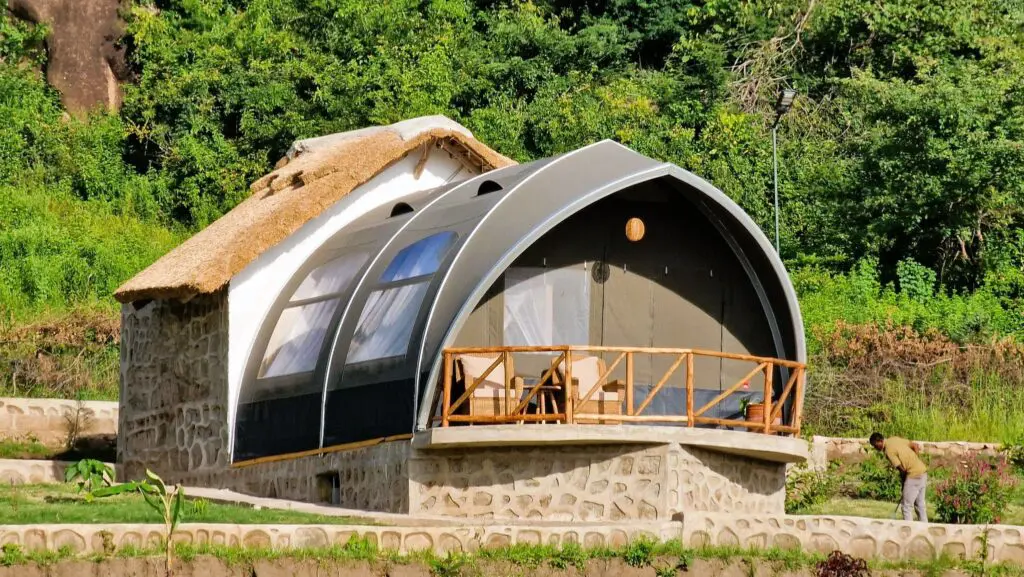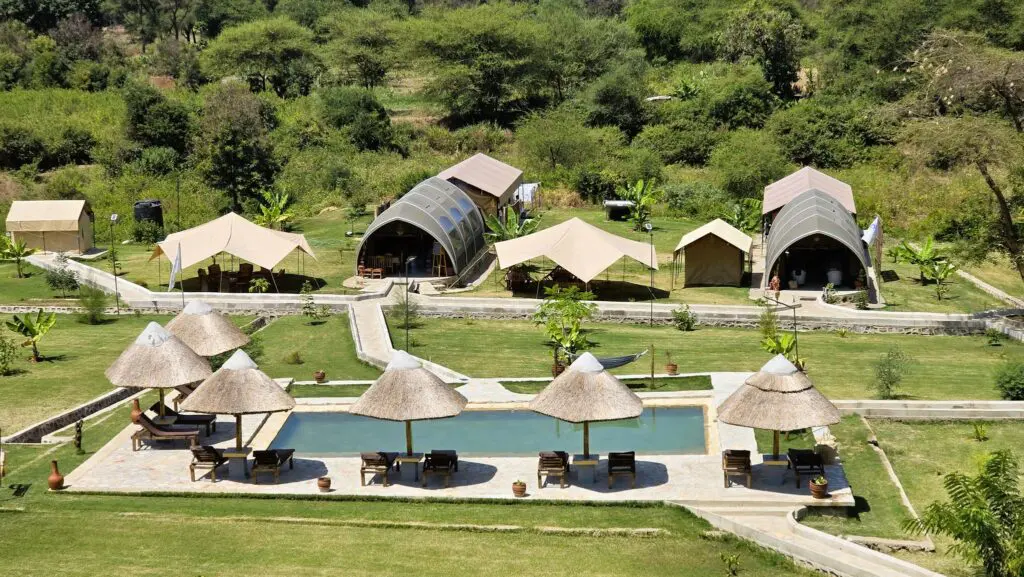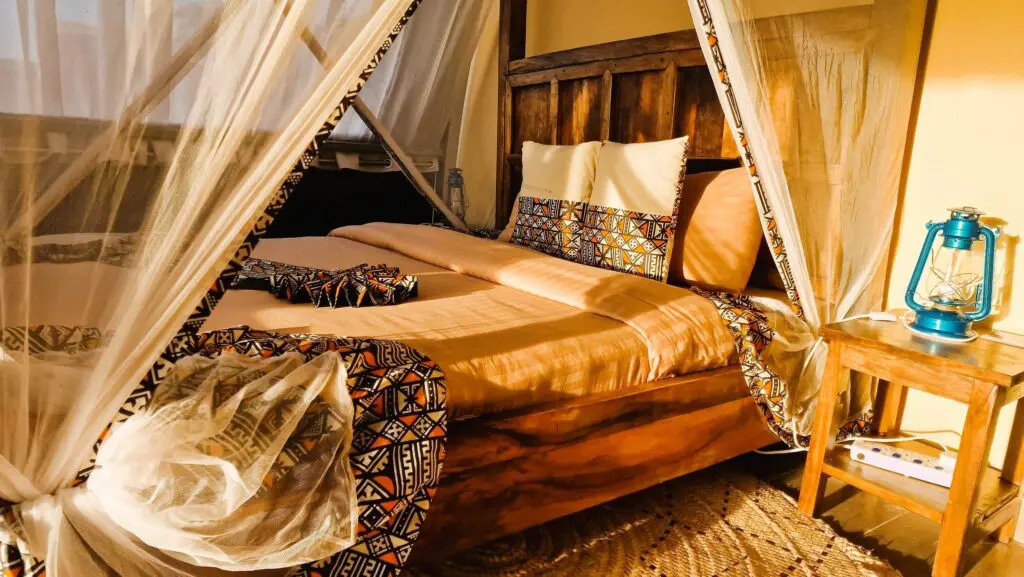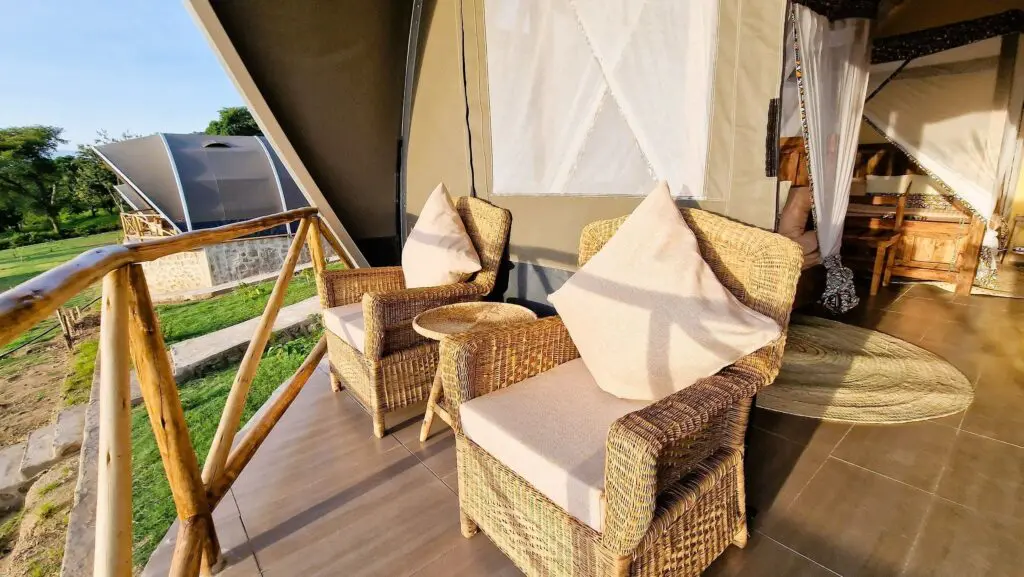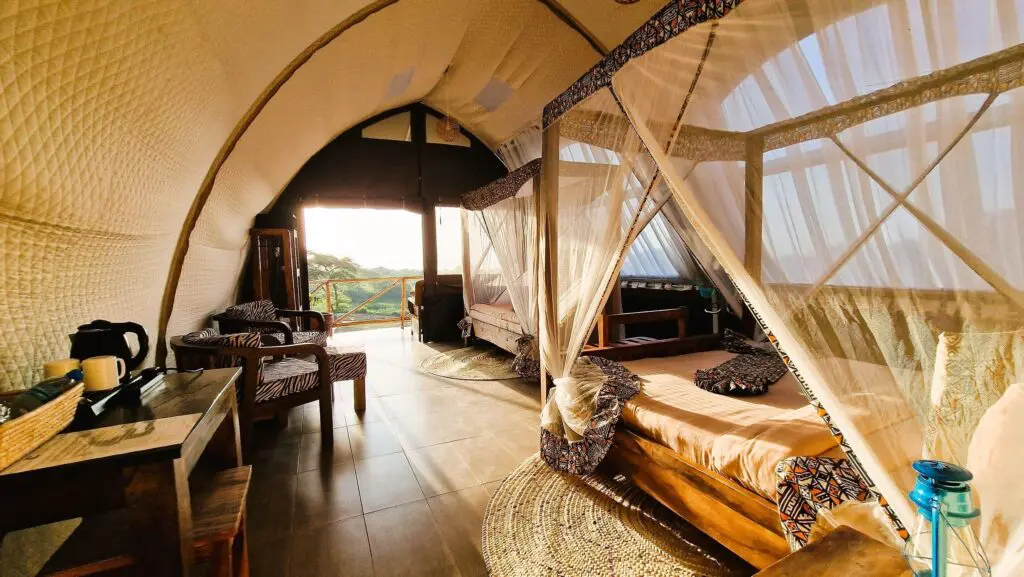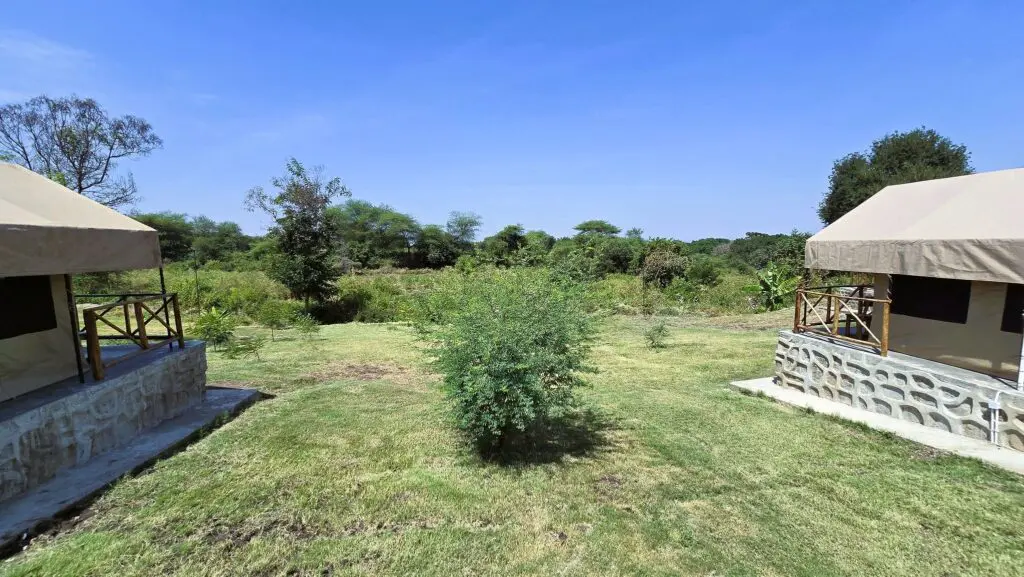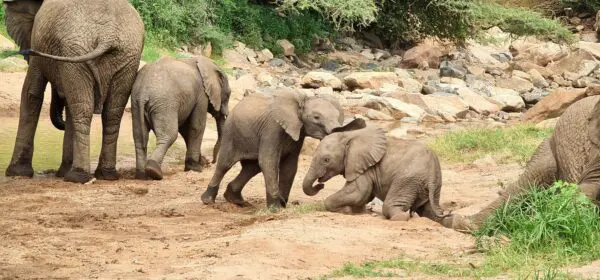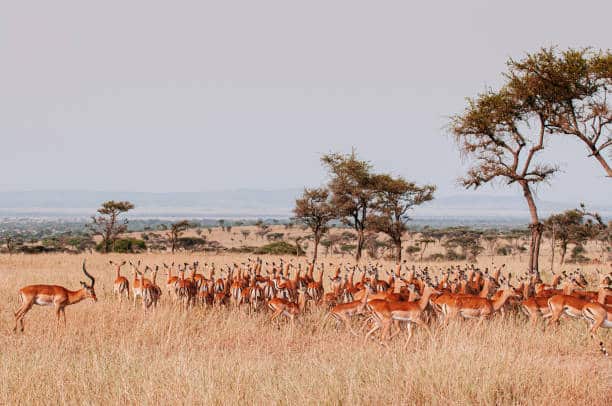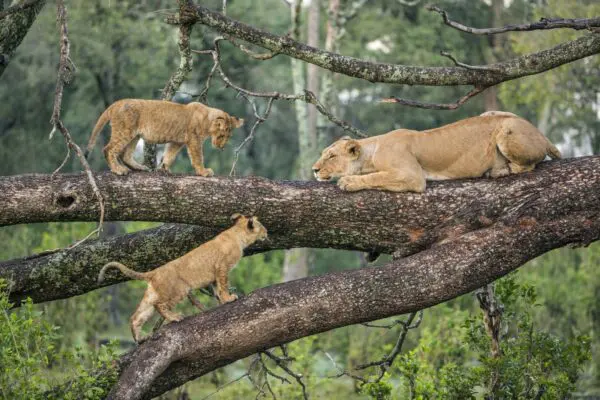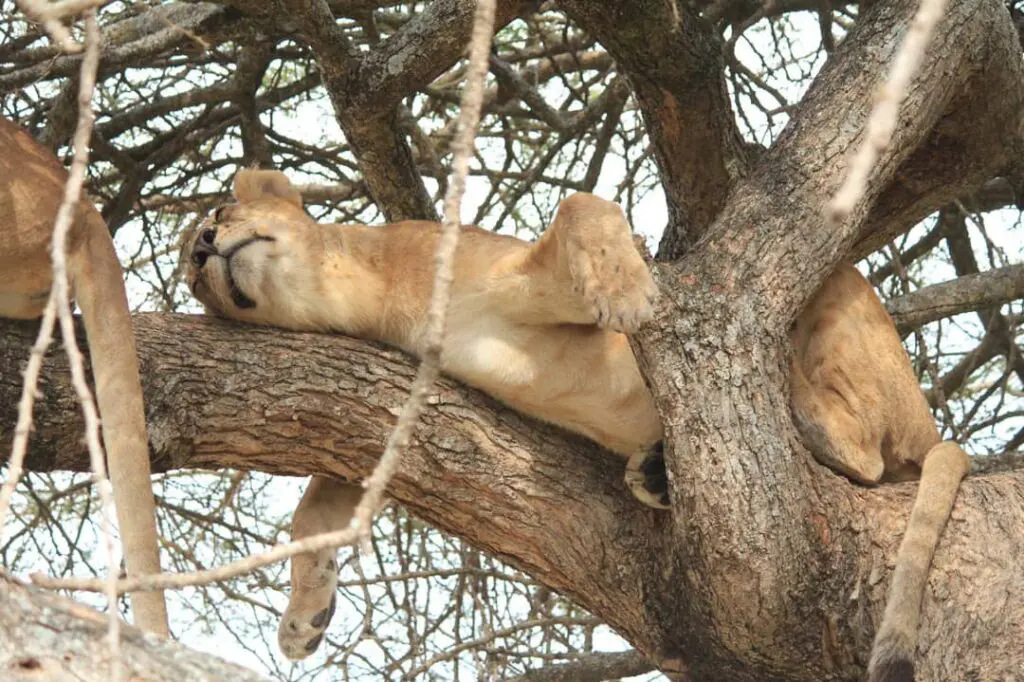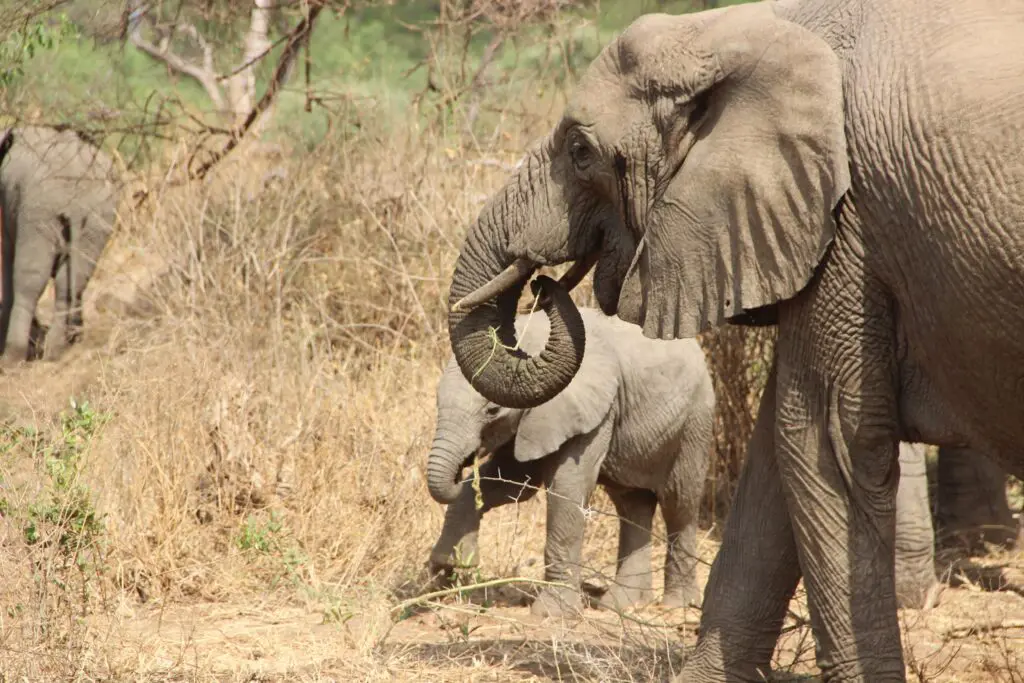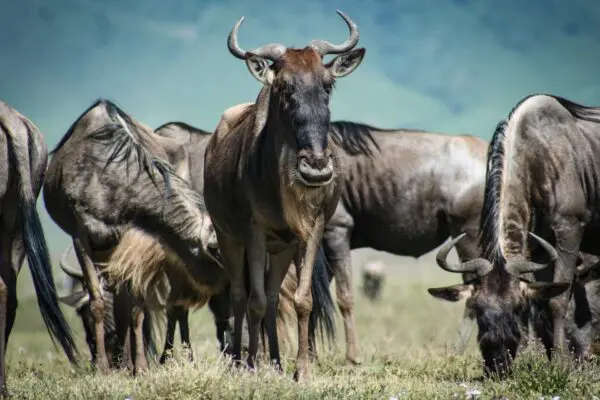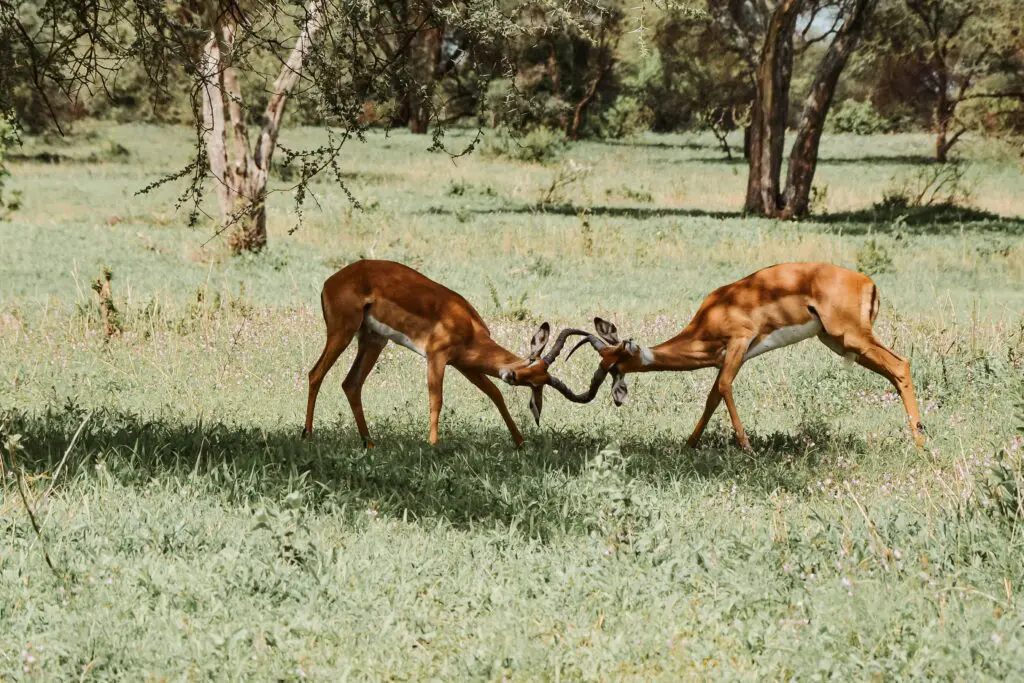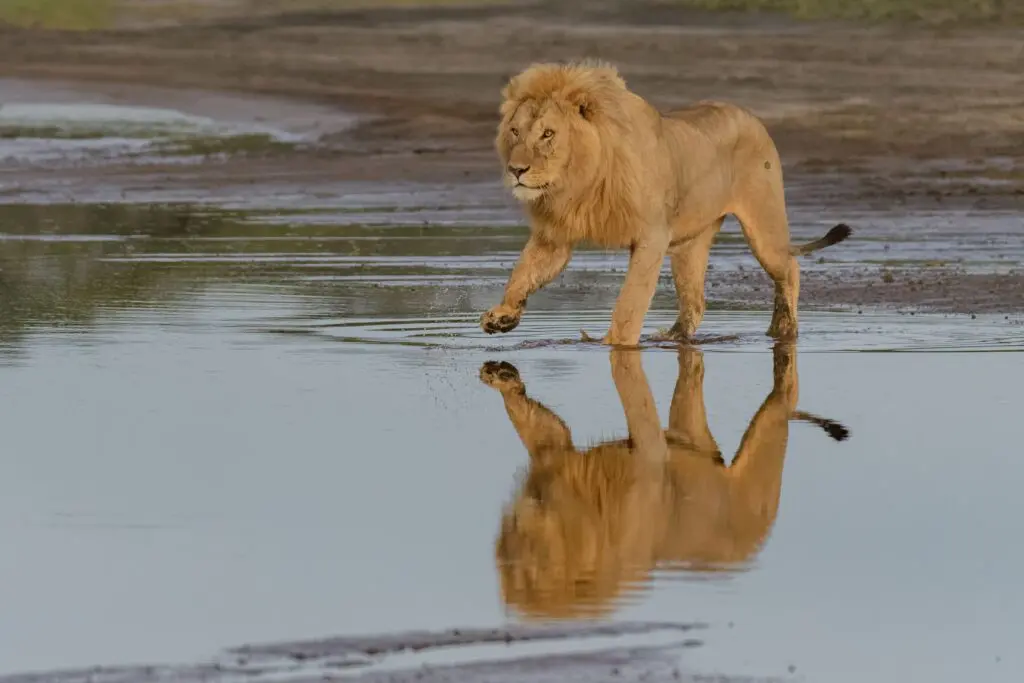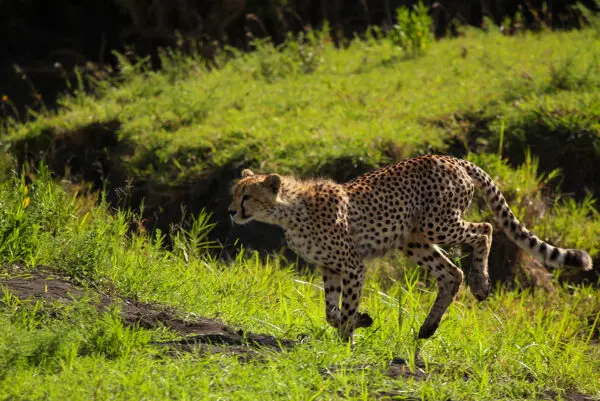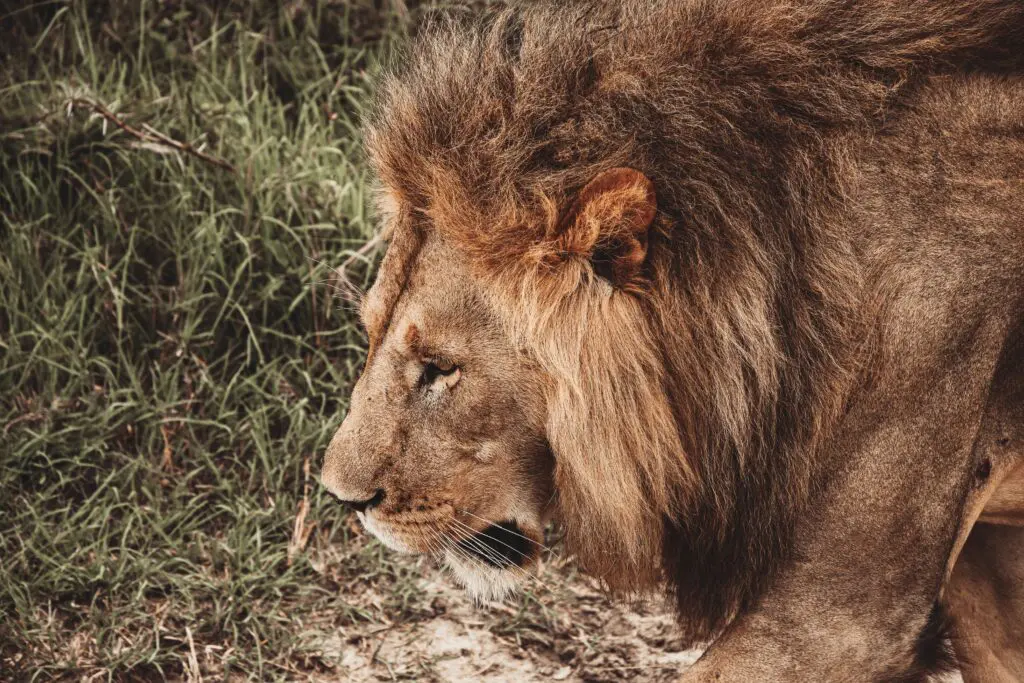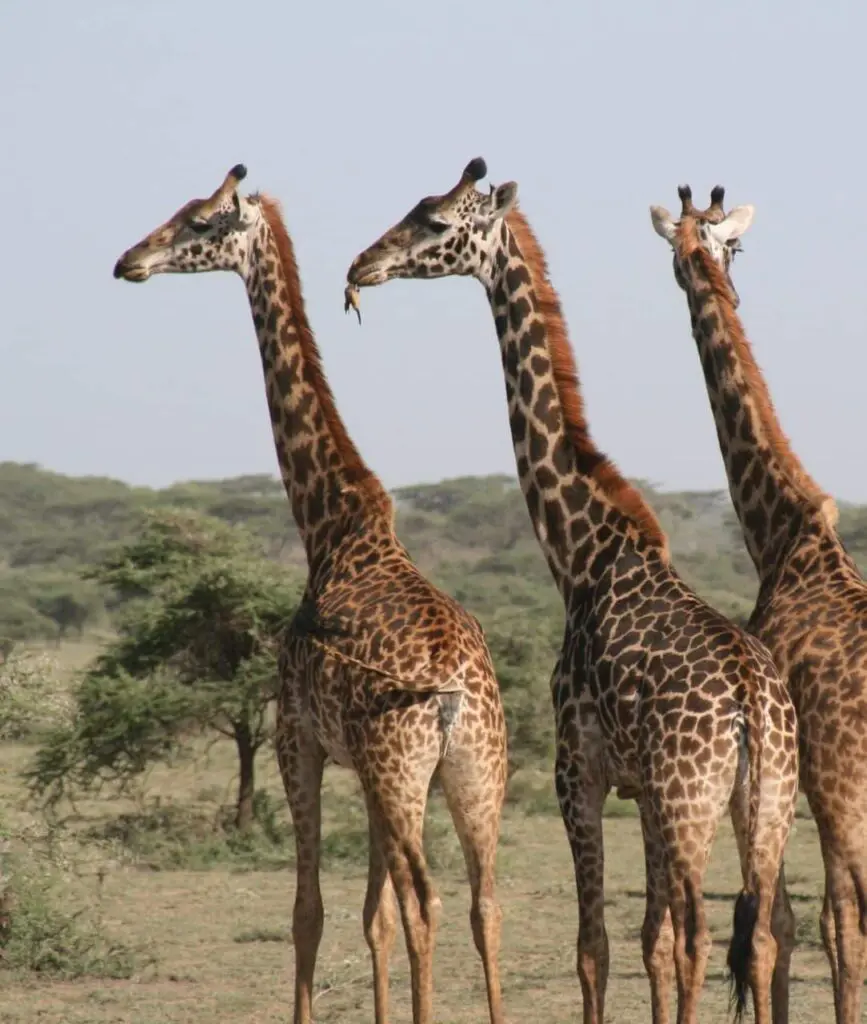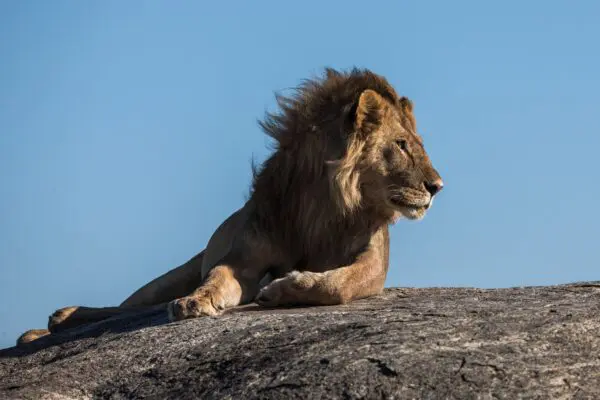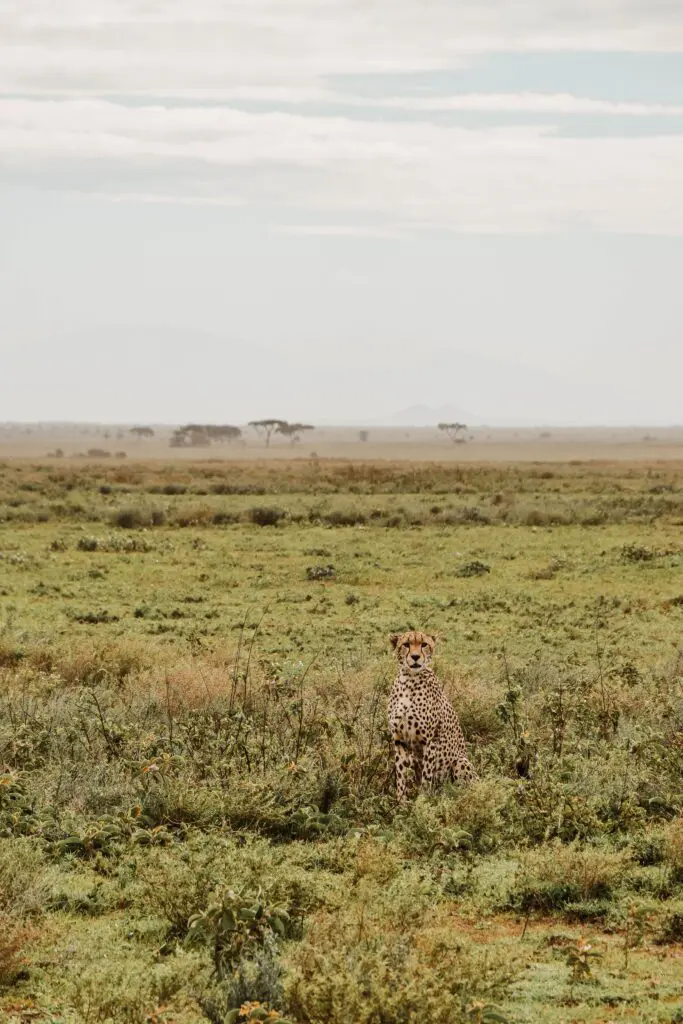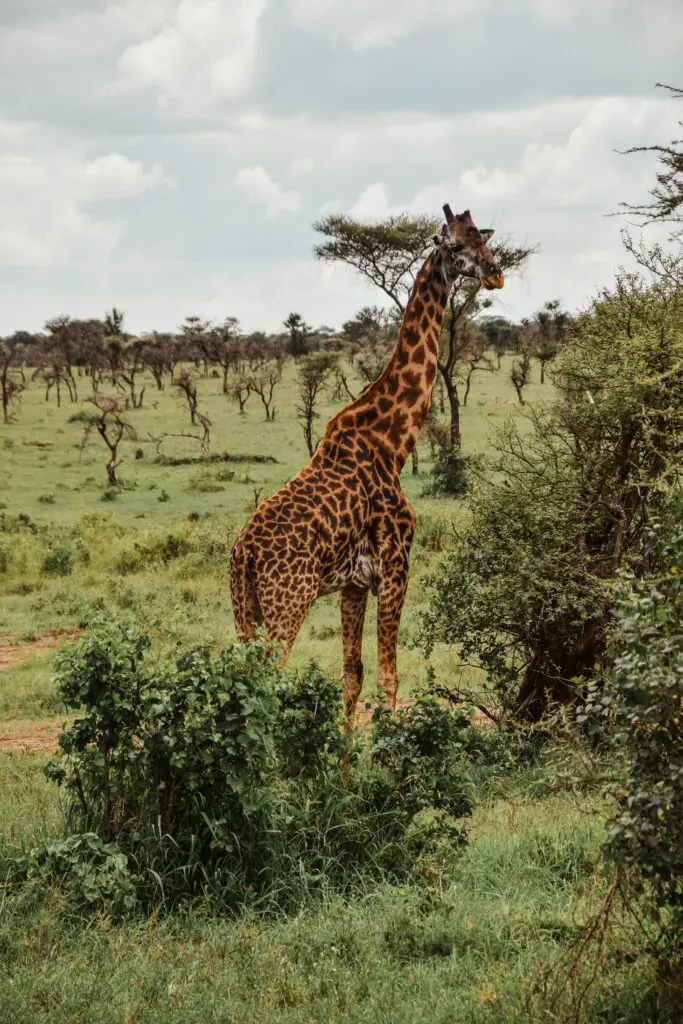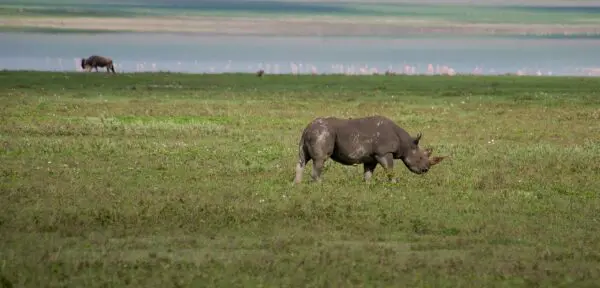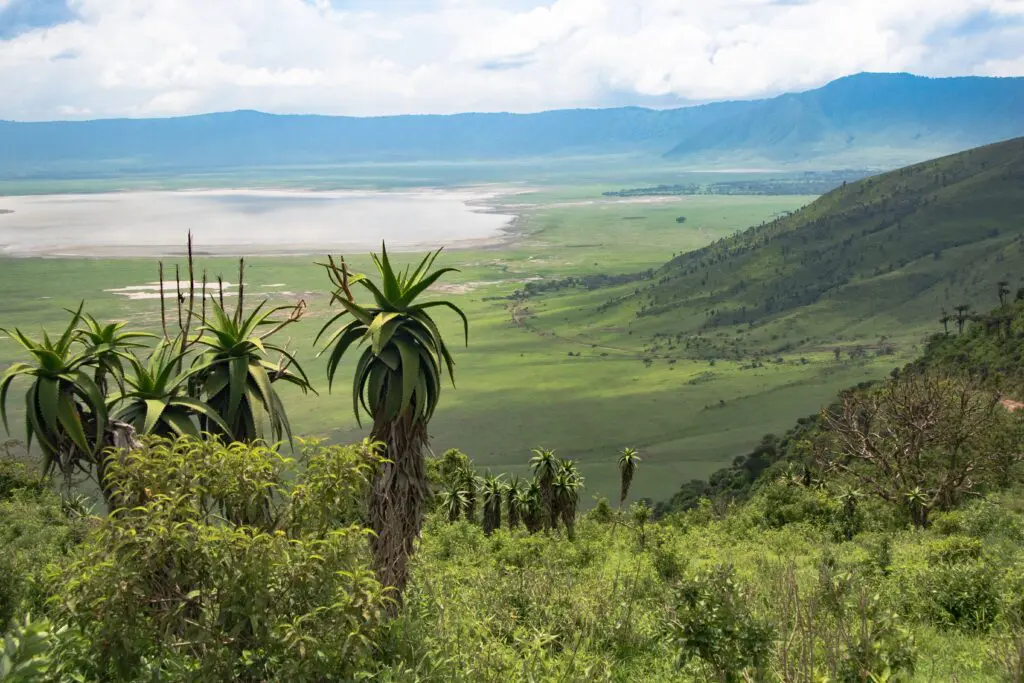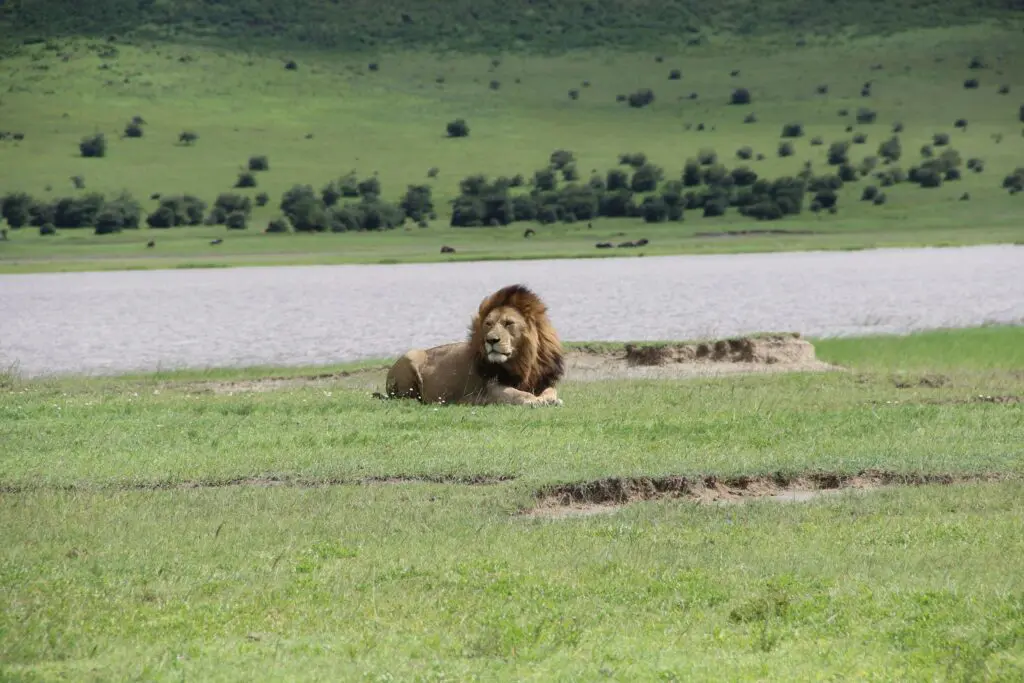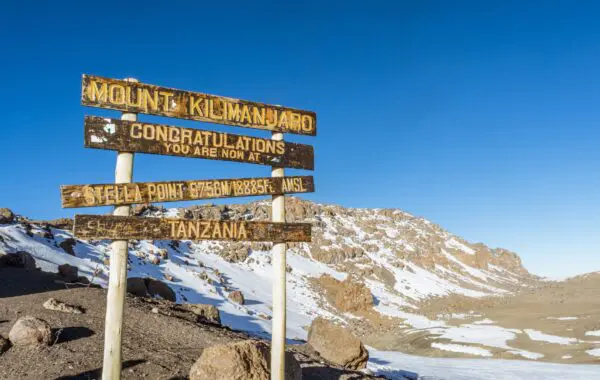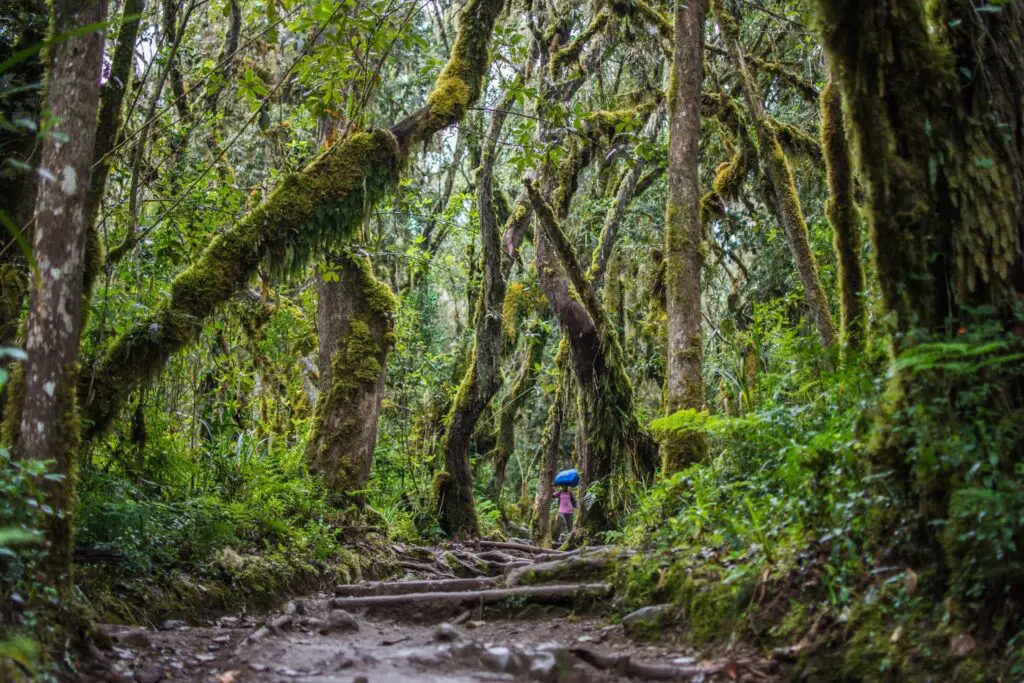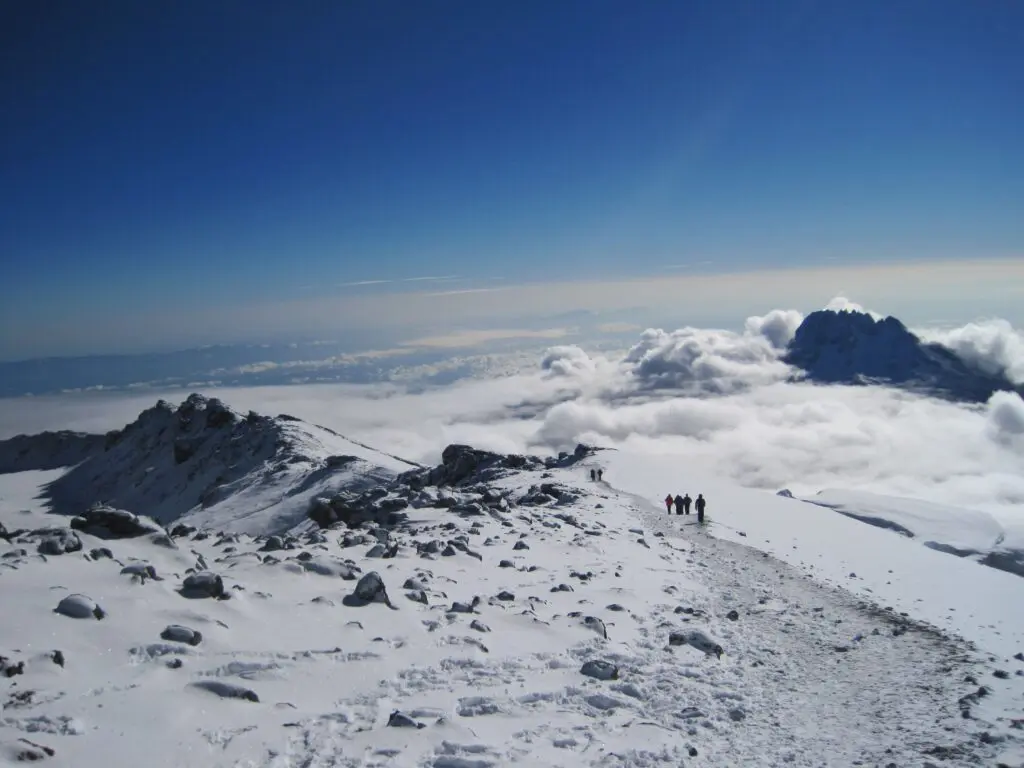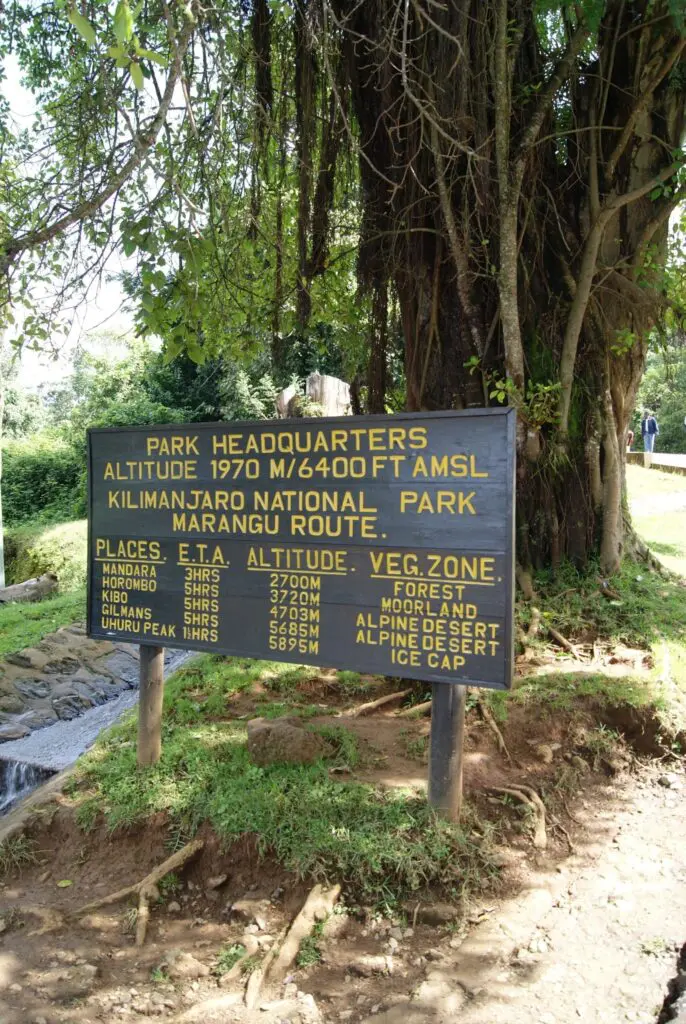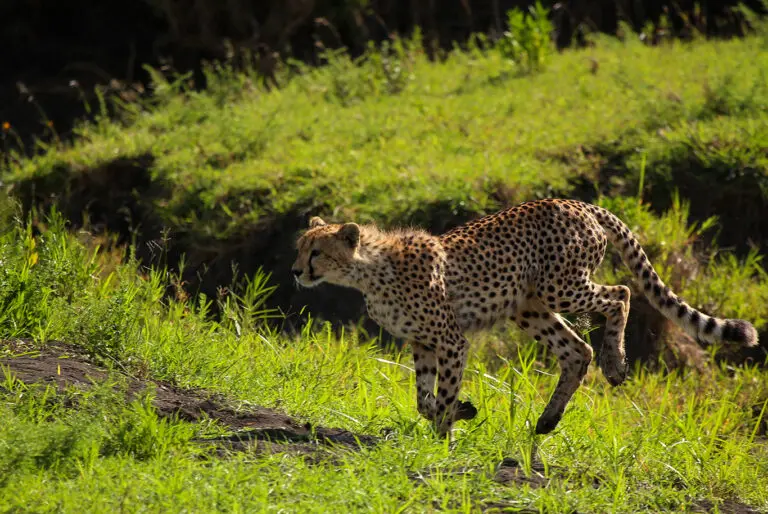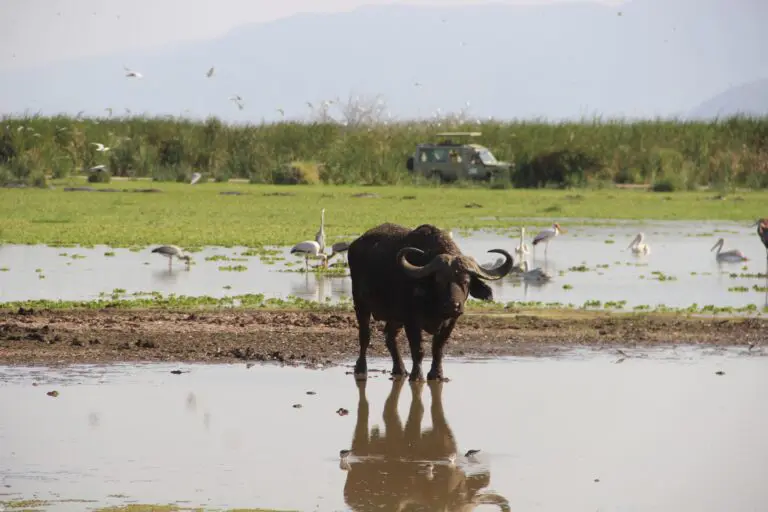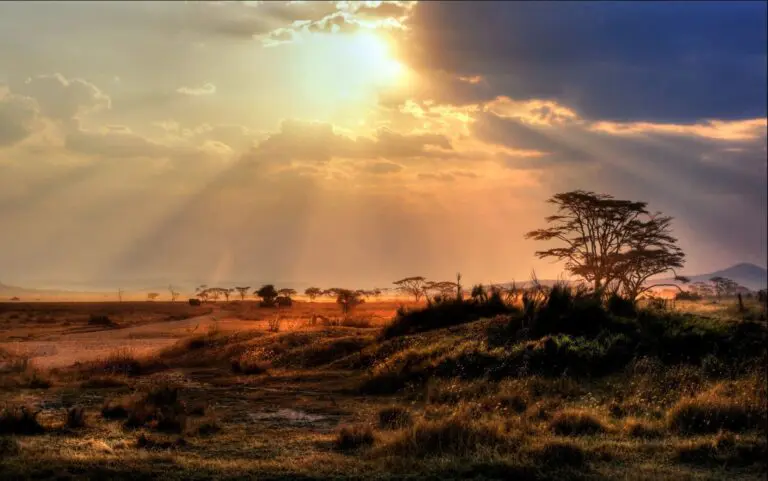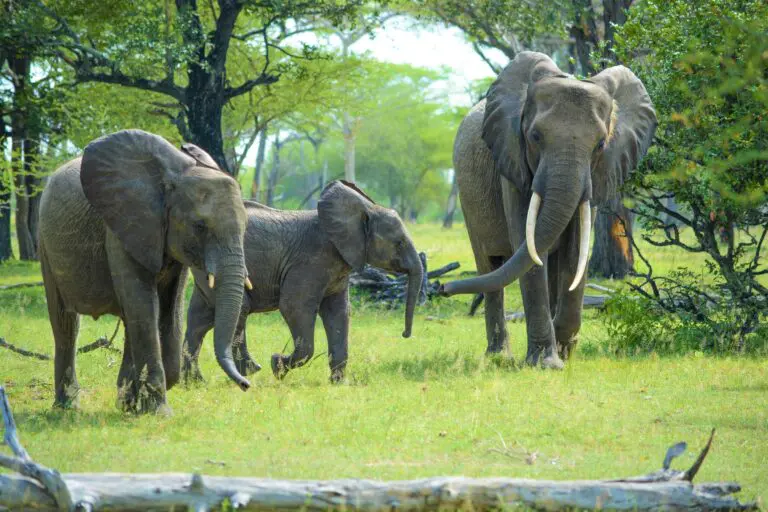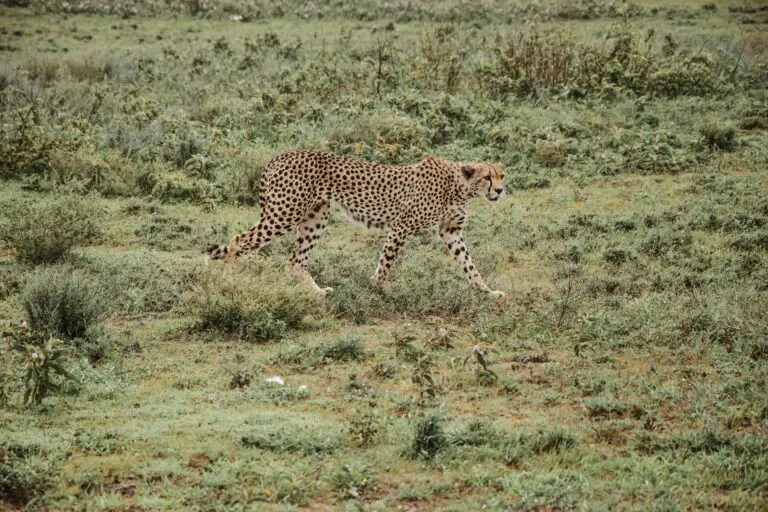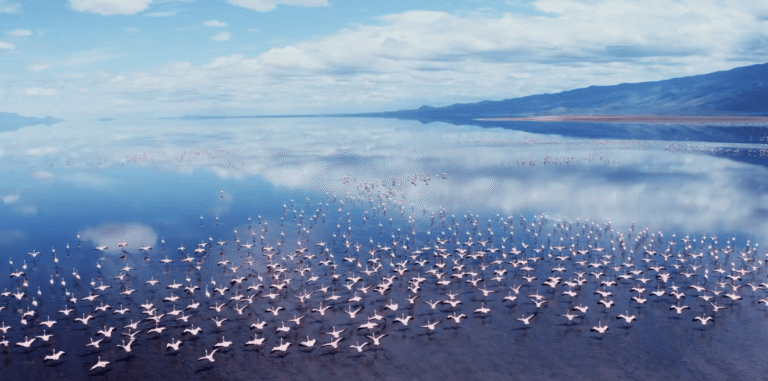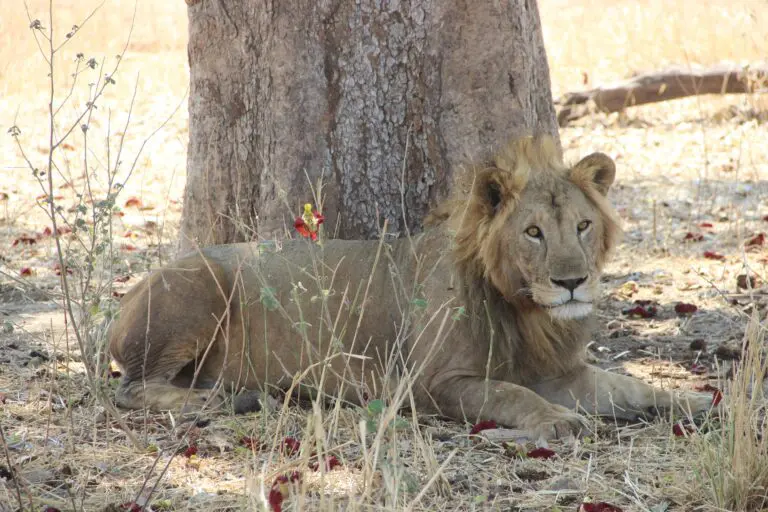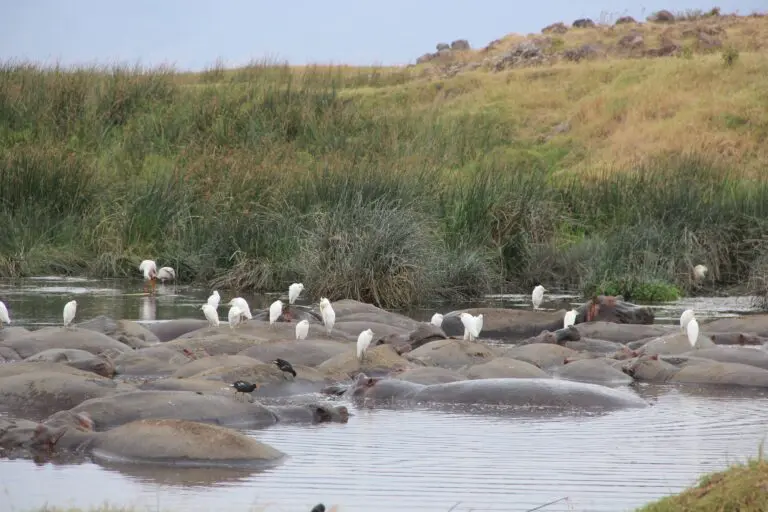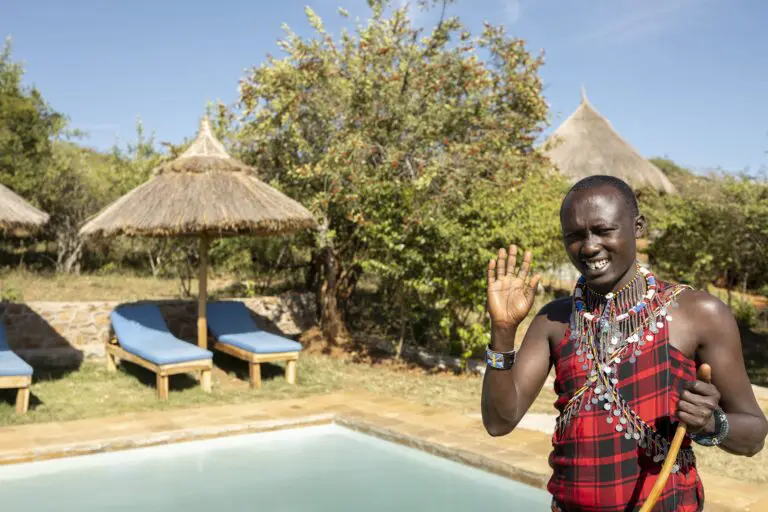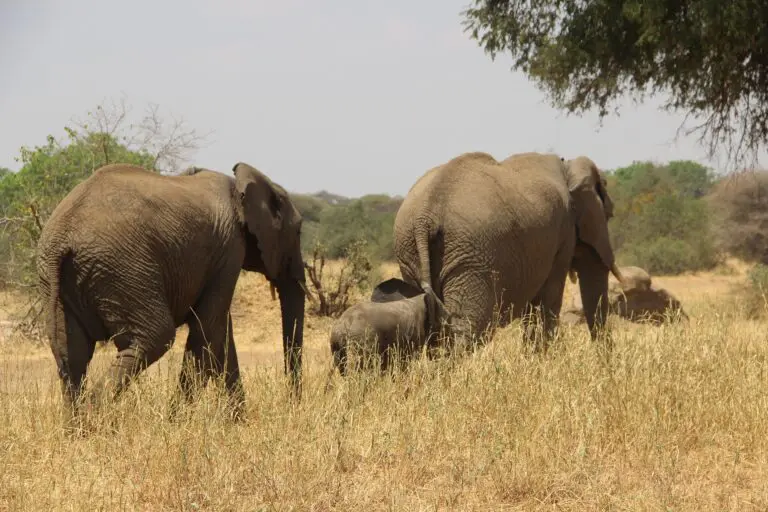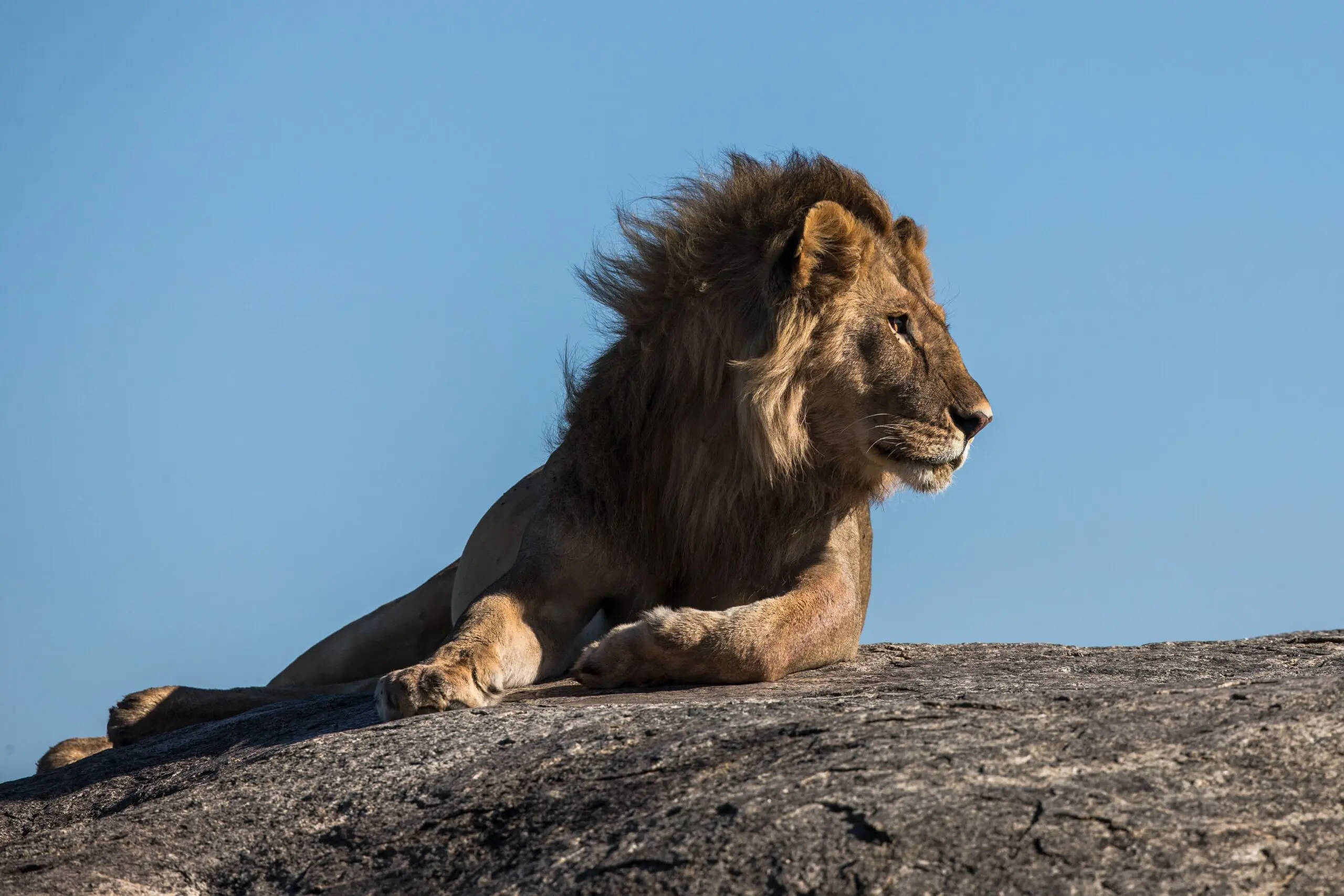
Complete Northern Circuit
13 Days | Complete Northern Circuit
The beating heart of the wilderness
Choose this ultimate safari tour of northern Tanzania, where the heart of African wilderness beats strong. Begin your journey in Lake Manyara National Park, a haven for flamingos and tree-climbing lions. The park’s tranquil lake and verdant landscapes provide an idyllic backdrop for captivating wildlife encounters. Trek on to Tarangire National Park, where ancient baobabs stand guard over a realm full of elephants and various other wildlife. The iconic Serengeti National Park beckons with its vast savannahs and the mesmerizing spectacle of the Great Migration.
Highlights
- Ngorongoro Crater
- Lake Manyara National Park
- Serengeti National Park
- Walking safari
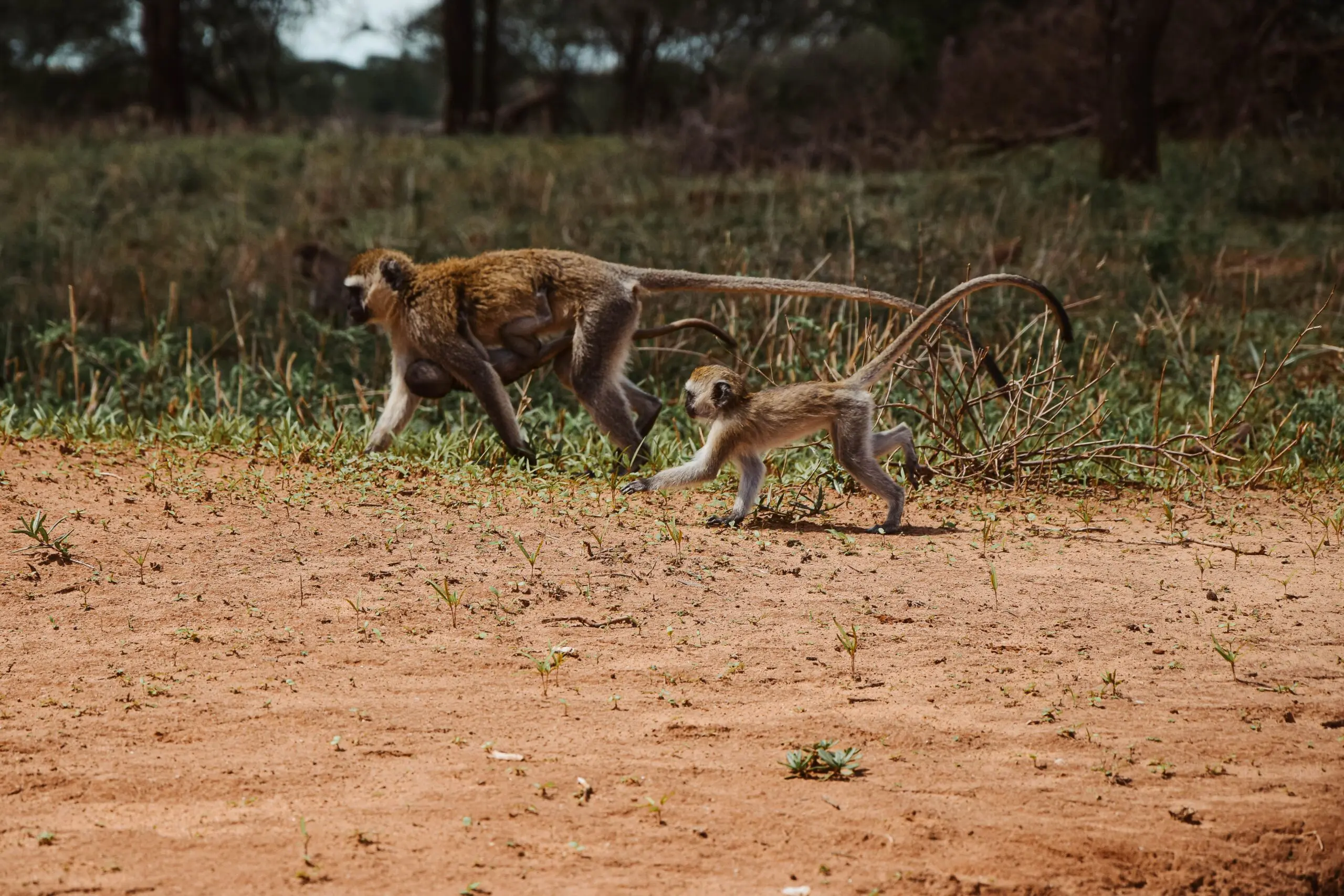
Prices
-
2 persons
in 1 room € 4.081,- p.p. -
4 persons
in 2 rooms € 3.298,- p.p. -
6 persons
in 3 rooms € 3.037,- p.p.
Including ia
- Water in the safari jeep
- Pick-up & Drop-off at the airport or in Arusha
- Park fees for the national parks described
- African 4×4 safari jeep with pop-up roof and large windows
Features & FAQ
A safari and stay in Tanzania is completely safe. All our drivers and guides are experts in this field and have undergone extensive training to properly handle nature and animals. All necessary precautions are also taken at our accommodations to provide you with a safe place to stay.
No, this is unfortunately not possible. Due to the safety of you and the wildlife, it is not allowed to drive around on your own. A specialized guide and driver is therefore always included in our tours.
You can choose this for yourself. We offer tents or bungalows at all our resorts with private bathrooms, good beds and electricity. We also offer budget-proof safari tents at some resorts. These are more basic and have a shared bathroom. In addition, many of our resorts feature a swimming pool, restaurant, gym and public area with Wi-Fi.
Yes, there are differences in animals between northern and southern Tanzania, although they largely overlap. Both regions offer impressive wildlife experiences, but the type of landscape, concentration of animals and the way you experience them differ. Here's a clear overview:
- In northern Tanzania, you'll find iconic nature reserves such as the Serengeti and Ngorongoro Crater. Here you will see large herds of wildebeest and zebra during the Great Migration, impressive lion prides, and have the best chance of spotting the rhinoceros, one of the few places in Africa where you can complete the Big Five.
- Southern Tanzania is loved precisely for its tranquility, vast landscapes and adventurous safari style. In parks such as Nyerere and Mikumi you will encounter few other vehicles, but you will see many elephants, hippos and unique species. In particular, the rare wild dog is regularly seen here, something almost unheard of in the north.
In Tanzania, the Big Five: lion, elephant, buffalo, leopard and rhino, are best spotted in northern Tanzania.
You go on a private trip, alone or with your travel company. So you will not travel in a group. Our experienced and knowledgeable driver, who is also your guide, will proudly show you Tanzania.
Do you prefer to travel with a mixed group? Then take a look at the possibilities at our Group Tours and Shared Safaris.
For ages 5 and up, everyone is welcome to join the safari!
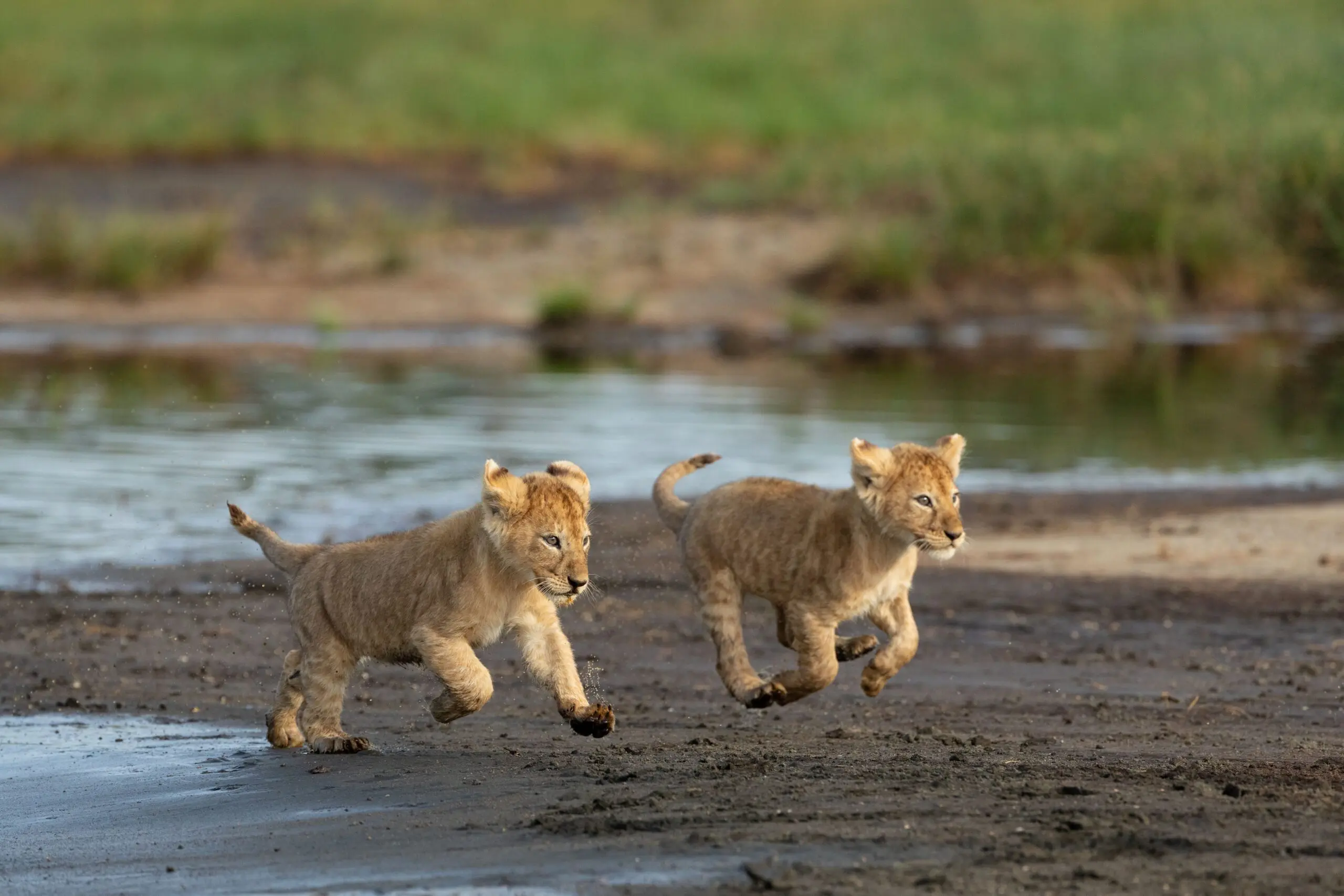
Itinerary summary
Day 01 – Start of program | Arusha/Lake Manyara
Day 02 – Game drive in Lake Manyara NP
Day 03 – Game drive in Tarangire NP
Day 04 – Relax day
Day 05 – Road trip & afternoon game drive at Lake Ndutu
Day 06 – Game drive in Serengeti NP
Day 07 – Game drive in Serengeti NP
Day 08 – Game drive in Pololeti GR
Day 09 – Game drive in Serengeti NP
Day 10 – Hiking safari during sunset
Day 11 – Game drive in Serengeti NP
Day 12 – Game drive in the Ngorongoro Crater
Day 13 – Transfer to Arusha, Arusha Airport or Kilimanjaro Airport
Day 1 | Begin your safari adventure at Africa Safari Lake Manyara
You will be picked up at the appointed time in Arusha, Arusha Airport or Kilimanjaro Airport by your private driver. Together you will board the safari jeep that will guide you through northern Tanzania for the next 13 days. After a 2 to 3 hour drive you will reach Africa Safari Lake Manyara, an accommodation on the shores of Lake Manyara, the perfect starting point for your safari. Zebras, wildebeests and monkeys roam freely on the property, while you can relax by the pool or in the bar.
Day 2 | Game drive in Lake Manyara National Park
The alarm clock rings, and a delicious breakfast awaits you in the restaurant overlooking Lake Manyara. After dinner, you board the safari jeep for your first game drive. Lake Manyara National Park, known for its tree-climbing lions, is nearby. Keep your eyes open, because in addition to the lazy lions in the trees, there are many other wild animals to see. After a picnic lunch, drive on to Lake Manyara itself, a large lake with bobbing hippos and graceful flamingos. At the end of the day, you will leave the park on the other side and spend the night at Africa Safari Rift Valley.
Day 3 | Game drive in Tarangire National Park
Today you will head to Tarangire National Park, where large herds of elephants roam the park. The great Tarangire River is the base of this beautiful nature reserve and many wild animals migrate here to quench their thirst. An ideal opportunity for you to see different species of animals at a glance. The many Baobab trees give the park a typical African look and after a full day of wildlife spotting you will return to Africa Safari Lake Manyara, which by now feels like coming home.
Day 4 | Relax day at Africa Safari Lake Manyara
Over the past three days you have gained many impressions and had a good first encounter with the wilderness of Northern Tanzania. So today it is time to relax and unwind. Whether you sleep in, take a refreshing swim or book an additional optional excursion. It is and always will be vacation and the African sun will certainly contribute to that.
Day 5 | Road trip to Lake Ndutu
Time to get back on the road and explore new landscapes of northern Tanzania. You leave Lake Manyara behind and continue your way through the Ngorongoro Conservation Area. Vast plains, large lakes and extraordinary landscapes. You will make a short stop at the crater rim, giving you a small taste of the game drive into the crater on day 12. The road continues and the landscape changes with it. You swap the Ngorongoro Conservation Area for the plains of the Serengeti. The new accommodation is in Southern Serengeti, against the border of Serengeti National Park and Lake Ndutu. In the afternoon you will go on a game drive at Lake Ndutu.
Day 6 | Game drive in Serengeti National Park
Today you will spend all day exploring Serengeti National Park in search of wildlife, including the Big Five. The diversity and abundance of animals make for a continuous adventure. Whether you experience a thrilling hunt, playful cubs, or a breathtaking sunset over the Serengeti plains, a game drive here offers an unforgettable journey into the heart of East Africa and the most fascinating show of nature. The day ends at Africa Safari Serengeti Ikoma, a wildlife accommodation where giraffes, zebras and other animals often pass by.
Day 7 | Game drive in Serengeti National Park from Central to North
Wake up to the first rays of sunshine in your tent and enjoy the view from your veranda over the vast nature reserve. Prepare for a scenic drive through Serengeti National Park, where you will travel from Central to Northern Serengeti. This journey reveals the park's remarkable diversity. You'll leave the scenic, acacia-strewn plains and iconic headlands of central Serengeti and head north, into a landscape of lush riverine forests and rolling hills. The northern Serengeti is known for river crossings during the Great Migration, where wildebeest and zebra brave crocodiles. Here the landscape is a haven for predators, with lions and cheetahs in action. The northern Serengeti offers another facet of this extraordinary ecosystem, making it an essential destination for a complete Serengeti experience.
Day 8 | Game drive in Pololeti Game Reserve
You stayed overnight in a traditional Maasai Boma, with inside the luxury and comfort you appreciate on vacation. This region is still very rich in this traditional Maasai culture of which Tanzania is very proud. After a delicious breakfast overlooking the hilly landscape with Kenya in the background, it is time to get back into the safari jeep. Today you will go on game drive in Pololeti Game Reserve. This area is also called the hidden gem of Northern Tanzania, as few people visit this area. A shame, because the nature is beautiful and rich in many wildlife species. Chances are you won't meet anyone else and the driver will tell you a lot of interesting facts about the flora and fauna of this area.
Day 9 | From North to Central Serengeti National Park
After saying goodbye to the Maasai Boma, you will go on another game drive in Serengeti National Park. Today you will travel from the northern reaches to the center of the park. From the northern boundary you will experience vast savannahs and open grasslands with an abundance of wildlife, including the "Big Five." As you head south into the central part of the park, the landscape becomes more varied, with acacia plains and scattered kopjes (rock formations). Here the annual Great Migration of millions of wildebeest, zebra and gazelle crossing the Mara River, attracting predators such as lions and crocodiles, is a highlight. The central Serengeti is a wildlife lover's paradise, offering unforgettable encounters with Africa's most magnificent animals in their natural habitat. You will stay overnight at Africa Safari Serengeti Ikoma, with a backyard full of wildlife.
Day 10 | Hiking safari during sunset
Wake up to the morning sun illuminating your tent and enjoy the view from your veranda. Giraffes, wildebeests and zebras pass by as you quietly start your day. Have breakfast and lunch at the restaurant, perfect for taking photos. In the afternoon you will go on a sunset walking safari on foot in Ikona Wildlife Management Area. This magical experience brings you closer to the African wilderness. As the sun sets, explore the savanna with a guide and experience the sounds and details of the ecosystem. It is a serene and meaningful way to experience Tanzania and its people, with the warm glow of the setting sun for an unforgettable safari experience.
Day 11 | Game drive from Central to South Serengeti National Park
On your last day in Serengeti National Park, you'll travel south to Lake Ndutu, an area that becomes a lush oasis during the rainy season and attracts lots of wildlife, including wildebeest and zebra during the Great Migration. Here you can see predators in action, such as lions and cheetahs. Lake Ndutu is also known for its rich bird life, making it a paradise for bird lovers. This trip offers the chance to experience the beautiful wildlife of Serengeti's southern reaches, a fascinating part of the park's larger ecosystem. Overnight at Africa Safari South Serengeti.
Day 12 | Game drive in the Ngorongoro Crater
Wake up to the natural sounds of singing birds and forests. You might see another elephant before you have breakfast. Pack your gear and head out for a special day in the world-famous Ngorongoro Crater. A game drive here is an incredible experience with a high concentration of wildlife. Explore the natural amphitheater and meet the Big Five and other animals in breathtaking surroundings. End the day with an overnight stay in charming Karatu, where Africa Safari Karatu offers stunning views atop a hill.
Day 13 | Road trip to Arusha
On the last day of your safari adventure, after breakfast, take a road trip to Arusha with your private driver. This scenic journey from Karatu to Arusha showcases the beauty of the Tanzanian landscape. Along the way, you'll pass local villages and get a glimpse of everyday life in Tanzania. As you approach Arusha, you will feel the vibrant energy of the city. Here ends your 13-day safari trip, and you have gathered precious memories for life.
Africa Safari Manyara Escarpment
Where nature and the most beautiful views meet
Located on the outskirts of Mto wa Mbu on the back of Rift Valley, Africa Safari Manyara Escarpment offers a breathtaking stay where nature meets comfort. Wake up to the soothing sounds of a nearby river, enjoy panoramic views of the vast landscape from the public areas, and immerse yourself in an authentic safari experience just minutes from Lake Manyara National Park.
With a variety of Comfort, Luxury Glamping, Premium Glamping, and family tents, every guest is treated to a great stay. The property features a restaurant, bar, spa, boutique, fitness and infinity pool, all of which blend seamlessly into the surrounding wilderness.
Highlights
- Breathtaking accommodation on the back of Rift Valley
- Safari tents with luxurious comfort
- Near Africa’s best safari areas
- Unique location & extraordinary views
- Located between the most famous National Parks
- Ideal for birdwatchers and nature lovers
- WIFI and a pool with grandiose views
Africa Safari South Serengeti
Surrounded by elephants
Africa Safari South Serengeti is a comfortable accommodation in nature, surrounded by elephants, giraffes, antelopes and many other wildlife species. Located in the Ngorongoro Conservation Area, it offers easy access to both Ngorongoro Crater and Serengeti National Park.
Highlights of this property include the calf season of the Great Migration in January and February. Thousands of wildebeest give birth here, after which they continue their migration through Serengeti National Park. Wildlife abounds throughout the year, including predators such as lions, leopards, cheetahs and hyenas.
Highlights
- In the middle of nature where wildlife passes by
- Close to where millions of wildebeest will calve
- Ideal location between the Ngorongoro Crater and Serengeti NP
- Luxury safari tents with desired comfort
- Cozy restaurant with WiFi and the tastiest dishes
- Waking up to birdsong
Africa Safari Serengeti Ikoma
A backyard full of wildlife
In the middle of the Serengeti Ecosystem grass plains lies Africa Safari Serengeti Ikoma, a unique safari accommodation just 300 meters from Serengeti National Park. This accommodation offers stunning views of wildlife roaming freely, and it is an ideal stopover for exploring the Serengeti.
The spacious tents range from cozy double tents to safari comfort tents with permanent bathrooms. Both with grandiose views over the grassy plains of Serengeti and Ikona. The surrounding area, including the Grumeti River, offers plenty of wildlife, including the Great Migration in certain months. You can also take a bushwalk and night game drive with a TAWA ranger in the nearby Ikona Game Controlled Area, a hidden treasure for wildlife enthusiasts.
Highlights
- An accommodation where wildlife loves to linger
- Comfortable tents with veranda overlooking the grassy plains
- A lovely pool overlooking the wilderness
- Large restaurant with a cozy safari bar
- A campfire under the stars
- Close to the entrance Serengeti National Park
Africa Safari Maasai Boma
Meet the traditional culture
At Africa Safari Maasai Boma you can stay in traditional round terracotta huts with thatched roofs, surrounded by stunning views of verdant landscapes and the Maasai Mara in Kenya. This unique accommodation is ideally located for a safari in northern Tanzania, with Lake Natron to the east, Serengeti National Park to the west, and Ngorongoro to the south. Here you will be introduced to Maasai culture and the traditional building style of the bungalows and huts, inspired by a Maasai boma.
Located just 15 minutes from Serengeti’s Klein’s Gate, Africa Safari Maasai Boma offers game drives to the famous river crossing during the Great Migration and outstanding wildlife viewing in the area, including the Pololeti Game Reserve. It is a must-visit during your tour of northern Tanzania.
Highlights
- Breathtaking location against the Kenyan border
- The only affordable accommodation in the area
- Perfect place to stay between Serengeti and Lake Natron
- Inspired by traditional Maasai culture
- Located next to Pololeti Game Reserve
- A lovely pool with great views
Africa Safari Karatu
Green hills and beautiful views
Africa Safari Karatu is a luxury safari lodge on the edge of the Ngorongoro Conservation Area, opening in July 2023. The area is known for its cool climate, green hills and stunning views, once loved by settlers and farmers for coffee bean plantations. The lodge sits atop a hill and offers panoramic views of the Northern Highlands, Lake Eyasi and surroundings.
From Africa Safari Karatu, Lake Manyara National Park and the Ngorongoro Crater are easily accessible. The lodge has Safari Comfort Bungalows and Safari Luxury Bungalows, with the Luxury Bungalows offering extra space and a comfortable sofa in the sitting area. All bungalows have private balconies with stunning 180-degree views. The restaurant, bar and swimming pool add to the feeling of home, while the stunning views of the Northern Highlands and Lake Eyasi provide the ideal relaxation before or after your safari.
Highlights
- Breathtaking views of the hills of the Ngorongoro area
- Close to the entrance of Ngorongoro Crater
- Great to combine with Lake Manyara National Park
- Perfect stopover between Arusha and Serengeti National Park
- A lovely swimming pool with views and other facilities
- Various day activities to explore the area
- Brand new and opening in 2023
- Spectacular nature and on the outskirts of Karatu the town
Africa Safari Rift Valley
Gets its name from the famous Rift Valley
Africa Safari Rift Valley is located in the village of Mayoka, on the south side of Lake Manyara with the famous Great Rift Valley as its setting. It is the perfect location to relax before or after visiting Tanzania’s northern national parks, conveniently located between Tarangire and Lake Manyara. Africa Safari Rift Valley is off the beaten path. The pool and restaurant is embedded in the surrounding landscape and offers stunning views of the Rift Valley and Lake Manyara. The southern entrance to Lake Manyara National Park, Iyambi Gate, is a short distance away. This national park has a variety of wildlife, including the famous tree-climbing lions.
Lake Manyara National Park is a haven for hippos, giraffes, impalas and zebras. The west end of Tarangire National Park, Sangaiwe Gate, is less than an hour’s drive away. Tarangire National Park is known for its large number of picturesque baobab trees and is home to the largest population of elephants in northern Tanzania. Tanzania is the third-largest sugar producer in East Africa. Just a 30-minute drive from Africa Safari Rift Valley you will find the Manyara Sugar Factory, one of the factories that contribute to the production of sugar.
Highlights
- Brand new and opens in December 2023
- Breathtaking views of the Great Rift Valley
- Secluded and quiet allowing you to relax
- Eat at a good restaurant overlooking Lake Manyara
- Perfect location close to Lake Manyara National Park
- This property is open year round
Tarangire National Park
Marching herds of elephants
Tarangire National Park is a fun and impressive wildlife park! On the way from Arusha to Lake Manyara you will pass this beautiful wildlife park, which is known for its large groups of elephants and ancient Baobab trees. There is plenty of wildlife to see, as a large river flows through it and the terrain is open.
In the dry season, the Tarangire River is the only permanent source of water for all wildlife and thus the place to easily spot wildlife. Tarangire National Park is 2850 square kilometers, making it the sixth largest park in Tanzania. After Serengeti National Park it offers the highest concentration of wildlife. Tarangire is known for its Baobab trees. Their impressive, thick trunks store water and provide a source of food and shade for many animal species. These iconic trees are not only a natural treasure, but also a symbol of the beauty and resilience of the African wilderness.
Wildlife you can spot:
Wildebeest | Zebras | Buffalo | Gazelles | Rhinos | Warthogs | Impalas | Pythons | Lions | Leopards | Nearly 500 bird species
Wildlife of the Tarangire National Park
Tarangire National Park in Tanzania is known for its abundance of wildlife and as wonderful safari experiences. Here you can see huge elephants roaming in large herds, feasting on the succulent vegetation. The park is also home to troops of baboons playfully swinging through the trees, leopards lurking in the shade, lions dominating the savannah and countless giraffes walking elegantly along the horizon. With its rich and varied wildlife, Tarangire NP offers an unforgettable adventure for nature and safari lovers.
Practical information
Location: Tarangire National Park is located in northern Tanzania, about 120 kilometers southeast of the city of Arusha.
Entrance fee: The entrance fee may vary depending on your age and period of your visit. This entrance fee (park fee) is always included in our tours.
Best time to visit: The dry period December to April and June to October are the best times to visit Tarangire, as wildlife gathers near the Tarangire River, giving you excellent opportunities to spot animals. However, the park is good to visit all year round, with many chances to spot wildlife.
Climate: The climate in Tarangire is generally hot and dry, with higher temperatures during the dry season.
Lake Manyara National Park
Tree-climbing lions in Lake Manyara
Lake Manyara National Park is an underrated gem when it comes to safari parks in Tanzania. This park offers great ecological diversity in a compact area. The lake attracts many birds that thrive on the water. More than 400 species have been identified and one of the highlights are the thousands of flamingos.
From the park’s main entrance, the road winds through an area of pristine forest. On the grassy shores of the lake you can see wildebeest, giraffes, zebras and the great buffalo grazing throughout the day. The park also offers excellent opportunities to spot hippos. The mahogany and acacia trees are inhabited by the famous tree-climbing lions. With a little luck, you can see them lazing on a tree branch!
Wildlife you can spot:
Elephants | Lions | Leopards | Giraffes | Baboons | Waterbucks | Impalas | Warthogs | Hippos | Crocodiles | Bushbucks | Dikdiks | Wildebeest | Zebras | Hyenas | Flamingos | Pelicans | Ospreys
Wildlife in Lake Manyara National Park
Lake Manyara National Park, located in Tanzania, is known for its diverse and abundant wildlife. The park is home to numerous animal species, including elephants, lions, leopards, giraffes and baboons. One of the park’s most striking features is the presence of tree-climbing lions that often nest in the acacia trees.
In addition to large mammals, Lake Manyara NP also offers a paradise for bird lovers, with more than 400 species of birds, including flamingos, pelicans and ospreys found along the shores of the beautiful lake. The diversity of wildlife and the scenic beauty of the lake make a visit to Lake Manyara National Park an unforgettable experience for nature and safari enthusiasts.
Practical information
Location: Lake Manyara National Park is located in the northern region of Tanzania, about 126 kilometers southwest of Arusha.
Entrance fee: The entrance fee may vary depending on your age and period of your visit. This entrance fee (Park fee) is always included in our tours.
Best time to visit: The dry period December to April and June to October are generally the best periods for wildlife safaris, as animals tend to gather at water sources. However, the park is good to visit all year round, with many chances of spotting wildlife.
Climate: The climate in this area is generally hot and humid, but temperatures can vary depending on the season.
Lake Ndutu
The heart of the calf season
The southeastern part of the Serengeti, the Ndutu area, is rich in wildlife year-round. Numbers peak between December and April. Huge herds of wildebeest and zebra, from the Great Migration, are attracted by the fresh grass and seasonal rains. During this period, this area is the best place to view game on the plains around Lake Ndutu, where the herds of wildebeest are concentrated.
Most calves are born in January and February, about 8,000 a day. The short grassy plains offer them some safety, as predators can be spotted more easily. But as it goes in nature, these young wildebeest attract many hungry predators, such as lions, cheetahs, leopards and hyenas. Other species, such as gazelles and zebras, also give birth in this area and use the wildebeest calves as cover to divert attention from their own young. The area is also suitable for birdwatchers. The Thorny Tree forests are the habitat of even more birds, and if you pay close attention, you might see the fantastically colored Fischer’s Lovebird.
Wildlife you can spot:
Elephants | Lions | Leopards | Giraffes | Baboons | Waterbucks | Impalas | Warthogs | Hippos | Crocodiles | Bushbucks | Dikdiks | Wildebeest | Zebras | Hyenas | Flamingos | Pelicans | Ospreys
Practical information
Location: The Lake Ndutu area is located in the southern region of the Serengeti ecosystem in Tanzania, near the Ngorongoro Crater.
Entrance fee: The entrance fee may vary depending on your age and period of your visit. This entrance fee (Park fee) is always included in our tours.
Best time to visit: The best time to visit the Lake Ndutu area is during the green season (December to May) when thousands of wildebeest and zebra migrate to the area to calve. This provides unique opportunities for wildlife spotting. However, there is plenty of wildlife to spot in this area all year round.
Climate: The climate in this area can vary widely, from hot and dry to rainy and cool, depending on the season.
Pololeti Game Reserve
The hidden gem of northern Tanzania
The Pololeti Game Reserve is part of the Loliondo Game Controlled Area, now under the NCAA (Ngorongoro Conservation Area Authority). An important area for wildebeest and an intermediate area for animals from Serengeti NP. Because wildlife knows no boundaries, you will find a wide variety of wildlife here, including hunting lions, roaming elephants, grazing buffalo, running antelope and more.
Pololeti Game Reserve is a vast and beautiful nature reserve and is known for its pristine natural beauty and diverse wildlife populations. This area includes a wide range of ecosystems, including savannahs, forests and wetlands, which provide habitat for a rich variety of animals.
The game reserve is home to the iconic Big Five, including lions, elephants, leopards, buffalo and rhinos. It is also a haven for many other animal species, including giraffes, zebras, cheetahs and numerous bird species. The region offers exceptional safari experiences, with opportunities for game drives, guided walks and cultural encounters with local Maasai communities.
With a visit to this area, you’ll be treated to a truly authentic safari adventure, away from the crowds, where the focus is on conserving the remarkable wildlife and preserving the pristine natural environment.
Wildlife you can spot:
Lions | Elephants | Leopards | Buffalo | Rhinos | Giraffes | Zebras | Wildebeests | Cheetahs | Hyenas | Elk | Gazelles | Impalas | Crocodiles | Hippos | Dikdiks | Numerous bird species | Meerkats
Practical information
Location: Pololeti Game Reserve is located in northern Tanzania, against the Kenyan border, on the border with Northern Serengeti National Park (Kleins gate).
Entrance fee: The entrance fee may vary depending on your age and period of your visit. This entrance fee (Park fee) is always included in our tours.
Best time to visit: The dry period December to April and June to October are generally the best periods for wildlife safaris, as animals tend to gather at water sources. However, the park is good to visit all year round, with many chances of spotting wildlife.
Climate: The climate can vary, but generally it is warm during the day and cool at night.
Serengeti National Park
From vast plains to rocky ‘kopjes’
With vast open plains stretching to the horizon and an abundance of wildlife, Serengeti National Park crowns itself a true paradise for any safari enthusiast. Hence, we recommend that you set aside several days for this.
Serengeti National Park covers an impressive area of nearly 15,000 square kilometers and is rightly the largest and perhaps most popular national park in Tanzania’s northern circuit and perhaps in all of Africa.
The Serengeti is known worldwide as host to the Great Migration and many big cats such as lions, cheetahs and cheetahs. However, elephants, giraffes, hippos, crocodiles, buffalo and impala are also common residents here. This area is extremely popular because of the high probability of witnessing a hunting party of these predators. The landscape in northern Serengeti NP is characterized by “kopjes,” rocky granite formations that are more than 550 million years old and often serve as lookouts for these feline hunters during their search for prey.
Wildlife you can spot:
Wildebeests | Zebras | Thomson’s gazelles | Lions | Cheetahs | Cheetahs | Cheetahs | Cheetahs | Elephants | Giraffes | Hippos | Crocodiles | Buffalo | Impalas | Hyenas | Rhinos | Warthogs | Waterbucks | Vultures | Baboons | Mongoose | Aardvarks | Serval Cats | Meerkats
The Great Trek of the Serengeti National Park
This is a natural spectacle that many people like to see during their safari trip in Tanzania. One of the highlights in Serengeti NP, but also one of the most difficult to spot. Every year, the six million wildebeest, and thousands of zebras and gazelles migrate through Serengeti National Park in search of fresh grass and water.
Seasonally, we know approximately where the Great Migration is located, but never exactly. This is due to many natural factors, which makes seeing the Great Migration very unique. Our drivers/guides always do their best to locate the Great Migration.
- January/February | Calf season in Southern Serengeti / Ndutu area
- March/April | From south to central Serengeti NP via the west side
- June/July | From central to north Serengeti NP
- August to October | The river crossing in Northern Serengeti NP
- November/December | From north to south Serengeti NP via the east side
Practical information
Location: Serengeti National Park is located in northern Tanzania and extends into southwestern Kenya. It is one of the most famous game reserves in Africa.
Entrance fee: The entrance fee may vary depending on your age and period of your visit. This entrance fee (park fee) is always included in our tours.
Best time to visit: The Serengeti is known for the annual migration of wildebeest and zebra, culminating in the river crossing (North) in August/September and the calf season (South) in January/February. This is an excellent time to visit the park. However, Serengeti National Park is beautiful all year round and very good for wildlife spotting.
Climate: The climate in the Serengeti can vary, but it is generally warm during the day and cool at night.
Ngorongoro Crater
World’s largest volcanic crater
Nothing can prepare you for the breathtaking beauty of Ngorongoro Crater. As you stand at the viewpoint and contemplate the Crater, you see the clouds drifting away around the crater rim and feel a cool, mountainous breeze. Mother Nature at her best. The Ngorongoro Crater is a UNESCO World Heritage Site and the world’s largest volcanic crater that has dried up and created a whole new ecosystem. It is also called the 8th wonder of the world.
With its lush green grasslands, shimmering lakes and meandering rivers, the crater is home to many wild animals, including the Big Five (lions, elephants, buffalo, leopards and rhinos). It is also an essential resting place for migrating birds. In short, Ngorongoro Crater is an enchanting piece of nature that will surprise you with its unparalleled beauty and biodiversity.
Wildlife you can spot:
Lions | Leopards | Black Rhinos | Elephants | Buffalo | Zebras | Wildebeest | Waterbucks | Impalas | Hippos | Hyenas | Flamingos | Birds of Prey
Wildlife of Ngorongoro Crater
Ngorongoro Crater is home to an impressive variety of wildlife, making it one of the most remarkable wildlife sanctuaries in the world. In this natural amphitheater-like setting, you can witness powerful lions guarding their territory, elegant leopards deftly prowling through the grass, imposing black rhinos, herds of grazing buffalo and robust elephants strolling peacefully.
It is a place where the Big Five converge and where countless other animals, including zebras, giraffes, hippos and numerous bird species, also thrive. A safari in the Ngorongoro Crater is an unforgettable opportunity to come face to face with the magnificent animals that call this unique landscape home. Ngorongoro Crater is an absolute must-see on any tour of northern Tanzania.
Practical information
Location: Ngorongoro Crater is located in northern Tanzania, near the Serengeti National Park.
Entrance fee: There is an entrance fee to enter the Ngorongoro Conservation Area, of which the crater is a part, plus an entrance fee to enter the crater by safari jeep. These entrance fees (park fees) are always included in our trips.
Best time to visit: Ngorongoro Crater is accessible year-round with many chances of spotting wildlife.
Climate: The climate in Ngorongoro Crater can vary, but it is generally cooler than in the surrounding areas because of the altitude.
Kilimanjaro National Park
Kilimanjaro National Park: discover the roof of Africa
Mount Kilimanjaro is the highest mountain in Africa and a real eye-catcher of Tanzania. The densely forested base of the mountain slowly turns into grassy plains and rocky outcrops. Only to end with a summit covered in “eternal snow. You can see this snow-capped mountain peak from afar, provided it is not cloudy! This typical Tanzanian landscape with Kilimanjaro included, invites you to stop for a moment during your drive to the first accommodation or on the way back to the airport.
This free-standing mountain, which is also the highest free-standing mountain in the world, is part of Kilimanjaro National Park and a UNESCO World Heritage Site. The area offers beautiful hiking trails. From impressive hikes to imposing waterfalls to multi-day treks to the summit located at 5,895 meters. The base of Kilimanjaro has many coffee plantations, where you can get educational tours. Of course with a delicious fresh cup of coffee at the end.
Experiencing Kilimanjaro without summit ambitions
For travelers who prefer to keep both feet on the ground, there are several ways to experience the beauty of Kilimanjaro up close.
One of the most popular options is a day trip to Mount Kilimanjaro. You take a day hike to Mandara Hut via the Marangu Route. This trek takes you through cloud forest and bamboo forests, past tropical wildlife and monkeys. With no risk of altitude sickness, you will enjoy a fantastic introduction to the mountain landscape here. You walk up to about 2,700 meters altitude and return after lunch. This day hike is perfect for those who want to be active but are not looking for a multi-day trek.
Prefer a cultural experience? Then opt for a combination of the Materuni waterfall and a traditional coffee tour. After a short walk through the forest, you will be rewarded with a view of an impressive waterfall. Afterwards, you will visit a Chagga family who will tell you all about growing, roasting and brewing local Arabica coffee.
You can also experience Kilimanjaro by 4×4. The drive to the Shira Plateau takes you to an altitude of about 3,500 meters without too much effort. Here a panorama of the national park awaits, a unique place for a picnic or photo stop if you ask us.
For relaxation after an active day, a visit to the Kikuletwa hot springs is highly recommended. The warm, clear water offers a wonderful contrast to the fresh mountain air of the Kilimanjaro region.
For those who want to climb: routes and tips
Climbing Mount Kilimanjaro, Africa’s highest mountain, is an epic adventure that attracts adventurers from all over the world. This majestic mountain, rises to a height of 5,895 meters above sea level and offers a unique opportunity to traverse diverse climatic zones, from tropical rainforests to alpine deserts.
Kilimanjaro is not a technical climb and requires no mountaineering experience, but it is a physical and mental challenge. You will be rewarded with breathtaking views and a sense of accomplishment when you reach the summit, called Uhuru Peak. Along the way, you will pass through a stunning variety of landscapes and ecosystems and have the chance to enjoy the rich flora and fauna of Kilimanjaro National Park.
Climbing Kilimanjaro is an unforgettable adventure that is a true bucket list experience for beginners and experienced mountaineers alike. It is a journey that tests not only the physical strength but also the determination and perseverance of those trying to reach the summit.
Combine Kilimanjaro with your tour
Thanks to its location close to Kilimanjaro International Airport, a visit to the national park is ideal as the start or end of your safari. Many of our travelers opt for a day hike on the day of arrival, or just as a rest before the return flight. The coffee tour or hot springs are also easy to combine with our accommodations in the region.
At Paradise & Wilderness we take the organization out of your hands, so you only have to focus on enjoying yourself. So ask us about the possibilities to make your visit to Kilimanjaro as suitable as possible.
Frequently Asked Questions
Is climbing Kilimanjaro dangerous?
Not if you are well prepared. The climb is physically challenging, but not technical. With proper guidance and acclimatization, it is achievable for many people.
Is it possible to hike Kilimanjaro in one day?
Yes, you can explore part of Kilimanjaro on a day trip. You then walk up to a certain point on the mountain, depending on your route and fitness level. Reaching the summit in one day is not possible (and medically irresponsible), but you will experience the magic of the mountain.
Can I visit Kilimanjaro even with a fear of heights?
Sure. Day trips stay below 3,000 meters and have no steep precipices. You decide how far you go.
What is the lightest activity around Kilimanjaro?
A coffee tour or a drive to the hot springs is low-key and cultural, ideal for families or those seeking peace and quiet.
Are day trips suitable for children?
Yes, especially the waterfall and coffee tours are great for young travelers.
What do I take with me on a day trip?
Sturdy shoes, a daypack with a small first aid kit, sunscreen, raincoat, food, at least 1.5 liters of water and your camera. A walking stick may also be nice. We provide a professional guide.
How hard is the hike physically? Do I need to be fit?
You don’t have to be an athlete, but a reasonable basic level of fitness is important. You will be walking for hours uphill and at altitude, which can be tiring. With enough rest and a leisurely pace, it is doable for active travelers.
Will I get a guide during the day trip?
Yes, a certified guide is mandatory on every trek on Kilimanjaro. He or she will accompany you, explain nature and ensure your safety.
What are the chances of fog, rain or cold?
The weather can change quickly. It is often clear in the morning, but fog or rain sets in in the afternoon. It can get chilly, so dress in layers.
Other excursions near Kilimanjaro
Want to extend your visit to Kilimanjaro National Park with other special activities in the region? Paradise & Wilderness offers several day trips that combine well:
- Materuni Waterfall & Coffee Tour.
A guided hike to the impressive Materuni Waterfall, followed by a traditional coffee tour with a Chagga family. - Kikuletwa Hotsprings.
Relax in natural hot springs, also known as Chemka Springs, surrounded by tropical greenery. - Hike at Lake Duluti
A peaceful forest and canoe hike around the atmospheric crater lake near Arusha, easily accessible from the Kilimanjaro region. - Canoeing on Lake Duluti
For those who prefer to go out on the water alone: a calm canoeing experience in a unique natural setting.
Wondering what best suits your trip? Check out all our excursions and easily put together your ideal day program.
Plan your trip to Kilimanjaro National Park
Want to experience Kilimanjaro without worries? Opt for a fully arranged day trip through Paradise & Wilderness. Let us know what you’re looking for (active, cultural or relaxing) and we’ll take care of the rest.
Practical information
Location: Kilimanjaro National Park is located in northern Tanzania and includes the majestic Mount Kilimanjaro, Africa’s highest mountain.
Entrance fee: The entrance fee to Kilimanjaro National Park varies depending on the route you choose to climb the mountain and the duration of your climb. Costs also include permit and guide fees. All entrance fees and charges (Park fee) are included in our trips.
Best time to climb: The best time to climb Kilimanjaro is during the dry seasons, which run from January to March and from June to October. These periods offer the most favorable weather conditions for climbing.
Climbing routes: There are several routes to climb Kilimanjaro, varying in difficulty and duration. Popular routes include the Machame route, the Marangu route and the Lemosho route. Each route has its own characteristics and requirements.
Climate: The climate on Kilimanjaro varies greatly with altitude. It can range from tropical at the base of the mountain to arctic at the summit. Make sure you have appropriate clothing to keep yourself warm and dry.
Health and Safety: Climbing Kilimanjaro can be physically challenging. It is important to seek medical advice and be in good physical condition before embarking on the trek. Altitude sickness is a real risk, so it is important to acclimate and hydrate adequately.
Prices
| Number of persons | Low season | Mid season | High season |
|---|---|---|---|
| 2 persons | € 4.081,- | € 4.081,- | € 4.081,- |
| 4 persons | € 3.298,- | € 3.298,- | € 3.298,- |
| 6 persons | € 3.037,- | € 3.037,- | € 3.037,- |
| Otherwise | On request | ||
Includes
- Accommodations according to daily program
- Full board care
- Water in the safari jeep
- Pick-up & Drop-off at the airport or in Arusha
- Park fees for the national parks described
- WMA + GCA Concession/Conservation fees
- African 4×4 safari jeep with pop-up roof and large windows
- English-speaking private driver/guide
- Game drives & excursions as per daily program
- Booking fee
Excluding
- International flights
- Visa
- Insurance
- Drinks
- $2.50 p.p.p.n. Tourism Development Levy and Village fee
- Contribution SGR à €5 p.p.
- Contribution Calamity Fund at €2,50 per booking of max. 9 persons
- All items of a personal nature
- Anything not mentioned in the itinerary
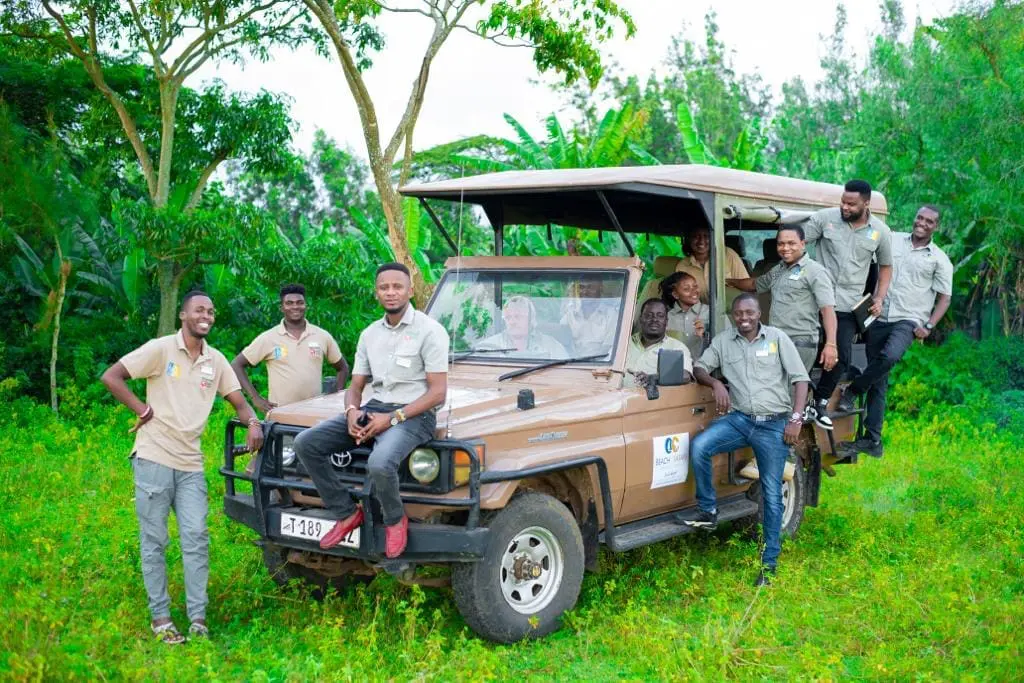
Safari Jeep
During this safari tour, you will travel around in a 4×4 safari jeep with pop-up roof. This, with four-wheel drive, safari jeep is perfect for taking photos. The vehicles have low emissions, so make less noise. This allows you to get quite close to the wild animals without disturbing or scaring them off.
The safari jeeps are well maintained and have comfortable seats and a cooler for cold water. Our English-speaking driver/guide has extensive knowledge of flora and fauna. He makes sure you get to see the best of the national parks. He will give you as much time as you need to ask questions, take pictures and enjoy the beautiful scenery.
Distances on Tanzania and Zanzibar
The vast expanse of Tanzania and Zanzibar ensures that your safari trip will include a wide range of travel distances. Not only do these road trips reveal the country's magnificent nature, but they also provide an excellent opportunity to learn about its diverse ecosystems, cultures and landscapes. From the vast plains of the Serengeti National Park to the majestic peaks of Kilimanjaro and the endless expanses of pearly white sand beaches in Zanzibar. The diversity of Tanzania & Zanzibar invites you to explore.
View distances| From | To | Duration |
|---|---|---|
| Kilimanjaro Airport | Africa Safari Arusha | +/- 1.5 hour |
| Kilimanjaro Airport | Africa Safari Manyara Escarpment | +/- 3.5 hour |
| Kilimanjaro Airport | Africa Safari Rift Valley | +/- 3.5 hour |
| Arusha Airport | Africa Safari Lake Manyara | +/- 2 hours |
| Arusha Airport | Tarangire National Park | +/- 2.5 hour |
| Africa Safari Arusha | Arusha Airport | +/- 20 min |
| Africa Safari Arusha | Arusha National Park | +/- 1 hour |
| Africa Safari Arusha | Lake Manyara National Park | +/- 2 hours |
| Africa Safari Arusha | Lake Natron | +/- 6 hours |
| Africa Safari Arusha | Tarangire National Park | +/- 2 hours |
| Africa Safari Manyara Escarpment | Arusha National Park | +/- 2.5 hours |
| Africa Safari Manyara Escarpment | Lake Manyara National Park | +/- 10 min. |
| Africa Safari Manyara Escarpment | Lake Natron | +/- 3 hours |
| Africa Safari Manyara Escarpment | Ngorongoro Crater | +/- 1 hour |
| Africa Safari Manyara Escarpment | Serengeti National Park | +/- 5 hours |
| Africa Safari Manyara Escarpment | Tarangire National Park | +/- 50 min |
| Africa Safari Karatu | Africa Safari Arusha | +/- 3 hours |
| Africa Safari Karatu | Africa Safari Manyara Escarpment | +/- 45 min. |
| Africa Safari Karatu | Africa Safari Rift Valley | +/- 30 min. |
| Africa Safari Karatu | Lake Manyara National Park | +/- 45 min. |
| Africa Safari Karatu | Ngorongoro Crater | +/- 30 min. |
| Africa Safari Karatu | Tarangire National Park | +/- 2 hours |
| Africa Safari Rift Valley | Lake Manyara National Park | +/- 10 min. |
| Africa Safari Rift Valley | Tarangire National Park | +/- 50 min |
| Africa Safari Rift Valley | Ngorongoro Crater | +/- 1 hour |
| Africa Safari Rift Valley | Serengeti National Park | +/- 5 hours |
| Africa Safari Rift Valley | Arusha National Park | +/- 2 hours |
| Africa Safari Lake Natron | Lake Manyara / Africa Safari Manyara Escarpment | +/- 3 hours |
| Africa Safari Lake Natron | North Serengeti / Africa Safari Maasia Boma | +/- 4.5 hours |
| Africa Safari Lake Natron | Arusha / Arusha Airport | +/- 6 hours |
| Africa Safari Maasai Boma | Africa Safari Serengeti Ikoma | +/- 4 hours |
| Africa Safari Maasai Boma | Africa Safari South Serengeti / Ndutu | +/- 4 hours |
| Africa Safari Maasai Boma | Lake Natron / Africa Safari Lake Natron | +/- 4.5 hours |
| Africa Safari Serengeti Ikoma | Africa Safari Karatu | +/- 6 hours |
| Africa Safari Serengeti Ikoma | Seronera airstrip | +/- 15 min |
| Africa Safari Serengeti Ikoma | Ngorongoro Crater | +/- 3.5 hours |
| Africa Safari South Serengeti | Ngorongoro Crater | +/- 1.5 hour |
| Africa Safari South Serengeti | Africa Safari Serengeti Ikoma | +/- 3 hours |
| Africa Safari South Serengeti | Africa Safari Manyara Escarpment | +/- 2.5 hours |
| Africa Safari South Serengeti | Africa Safari Karatu | +/- 2 hours |
| Zanzibar Airport | Reef & Beach Resort | +/- 1.5 hour |
| Zanzibar Airport | Zanzibar Bay Resort / Paradise Beach Resort | +/- 45 min |
| Zanzibar Airport | Dream of Zanzibar | +/- 45 min |
| Zanzibar Airport | Shaba Boutique Hotel / Stone Town | +/- 15 min |
Round trips
Check out our inspiration trips to Tanzania and/or Zanzibar that can be customized.

